September 27, 2019
Handel's Aci, Galatea e Polifemo: laBarocca at Wigmore Hall
But, this wasn’t the first time that Handel had turned his attention to the Ovidian love-triangle between the mortal shepherd Acis, the sea-nymph Galatea and the Cyclops Polyphemus who, in a jealous rage, kills Acis, prompting Galatea to transform her beloved into an immortal river spirit. The allegorical tale was also the subject of the 1708 serenata Aci, Galatea e Polifemo which Handel composed in Naples in 1708 for Aurora Sanseverino, Duchess d’Laurenzana as a wedding gift for her nephew, Duke Tolomeo d’Alvito.
The intimate, decorous Wigmore Hall was a fitting setting for this performance by Roberta Mameli, Sonia Prina and Luigi De Donato with the Italian Baroque specialist ensemble, laBarocca, conducted by Ruben Jais. Founded in Milan in 2008, the sixteen-piece ensemble play with a light-textured vitality which here enhanced the delicacy and economy of many of Handel’s aria accompaniments, some of which employ continuo alone while others develop beautifully expressive duets between the solo voices and obbligato instruments. Jais decreed a prevailing gentleness which could then be dramatically enlivened by striking dynamic contrasts, occasional gritty textures and instrumental colour.
Handel’s serenata reveals not only the young composer’s confident appreciation of the requirements and expectations of the form, but also the considerable skill with which he could characterise in music. The role of the male lover, Aci, was written for a soprano castrato, as was the convention, with Galatea performed by a lower female voice. Here Roberta Mameli’s light, bright soprano was perfectly complemented by Sonia Prina’s dark, dense but pliable contralto. In their opening duet - which followed segue from an interpolated Sinfonia (Handel’s score provides no instrumental prelude) - Mameli’s brightness and ‘lift’ captured Aci’s optimism and joy as the day breaks and a serene sky seems to promise the lovers future joy, while Prina thoughtfully supported the higher line, shaping the phrases sensitively to convey Galatea’s passion.
Mameli and oboist Nicola Barbagli intertwined and echoed sublimely in ‘Che non può la gelosia’, their silky running triplets in thirds communicating the shepherd’s unrest when he first learns of Polifemo’s jealousy, strengthened by some thumbing bass line accents. When Aci prepares himself to do battle with the Cyclops, Handel surprising scores his aria for ‘solo cembalo’, even though librettist Nicola Guiva has supplied him with images of eagles’ talons ripping into a snake’s nest inspiring violent and venomous vengeance in the latter. Perhaps he wished us to foreground such imagery without distraction? Here, Jais employed the harpsichord alone but, as Mameli projected forcefully (sometimes a little too much so, with adverse effect on the intonation) the relationship between the voice and the rather fragile, rapid harpsichord part became loosened.
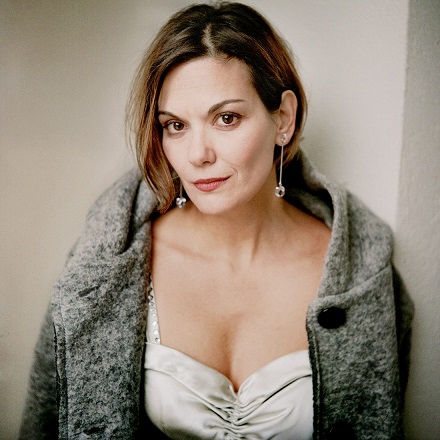 Roberta Mameli (soprano). Image courtesy of Allegorica opera management.
Roberta Mameli (soprano). Image courtesy of Allegorica opera management.
More successful, and considerably moving, was ‘Qui l’augel da pianta in pianta’ in which Aci reflects first on the carefree carolling of the birds which charms his heart, and then on the contrast between the birds’ happiness and his own grief. The preceding recitative closed with transfiguring gentleness as Aci asks the stars to allow him one more chance to gaze upon his beloved, whereupon he will die content. A weighty silence interposed before Barbagli’s oboe began its sweet song, inviting the shepherd to join in and charm his languishing heart. Here, Mameli employed a tender piano with affecting power and displayed superb accuracy in her avian lilting and trilling. The strings of laBarocca provided a bed of barely there tenderness for Aci’s final anguished ‘Verso già l’alma’, the harmonies softly and subtly altering, communicating the twists of grief in Aci’s heart as Mameli blanched her soprano to the merest, iciest thread.
I have more frequently heard Sonia Prina in roles which require her to rant and rage, which she does with dramatic potency and energy but with occasional mishaps as she leaps between registers and vents unbridled passion and anger. As Galatea she was able to display the more composed emotional depths which her rich contralto, with its velvety bottom and richly focused top, can convey. There was a lovely delicacy when the sea-nymph first tells Aci of the suffering that he must forebear, though strong resentment in the recitative in which she reveals Polifemo’s wrath and cruelty. The fury increased when Prina, arms crossed in indignation, launched into an agile ‘Benché tuoni e l’etra vvampi’ in which Galatea, allied with the oboe, envisions herself as a laurel tree, standing steadfast again the thunder’s fiery flashes as evoked by the dry spiky semiquavers of the strings. Surely few thunder gods would dare to challenge the steely insistence of Galatea’s closing avowal of invincibility, which Prina sustained long and darkly, while her final battle with Polifemo bristled with aggrieved energy and fury.
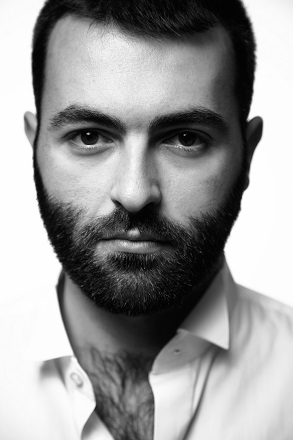 Luigi De Donato (bass). Image courtesy of Allegorica opera management.
Luigi De Donato (bass). Image courtesy of Allegorica opera management.
Heralded by a strident fanfare from trumpets and oboe, as Polifemo Luigi De Donato found a good balance between vocal refinement and the Cyclops’ crude clumsiness. De Donato’s diction was excellent, in the recitatives especially, where he used his firm and centre bass to bring the words to life. In his first aria, ‘Se schernito son io’, Polifemo may have been trembling with anger but the bass’s delivery was as authoritative as De Donato’s tall, imposing stance. ‘Fra l’ombra e gli orrori’ caught us unawares with its dark dignity, as Polifemo laments his loss once Galatea has thrown herself in the waves forever. De Donato cleanly negotiated the repeated, challenging leaps in the vocal line, with tight trills in the bass and muted strings signalling his heart-churning distress. The Cyclops has the last word of the drama, and Polifemo’s accompanied recitative of repentance was beautifully hushed.
Aci, Galatea e Polifemo possesses little of the mirth of Handel’s subsequent myth-telling mini-opera and - surprisingly for a work intended to be performed at a nuptial celebration - the tone becomes progressively more sombre and even severe. Jais was not entirely successful in sustaining momentum during a series of subdued and solemn numbers, and perhaps could have looked for greater emotional contrast.
The sudden shift at the close to the brisk moralising chorus was rather destabilising, the characters whom we have been encouraged to empathise briskly shedding their dramatic robes and revealing themselves as personified moral symbols in a philosophical debate. But, if the gruesome end which sees Aci felled by a boulder seemed inapt to the Neapolitan weddings guests in 1708 then they must have been reassured by the final confirmation: “Who loves well has aims of faithful love and pure constancy.”
A few patrons left the Hall before the close, perhaps not anticipating that a performance scheduled to last 90 minutes would over-run by almost a third. But, those who remained offered full-voiced praise to the singers and musicians for a performance that offered dramatic dignity and musical delights.
Claire Seymour
Handel: Aci, Galatea e Polifemo HWV7
Aci - Roberta Mameli (soprano), Galatea - Sonia Prina (contralto), Polifemo - Luigi De Donato (bass), Conductor - Ruben Jais, laBarocca
Wigmore Hall, London; Thursday 26th September 2019.
image=http://www.operatoday.com/Sonia%20Prina%20%40Javier%20Teatro%20Real.jpg image_description= product=yes product_title=Aci, Galatea e Polifemo: laBarocca, Wigmore Hall product_by=A review by Claire Seymour product_id=Above: Sonia Prina (contralto)Photo credit: Javier Teatro Real
Gerald Barry's The Intelligence Park at the ROH's Linbury Theatre
Currently showing at the Museum is a fantastic special exhibition, Two Last Nights! Show Business in Georgian Britain, which opens a window on the often riotous and raucous goings-on both front-of-house and behind-the-scenes in the eighteenth-century theatre and opera house, through exhibits such as fans printed with seating-plans to show where the great and good could be found, large illustrated tickets which are works of art in themselves, sharp contemporary cartoons and over-crowded playbills.
The latter are astonishing, showing the extent and diversity of the variety and vaudeville, sketches and song on offer each long evening of entertainment. A similar bill in the Burney Collection at the British Library gives the flavour: at the King’s Street Theatre in Bristol on the evening of 23rd August 1775, theatre-goers could enjoy Goldsmith’s She Stoops to Conquer, before which they were treated to a Prelude written by one George Colman Esq., while the play was followed by a ‘New Dance to which will be added A New Dramatic Entertainment, The Maid of the Oaks’, concluding with a Fête champêtre - illuminated with ‘near one thousand lamps’ original songs and choruses, a new minuet. The whole evening concluding with a dance. Preludes and after-pieces, divertissements and dances, comedies, dramatic romances, tragedies and farce frequently collided. Not surprising, Hogarth’s pen skewered both the artistes and the players, the aristocrats and the plebs.
I justify this rather diversionary preamble to my review of Music Theatre Wales’ production of The Intelligence Park at the ROH’s Linbury Theatre because Gerald Barry’s first opera resembles such a marathon Baroque bombardment. Both Hogarth and Handel, the latter whom Barry professes to admire, were fervent supporters of the Foundling Hospital Chapel - from 1749 Handel gave an annual benefit concert, raising thousands of pounds for the Hospital - and Barry channels Hogarth in his metatheatrical mash-up, though with little of the neoclassical wit and precision, tempered by soul-touching lyrical sentiment, that Stravinsky demonstrates in The Rake’s Progress. Instead Barry wields an iconoclastic sledgehammer, bludgeoning all connections between sound and syntax that might provide structural and semantic coherence … or, at least a semblance of comprehensibility.
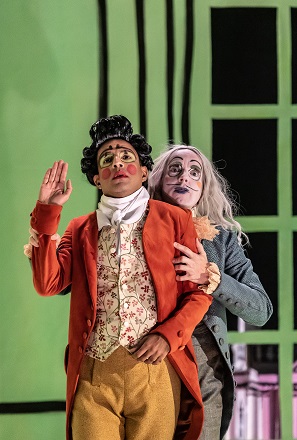 Michel de Souza as Paradies, Adrian Dwyer as D'Esperaudieu Photo credit: Clive Barda.
Michel de Souza as Paradies, Adrian Dwyer as D'Esperaudieu Photo credit: Clive Barda.
But, then, Barry’s not in the business of ‘coherence’. In the sleeve notes to the 2005 NMC recording of the first production of The Intelligence Park at the Almeida Theatre in July 1991 (which was broadcast on BBC Radio 3), Barry professes not to like ‘texts which are bound by logic or plot’, preferring instead those, such as that by his librettist Vincent Deane, characterised by ‘coolness and a bizarre artificiality which allow extreme careering at tangents’.
In fact, the essential plot and the ‘opera-about-opera’ paradigm of The Intelligence Park are pretty straightforward, it’s the idiom and execution which scramble reason and rationality. The time is 1753, the place Dublin. Robert Paradies has composer’s block and is struggling to complete his new opera. Marriage to his fiancée, Jerusha Cramer, will bring him her bombastic father’s money, and the leisure to devote himself to his art. But, he’s obsessed with the castrato Serafino, who is Jerusha’s singing teacher. Worse still teacher and pupil elope. The plus side is that Paradies infatuation fuels his musical inspiration; the downside is that Serafino and Jerusha transmute into Wattle and Daub who find their way into his opera. As real and imagined become inextricably tied up in creative and romantic knots, Paradies loses his grip.
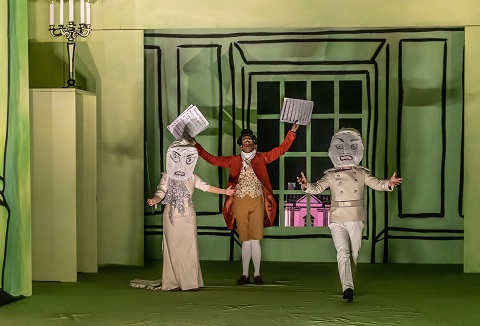 Photo credit: Clive Barda.
Photo credit: Clive Barda.
As a metareferential document of a creative crisis, The Intelligence Park is not, in theory, so different from Franz Schreker’s penultimate opera,Christophorus oder ‘Die Vision einer Oper’ ( St Christopher, or ‘The Vision of an Opera, 1924-29). Barry, though, sets out to destroy any conduit through which intelligibility might be communicated. The vocal lines deliberate disrupt syntax and meaning, through rhythmic fracture, elongation and hysterical stuttering, and through melodic and registral displacement and athletic angularity. The singers are required to essay vocal gymnastics, with the male roles leaping between falsetto and Hadean depths. If the word-setting is not so much arbitrary as deliberately anarchic, then the prevailing fortissimo wind-brass dominated accompaniment of punching patterns of repetitive staccatos obliterates the text in any case. In the Linbury Theatre I could detect scarcely a word of Deane’s 18th-century linguistic style-games, which are themselves intercut with splashes of Italian, and was forced to choose between gazing up at the oh-so-high surtitles to learn what was being said or looking at the stage itself to try to work out what was going on. Neither course of action produced a satisfying result.
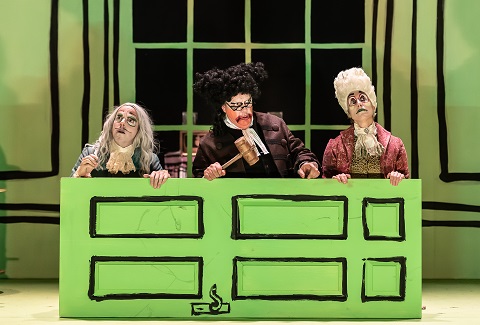 Adrian Dwyer as D'Esperaudieu, Stephen Richardson as Sir Joshua Cramer, Stephanie Marshall as Faranesi. Photo credit: Clive Barda.
Adrian Dwyer as D'Esperaudieu, Stephen Richardson as Sir Joshua Cramer, Stephanie Marshall as Faranesi. Photo credit: Clive Barda.
There is no danger of music and words coming together in any ‘meaningful’ relationship; indeed, they are surely designed to be in combat. Each theatrical element does battle with every other aspect of the ‘drama’ and the result is a frenetic but self-consuming energy which burns itself to obliteration on a bonfire of the bizarre. Director-designer Nigel Lowery’s toy theatre-style painted sets are imaginative and eye-catching. But Lowery substitutes excess for elucidation: smeared clown make-up, outsize Aristophanic head masks, manic stage business - all seems designed to obscure rather than to explicate.
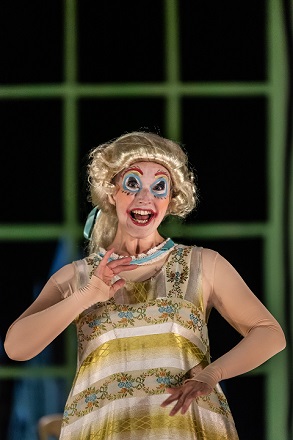 Rhian Lois as Jerusha Cramer Photo credit: Clive Barda.
Rhian Lois as Jerusha Cramer Photo credit: Clive Barda.
The cast, however, give their all. It was announced at the start that Michel de Souza was unwell, and surely by the end he must have felt truly dreadful having been asked to force his voice high and low, and generally swallow and strangle sound and syllable. As he companion D’Esperaudieu, Adrian Dwyer was more successful than most in communicating if not meaning then at least words, and he and Rhian Lois as Jerusha were able to produce a focused tone which could carry about the tumult and communicate with some directness. Not so Patrick Terry, as Serafino, who, despite a characteristically committed and game performance was often inaudible. Stephen Richardson threw himself about the stage and his voice in all directions as Sir Joseph Cramer; Stephanie Marshall completed the dedicated cast. Raphael Flutter’s solo treble was transmitted in recorded form via the bobbing heads of the grotesque putti slouching on the columns of the theatre-within-a-theatre set. Conductor Jessica Cottis guided the London Sinfonietta confidently but when she joined the cast on stage for the curtain-call she looked exhausted, only tentatively allowing herself what seemed a relieved smile.
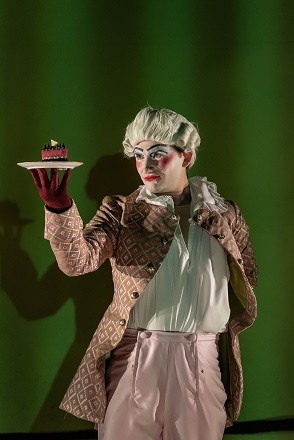 Patrick Terry as Serafino. Photo credit: Clive Barda.
Patrick Terry as Serafino. Photo credit: Clive Barda.
Paradies’ opera audience - who prefer card games and gastronomic cuisine to genuine ‘culture’ - formed a row of rubbery double-headed Francis Bacon-inspired Dummies: I guess this was ‘us’. But, if The Intelligence Park is an opera about unfulfilled creativity, then I wondered just whose creativity was under the spotlight. Some commentators have described Barry as a ‘visionary’. I found his fantastic, frantic pastiche tedious: thinking of Birtwistle’s Punch and Judy, or imagining what Adès might do with this conceit, made it hard to discern just what ‘vision’ it was that Barry was supposed to have had.
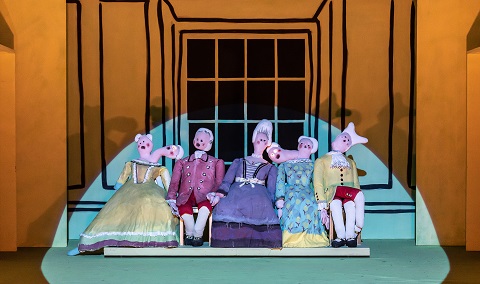 Photo credit: Clive Barda.
Photo credit: Clive Barda.
Admittedly, I was no fan of the composer’s 2011 opera The Importance of Being Earnest , which won widespread acclaim, but in that case Wilde’s perfectly well-made play was able to withstand Barry’s rough treatment. On this occasion, I began to wish that the Grim Reaper who haunted the production with increasing frequency would wield his scythe on proceedings. That said, there were plenty in the Linbury who voiced their praise vigorously at the close. Visionary or Emperor-with-no-clothes?
Claire Seymour
Gerald Barry: The Intelligence Park (Libretto: Vincent Deane)
Robert Paradies - Michel de Souza, D'Esperaudieu - Adrian Dwyer, Sir Joshua Cramer - Stephen Richardson, Jerusha Cramer - Rhian Lois, Serafino - Patrick Terry, Faranesi - Stephanie Marshall; Director and Designer - Nigel Lowery, Conductor - Jessica Cottis, Lighting assistant - Fridthjofur Thorsteinsson, London Sinfonietta
Linbury Theatre, Royal Opera House, London; Wednesday 25th September 2019.
image=http://www.operatoday.com/The%20Intelligence%20Park.jpg image_description= product=yes product_title=Gerald Barry’s The Intelligence Park: Linbury Theatre, Royal Opera House product_by=A review by Claire Seymour product_id=Photo credit: Clive BardaAn interview with Cheryl Frances-Hoad, Oxford Lieder Festival's first Associate Composer
Jeanette Winterson’s words, from her 1993 novelWritten on the Body, would make a good epigraph for this year’s Oxford Lieder Festival. In recent years the Festival has shone a spotlight variously on Schubert’s entire song oeuvre, ‘Poets and their Songs’, and Gustav Mahler and fin-de-siècle Vienna. Last year the Festival undertook a ‘Grand Tour’ - a European journey in song, which explored cultural influences from Finland to the south of Spain, from Dublin to Moscow.
Next month, the Festival’s focus will be storytelling. Tales of Beyond - Magic, Myths and Mortals will comprise a multitude of narratives, mischievous, magical and musical. In fact, one might argue that all music-making is about telling a story, whether it takes the form of a song setting a single poem, the development of a drama in a symphony or opera, or the conversational interplay of chamber music. Music’s ‘meaning’ may be ultimately ineffable, from ‘beyond’, but there’s no doubt that it ‘speaks’ to us, communicating the real and the imagined, directly and ‘magically’.
The 2019 Festival also marks the start of Cheryl Frances-Hoad’s three-year appointment as Oxford Lieder’s first Associate Composer. “It’s phenomenal,” says Cheryl, when I meet with her to discuss her new role. “To have the position for one year would be fantastic, but three years is incredible.” Cheryl explains how her association with the Festival’s founder and Artistic Director, Sholto Kynoch, has developed. In 2011, as a member of the Phoenix Piano Trio, pianist Kynoch and his fellow musicians premiered Cheryl’s The Forgiveness Machine , which the Trio had commissioned as part of their Beyond Beethoven project. Subsequently they recorded the work on Stolen Rhythm , a disc of Cheryl’s music for the Champs Hill label. In 2016, Oxford Lieder commissioned The Thought Machine , a new song-cycle for performance at a concert for children. An Arts Council grant enabled Cheryl to develop the piece into a participatory work involving music, poetry and hand shadows, working with singer-pianist ensemble Songspiel and hand shadowgrapher Drew Colby who have toured The Thought Machine to schools in Peterborough and Cambridge and will bring it back to this year’s OLF.
As Associate Composer, Cheryl’s music will be heard frequently during the next three Oxford Lieder Festivals. Each year a new work will be commissioned. This year, Cheryl’s setting of Baudelaire’s ‘Une Charogne’ will be included in a programme of French Fables performed by contralto Jess Dandy and Sholto Kynoch, while in 2020 a new 20-minute work for soprano and piano will be premiered, with a longer 45-minute composition following in 2021. It’s an ambitious, extended project for Oxford Lieder. Cheryl suggests that since the Festival was founded in 2002, a strong relationship between the large, regular audience and the Festival has developed, in ways that have allowed for increasingly more adventurous programming.
 Marta Fontanals-Simmons Photo credit: Victoria Cadisch.
Marta Fontanals-Simmons Photo credit: Victoria Cadisch.
Thus, this year’s Festival will also include new works by other composers. Mezzo-soprano Kitty Whatley and pianist Simon Lepper will perform Juliana Hall’s ‘monodrama’ Godiva, which sets a libretto by Caitlin Vincent, in a programme of Fairy Tales from Stanford to Sondheim. The following evening sees the world premiere of Martin Suckling’sThe Tuning , a song-cycle setting the poetry of Michael Donaghy, by mezzo-soprano Marta Fontanals-Simmons and pianist Christopher Glynn, in a recital which also includes a performance of Schubert’s Die schone Müllerin by baritone Roderick Williams.
‘Une Charogne’ posed a new challenge for Cheryl as it was the first time that she had set a French text. She explains that she was grateful for the help and advice offered by Helen Abbott, Professor of Modern Languages at Birmingham University, who has a special research interest in nineteenth-century French poetry and music, and who, during the 2018 OLF presented a collaborative coaching masterclass day for singer/pianist duos focusing on French song, especially Verlaine/Debussy.
Helen’s current research project is the Baudelaire Song Project . She helped Cheryl - whose last experience of reading and speaking the language was during her GCSE French studies! - with Baudelaire’s text, explaining matters such as pronunciation, how to divide the syllables of a word and the correct text layout on the score. She also made recordings of the poem, at both a slow and normal speaking speed. In addition to studying a translation of the poem, Cheryl also translated each individual word herself; before she began her musical setting, she could speak the text fluently.
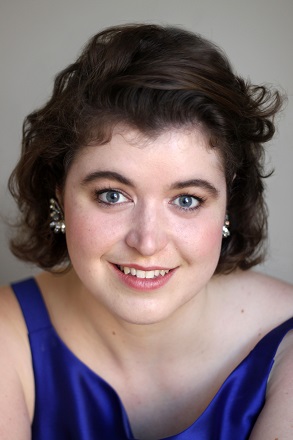 Jess Dandy. Image courtesy of the Oxford Lieder Festival.
Jess Dandy. Image courtesy of the Oxford Lieder Festival.
Taken from Baudelaire’s Fleur du mal, ‘Une charogne’ is a startling, almost Goya-esque, memento mori in words. The eponymous carcass inspires incongruous images, and as themes of love and life, death and horror weave together, the beautiful and grotesque collide. Alternating Alexandrine and octosyllabic lines create a natural ebb-and-flow, and individual sounds enhance the ‘musicality’ of the poem. But, I ask Cheryl, how on earth does one go about finding musical imagery to embody phrases such as, “The blowflies were buzzing round that putrid belly,/ From which came forth black battalions/ Of maggots, which oozed out like a heavy liquid” (Les mouches bourdonnaient sure ce ventre putride,/ D’où sortaient de noirs bataillons/ De larves, qui coulaient comme un épais liquide)? A glance at the score suggests that Cheryl hasn’t been averse to some literal word-painting at times - there’s a very busy, decorative right-hand line at the point of the aforementioned image of decay - but her setting seeks to present the poem’s incongruities in a more holistic way, and to capture equally the poem’s bizarre humour, ecstatic reveries and its graver intimations of distortion, dissolution and decay.
A second composition by Cheryl will have its world premiere during the OLF, though it was not specifically commissioned by the Festival. Endless Forms Most Beautiful , a song-cycle for soprano and string quartet, will be performed in Oxford’s Museum of Natural History by soprano Carola Darwin and the Gildas Quartet. In 2000, Cheryl met Carola, who is Charles Darwin’s great-great-granddaughter, when she took part in a competition run by the Darwin Centre at the Natural History Museum. “I didn’t win,” Cheryl smiles, “but I did become friends with Carola” and the idea of a cycle of songs setting texts about the environment and evolution was borne. 19 years later, it has come to fruition.
Endless Forms Most Beautiful takes its title from Charles Darwin's On the Origin of Species:
There is grandeur in this view of life, with its several powers, having been originally breathed by the Creator into a few forms or into one; and that, whilst this planet has gone cycling on according to the fixed law of gravity, from so simple a beginning endless forms most beautiful and most wonderful have been, and are being, evolved.
 Gildas Quartet. Image courtesy of the Oxford Lieder Festival.
Gildas Quartet. Image courtesy of the Oxford Lieder Festival.
Its seven songs set texts by the 19th-century poet Walter Deverell (‘The Garden’) and the NHM’s three 2016 Poets-in-Residence: Kelley Swain (‘To the Paleontologists’, ‘Cetacean Introduction’, ‘Bones’, ‘Thermodynamics of Immortality’), John Barnie (‘Let’s Do It’) and Steven Matthews (‘Yet With Time’s Cycles Forests Swell’). I ask Cheryl how she went about selecting the texts. “We chose poems that we liked and that fitted the theme. At that stage I didn’t pay much attention to potential issue relating to text-setting, and in fact some of the poems are quite long and in some places I have cut some text.” Do they present an unfolding ‘narrative’? “Not really, they do all relate to the general theme but could be performed as individual songs.”
During the next three years, OLF will present all of Cheryl’s existing songs, as well as selected chamber music, and piano and choral works. Next month, Jess Dandy and Dylan Perez will performBeowulf, Cheryl’s 2010 setting of extracts from Seamus Heaney’s translation of the Old English epic. Pianist Ivana Gavrić will play four of Cheryl’s piano works in a concert including works by Clara Schumann and Edvard Grieg, and the Choir of Merton College will sing Bogoroditse Dyevo which was composed as part of a project to create six new works, by six different composers, each of which was inspired by an earlier work, and for which Cheryl drew upon Rachmaninov’s well-known Vespers.
Cheryl’s works include a Piano Concerto, Cello Concerto, several large-scale works involving young musicians and much chamber music, but she has perhaps been most widely acclaimed as a composer of songs and other vocal works. I ask her if she feels a particular predilection for working with words, and she admits that she does find that working with a text makes composition ‘easier’ to some extent. Her oeuvre is extensive, and her music is frequently performed. However, Cheryl feels that she is reaching a point in her career where she would like to make some space and time to reflect on her longer-term plans. “During the last 10 years I’ve enjoyed being able to compose many works ‘for my friends’, but now I’d like to ask myself, ‘what do I want to write?’,” she laughs. Might she also want to expand her canvas? Three choral works will be her immediate compositional focus but after that … perhaps an opera, and other larger works? She hints at some forthcoming projects, which will present fresh and exciting challenges.
The 2019 Oxford Lieder Festival runs from 11-26 October. Claire Seymour image=http://www.operatoday.com/Frances-Hoad%2C%20Cheryl%20title.jpg image_description= product=yes product_title= product_by=An interview by Claire Seymour product_id=Above: Cheryl Frances-HoadSeptember 24, 2019
O19’s Phat Philly Phantasy
Sergei Prokofiev’s score crackles with colorful effects all evening long, and when it on occasion modulates to more lyric leanings, the tunes are marked by a pleasant melancholy. There are bursts of joyous abandon as well, like the Prince’s laughing fit, a cackling drag act, and the eventual wedding celebration. The main intent of the somewhat convoluted story is to entertain, and entertain it does. And how!
From the time we enter the auditorium, we can see a stage within a stage as designed by Justin Arienti, whose large white, ornate false proscenium is set well back from the apron, and is not masked by legs, so we see the actual walls and stage machinery “off-stage.” A pair of tall scaffolds flank the real proscenium right and left.
At the downbeat, boisterous gangs of men advocate the interests of Tragedy, Comedy, Lyric Drama and Farce. They are subsequently herded to populate the various levels of the downstage towers, and are told that there will be something for everyone in the show that they are about to witness, called: The Love for Three Oranges. Elizabeth Braden’s chorus was once again flawless in their accomplishment.
Director Alessandro Talevi keeps things percolating, and his unerring sense of restless, intricate group movement could qualify him as an air traffic controller at Philadelphia International. Mr. Talevi’s vision not only keeps the action moving, but also knowingly deploys an admirable sense of focus, so we are always directed to the important moment at hand. His admirable skill at crowd control is exceeded only by his ability to craft witty business between individual characters in well-realized chamber scenes.
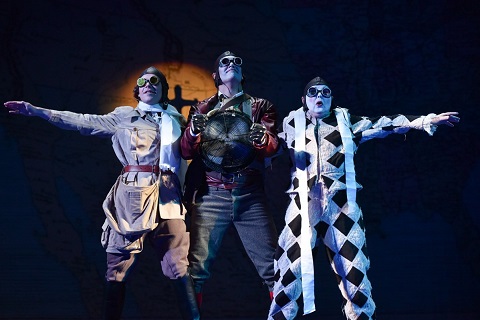
Just as designer Arient has a few tricks up his sleeve with scenic effects (shadow play, mechanized rat, etc.), Manuel Pedretti’s over-the-top costumes engage the eye, and define the diverse dramatic personalities. His cheeky interpretation of the Cook as a bloated chicken (no kidding) is inspired lunacy. The uber-talented David Zimmerman outdid himself with an inspired wig and make-up design that knew no bounds for fantasy and invention. Giuseppe Calabrò’s ever-morphing, malleable lighting design made sure that all of the other technical elements were beautifully showcased to maximum advantage, by shifting the mood and underscoring the dramatic intent with effortless skill.
It would be difficult to overpraise the incisive, magical reading that Corrado Rovaris elicited from the pit.The Maestro has helmed a shimmering, capricious reading of the composer’s ebullient score that enchants the ear, tickles the senses, and warms the soul. Whether playing as a tightly focused ensemble or featuring characterful solos, this accomplished band responded with a reading that is one part effervescence, one part meticulous stylistic realization, and 100 per cent magnificently reverberating accomplishment.
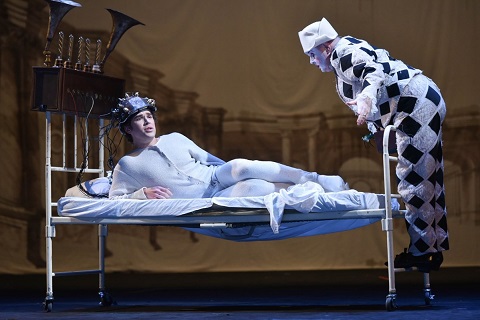
The large cast of soloists is evenly matched, and meticulously cast. As the melancholy Prince, the slender and youthful Jonathan Johnson strikes just the right balance of pouting charm and hang dog demeanor. Mr. Johnson’s freely produced, gleaming tenor fills the house with ease, thanks to his well-focused delivery. He makes the famous laughing scene irresistibly infectious, and he subsequently morphs into a character of determined maturity.
As his sidekick Truffaldino, Barry Banks’ pliable tenor soared fearlessly, effortlessly to encompass the heights demanded by this role’s tessitura. Mr. Banks’ loose-limbed presence animated his every scene, and we rather missed him when he was off stage. He also deftly voiced the gentle tragedy as he unwittingly causes the death of two princesses.
Scott Conner was a solid, sure-voiced King of Clubs, his impressively rolling bass possessed of just the right amount of bite to project the regal frustration that informs the character. Wendy Bryn Harmer was a powerful presence as a plush-voiced, potent Fata Morgana. Ms. Harmer admirably deployed her substantial, warmly tinged soprano with gleefully wicked coloring.
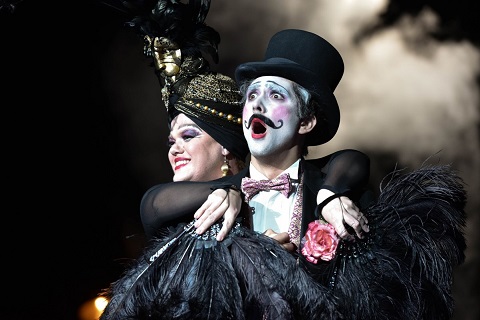
As the plotting duo Princess Clarissa and Leander, Allissa Anderson and Zachary Altman oozed mellifluous malintent. Ms. Anderson’s generous, throbbing mezzo made the most of her every utterance, while Mr. Altman’s oily, unctuous vocal delivery was informed by a handsome, commanding bass baritone of considerable stature.
Bass Zachary James’ towering physical presence is exceeded only by his towering talent on ample display in the featured role of The Cook. This outrageous drag act not only makes Mr. James a female, but as noted above, actually makes him a chicken. No chicken (s)he when it comes to hurling out musical phrases that throb with theatrical urgency and refulgent vocalizing. His coy girlish playfulness obtaining the ribbon he covets was alone worth the price of admission.
Tiffany Townsend was a ravishing vocal presence as the (surviving) Princess Ninetta. Ms. Townsend’s lustrous, creamy tone has spinto leanings, and her instrument sounds wondrously even and ravishing at all volumes and in all registers. This young talent is certainly a singer to watch as her star is sure to rise. Her sister Princesses Linetta and Nicoletta, were well-served by two assured mezzos, the former showcasing Katherine Pracht’s shining presentation and the latter wonderfully illuminated by Kendra Broom’s meaty, yet melting tone.
Even the smallest of cameos is cast from strength, a testament to the total achievement of the casting director. Brent Michael Smith’s strong delivery and admirable bass made the most of Chelio’s statements. Mezzo Amanda Lynn Bottoms’ poised, utterly secure phrases made a good case for Morgana’s treacherous accomplice Smeraldina. Will Liverman’s suave, elegant baritone is luxury casting for the King’s advisor Pantaloon. Ben Wager’s plucky bass enlivened the demon Farfarello; tenor Corey Don Bonar was the successful Master of Ceremonies; and bass Frank Mitchell richly intoned the pronouncements of the Herald.
Orange(s) is the new . . .hit. This winning mounting of The Love for Three Oranges should inspire other American companies to follow suit, especially those with the depth of Young Artist programs, and bring this inventive composition to a much wider audience. Bravi tutti to the wide-ranging participants that winningly brought Prokofiev’s unique creation to unforgettable life on the Academy stage.
James Sohre
The Love for Three Oranges:
Music - Sergei Prokofiev
Libretto - Sergei Prokofiev and Vera Janacopoulos
The King of Clubs: Scott Conner; The Prince: Jonathan Johnson; Truffaldino: Barry Banks; Fata Morgana: Wendy Bryn Harmer; Princess Clarissa: Alissa Anderson; Leander: Zachary Altman; Chelio: Brent Michael Smith; Ninetta: Tiffany Townsend; The Cook: Zachary James; Smeraldina: Amanda Lynn Bottoms; Pantaloon: Will Liverman; Linetta: Katherine Pracht; Nicoletta: Kendra Broom; Farfarello: Ben Wager; Herald: Frank Mitchell; Master of Ceremonies: Corey Don Bonar; Conductor: Corrado Rovaris; Director: Alessandro Talevi: Set Design: Justin Arienti; Costume Design: Manuel Pedretti; Lighting Design: Giuseppe Calabrò; Action Design: Ran Arthur Braun; Wig and Make-up Design: David Zimmerman; Chorus Master: Elizabeth Braden
image=http://www.operatoday.com/oranges-22.jpg
image_description=
product=yes
product_title=Opera Philadelphia: The Love for Three Oranges
product_by=A review by James Sohre
product_id=All images © Kelly & Massa
Agrippina: Barrie Kosky brings farce and frolics to the ROH
In Vincenzo Grimani’s libretto for Handel’s Agrippina, this inveterate liar, intriguer and practiced murderess has a single aim - the usurpation of her husband Claudius’s throne by her son, Nerone. The Venetian Grimani, a nobleman and cardinal, knew a thing or two about reaching the top, whether via diplomacy or duplicity: his career culminated in his appointment as Viceroy of Naples in 1708. Not long afterwards, in December 1709, his vicious satire depicting ruthless intrigues in ancient Rome motivated by vengeance and sexual gratification was enticing the punters at the Teatro Grimani di S. Giovanni Grisostomo in Venice. Agrippina ran for 27 performances, until February 1710: it was the 25-year-old composer’s first operatic triumph.
Some of Grimani’s cast of licentious liars had featured in Monteverdi’s L’Incoronazione di Poppea, 70 years earlier, in a more subtly comic dramatic context. Barrie Kosky’s production of Handel’s opera - seen first in Munich earlier this summer - ignores the fact that the Handel-Grimani take on these power-sex conspiracies might be rather more than ‘just comic’, and strives to turn proceedings into a Roman sit-com, with pairs of loathsome criss-crossing lovers and colluding connivers coming a cropper. There is, as always, both irony and pathos in Handel’s score, but Kosky puts his money on frenetic farce.
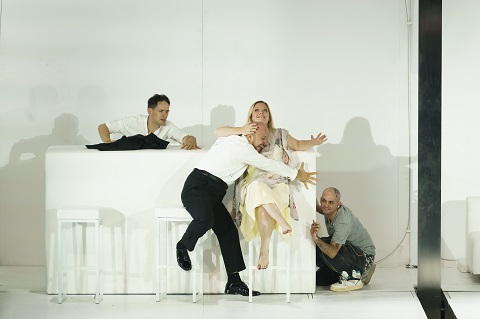 Photo credit: Bill Cooper.
Photo credit: Bill Cooper.
Rebecca Ringst’s steel box-frame design offers plentiful stairways, corridors, blinds and inner chambers for eavesdroppers to find hideaways and intriguers to conspire. As the plottings unfold, the box swivels and dismantles, its moving parts emblematic of the human chess game being played by Agrippina. It’s no surprise that at the height of the hugger-muggering - when, at the opening of act 3, a trio of Romans visit Poppea’s apartments, lured by her panto-esque ploy of hide-and-hear - Joachim Klein’s eye-burning lighting of the white-on-white interior renders the audience as blind as the protagonists. Nor, that the Meccano-parts are reassembled when Agrippina checkmates one and all.
Grimani’s libretto is one of the most psychologically and dramatically convincing that Handel set, and even though Agrippina has a high proportion of self-borrowed material (some scholars have suggested that as many as 50 of the 55 separate numbers have known precursors), Handel’s score is compelling, inspired by youthful creativity, confidence and vigour. The recitatives are lengthy but persuasive, often bringing voices together in ways which drive the drama onwards. In the ROH pit, conductor Maxim Emelyanychev pushed the pace and challenged the singers to keep up: the Orchestra of the Age of Enlightenment were impelled by the innate harmonic energy and a driving and robust bass line. The continuo timbres were varied and alert, and the oboe players deserved a bonus.
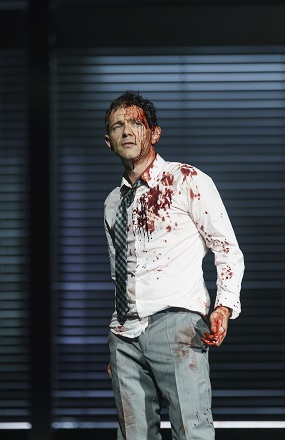 Iestyn Davies as Ottone. Photo credit: Bill Cooper.
Iestyn Davies as Ottone. Photo credit: Bill Cooper.
So why, given too that there was some splendid singing to enjoy, did I feel slightly dissatisfied? I think it’s because Kosky seems not to appreciate Handelian irony. Grimani provides copious intrigue and irony. Handel enhances this by composing music which is often at odds with the apparent sentiments of the text. So, when in Act 1 the words of Agrippina’s ‘Non ho cor che per amarti’ seem to assure Poppea that Agrippina is her BFF, the minor key and sinuous melodic lines tell us otherwise. There is no need for theatrical signposting. Time and again I found myself reflecting on a Shakespearian parallel: that if Iago does not indeed seem ‘honest’ to the other characters, then the dramatic credibility is destroyed - whatever audience collusion is generated by Iago’s play-dominating soliloquies. In Kosky’s production there is far too much minxing, mincing and melodramatising. He doesn’t trust Handel to do the work for him.
Fortunately, Kosky has a fine cast to present his petulant playground antics. Ever a theatrical animal, Joyce DiDonato relishes the extroversion and exaggeration of Kosky’s conception of Agrippina, which seems to owe much to American 1980s TV dramas Dynasty and Dallas. DiDonato pushes her voice hard in Act 1, but doesn’t really delve into the emotional depths of Act 2’s ‘Pensieri, voi mi tormentate’. With the follow-spot shining, she wields a diamante-studded microphone with aplomb - when Agrippina morphs into a Judy Garland clone (why?) - but it’s not until the closing moments, when she claims that it was love for Claudio that led her to secure the throne for Nerone, that the musical simplicity and sincerity of ‘Se vuoi pace’ allows DiDonato - without Kosky’s interference - to fulfil Handel’s deliciously ironic directness.
As Poppea, Lucy Crowe flounces and flirts hyperactively. If she’s not ‘doing a Marilyn Monroe’ on the steel staircase, then she’s fluttering her skirts and flashing her knickers - this Poppea’s self-love outweighs her suitors’ adoration! Not that Crowe doesn’t produce the vocal goods to justify such adulation: Emelyanychev pushed her rather too fast in ‘Se giunge un dispetto’ and after some dizzying coloratura the climatic phrase-peaks rather lost touch with their harmonic roots, but Crowe demonstrated fine breath control and rhythmic clarity.
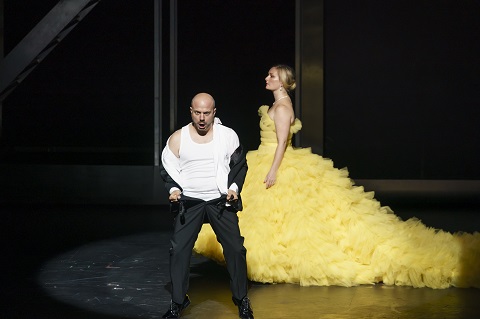 Gianluca Buratto as Claudio, Lucy Crowe as Poppea. Photo credit: Bill Cooper.
Gianluca Buratto as Claudio, Lucy Crowe as Poppea. Photo credit: Bill Cooper.
The first-night audience went wild for Franco Fagioli’s tattoo-headed, eyebrow-studded, hoodie-slouching Nerone. I was less enamoured. Handel wrote the roles of Nerone and the courtier Narciso for castrates; Fagioli sings with a nerve-twitchingly wide vibrato and his tone is piercing rather than ingratiating; he gets around the coloratura but in a rather mechanical, rather than meaningful, way. I don’t think that this role needs to be sung by a woman: one can imagine a rich feminine voice, such as that of Philippe Jaroussky, serving the role well, and offering rather more complex characterisation than Fagioli’s pouting, wall-pounding, floor-stamping adolescent. Nerone’s final aria, ‘Come nube che fugge dal vento’, in which he claims that he has broken the enchantment of his infatuation for Poppea, did however suggest that Fagioli might have had more to say than Kosky allowed.
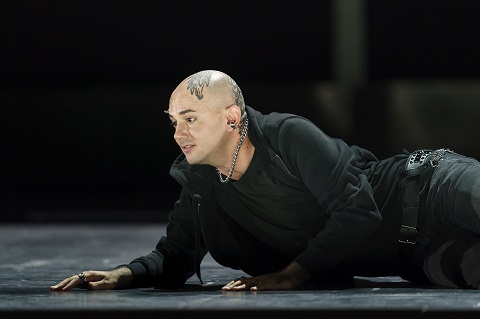 Franco Fagioli as Nerone. Photo credit: Bill Cooper.
Franco Fagioli as Nerone. Photo credit: Bill Cooper.
Gianluca Burrato was dramatically convincing as Claudio, prepared to look a fool with his trousers round his ankles, but his lower register was not entirely secure or firm. As Agrippina’s would-be suitors Pallante and Narciso, Andrea Mastroni and Eric Jurenas’s comic antics didn’t make much of a mark, though there was little to fault with their singing; the same could be said for José Coca Loza’s Lesbo, Claudio’s ‘Leporello’.
Iestyn Davies as Ottone was alone in his appreciation of the sincere characterisation embodied in Handel’s music and text-setting. When he appeared before the Imperial palace, expectant of glory in acknowledgement of his heroic deeds, this Ottone seemed genuinely unaware that he is about to be denounced as a traitor. Having been assaulted violently with a lead pipe, he delivered the dissonant recitative and expressively eloquent ‘Voi, che udite’ with a musical precision and psychological perspicacity which was unique during this evening’s performance.
It was only at the very close of the opera that Kosky approached anything like this sort of veracity. The director eschews Juno’s divine intervention and offers instead a slow oboe-led movement from L'Allegro, il Penseroso ed il Moderato. Agrippina retreats to the steel-box and takes a seat, alone … victorious? Nero is Emperor: she’s won, hasn’t she? Tantalisingly, in these final moments Kosky shows that he understands the inherent tragedy that Handel ironically unfolds … the moment is a bit too late to really make its mark, but it’s welcome. As today’s politicians are realising, as events unfold, the winner doesn’t necessarily take all.
Claire Seymour
Agrippina - Joyce DiDonato, Nerone - Franco Fagioli, Poppea - Lucy Crowe, Ottone - Iestyn Davies, Claudio - Gianluca Buratto, Pallante - Andrea Mastroni, Narciso - Eric Jurenas, Lesbo - José Coca Loza; Director - Barrie Kosky, Conductor - Maxim Emelyanychev, Set designer - Rebecca Ringst, Costume designer - Klaus Bruns, Lighting designer - Joachim Klein, Orchestra of the Age of Enlightenment.
Royal Opera House, Covent Garden, London; Monday 23rd September 2019.
image=http://www.operatoday.com/Agrippina%20title%20ROH.jpg image_description= product=yes product_title=Agrippina: Royal Opera House product_by=A review by Claire Seymour product_id=Above: Agrippina (ensemble)Photo credit: Bill Cooper
September 23, 2019
Billy Budd in San Francisco
Dutch conductor Lawrence Renes’ seascapes were deeply and powerfully drawn, his battle was monumental, his moral confusion was terrifying, his defeat was shattering. His orchestra was an aggressive, present player in the telling of Melville’s parable. Britten’s score in this conductor’s hands proves that Billy Budd’s story is not at all as simple as it seems and that its lesson is so bleak and huge that it demands the protection of high art to be borne.
The War Memorial Opera House was built before architectural acoustics was a science. Its acoustic can be mushy and quirky. But for this Billy Budd the San Francisco Opera Orchestra somehow clearly projected the beauty of Britten’s moral ideal of handsomeness in a stunning display of colors and volumes and textures. The diction of the opera’s protagonists was crystal clear, every word was fully understandable in the hyper British-like sounds of careful musical diction. It was a remarkable feat.
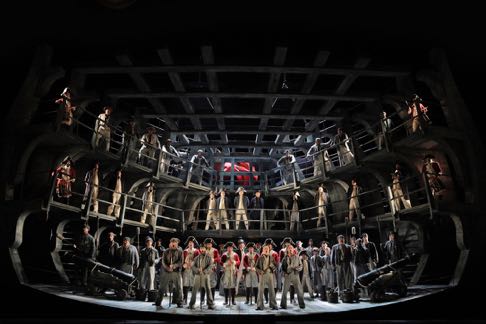
This was the 2010 production from Glyndebourne by British theater director Michael Grandage and his designer Christopher Oram, seen at the Brooklyn Academy in 2014 to great acclaim. The set is the exaggerated super structure of a British man-of-war called the Indomitable. It is the world of 40 male San Francisco Opera choristers impressed into service as its crew, along with 15 or so more sailers who have names, plus the ship’s captain and his officers and a number of Ship’s Boys.
These 80 inhabitants of the Indomitable populate its globe-shaped world from which no one will escape, not even Billy Budd who, in death, remains alive as the embodiment of a critical enigma of our existence — can good and beauty actually exist in this world? The Grandage production implies that no, it cannot. At the end of the opera the Indomitable’s captain, the now old Starry Vere, the Indomitable’s moral conscience, stands alone on the stage. He continues pondering the enigma as he has since the moment Billy Budd was hung. He looks us straight in the face to tell us that he could have saved Billy Budd but did not. Black out.
Like Peter Grimes and Aschenbach (Death in Venice) the Indomitable’s Captain Vere is a tenor. But here tenor William Burden’s voice is neither heroic nor is it cerebral. Mr. Burden is a fine singer and actor who does not project force of personality. This allows us to perceive Captain Vere as an abstract player in a moral drama, not as an individual man in the throes of crisis. His most telling moment was when he prepared himself to tell Billy that he will be hung. He stood alone in white light, lost within his dilemma, his voice taking on unexpected new beauty, determining the tragic irony that Billy’s goodness must be destroyed.
John Claggart, the Indomitable’s master-at-arms (policeman) was sung by bass Christian Van Horn. Mr. Van Horn is of towering height and is a fine actor of beautiful voice. This Claggart was not a tormented, sexually disturbed character (though his response to Billy is sexually charged) but a towering force of order who must bow to all authority while defeating any threat of enlightenment that might challenge that authority. The handsome beauty, the spiritual freedom of Billy Budd had to be destroyed by any means possible as it awakened enlightenment — perhaps in the master-at-arms himself, and certainly in the seamen.
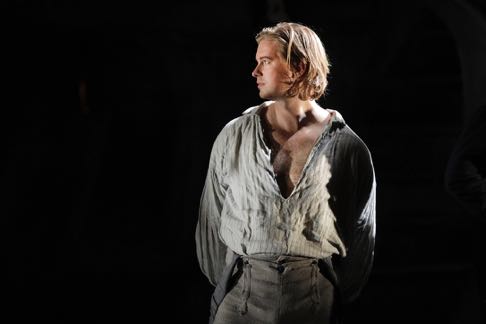
Billy Budd was sung by baritone John Chest. Mr. Chest possesses a focused dark and beautiful voice. He is of small stature and wily. Of the three principals (Vere, Claggart and Budd) he is the one who becomes the real, suffering human being. He finds a surpassing human sympathy for his fellow men in his very moving death vigil, though he fails to accept that he cannot be handsome and good. Britten’s opera teaches us that we cannot allow beauty to exist as it may challenge order. We must therefore search for its flaw and seize upon this flaw to destroy it. Billy stuttered.
Once Billy is condemned he is led off the stage. We do not see him ascend to the yardarm. He will not be seen as a Christ figure offering salvation. His brute disappearance leaves the world without beauty. Just like Moby Dick who challenges and threatens man, Billy Budd too challenges and threatens men. Both Moby Dick and Billy Budd must be destroyed by the men who cannot control them.
The world of the Indomitable is filled with sailors of lively personalities who serve the purposes of the opera’s protagonists. The San Francisco Opera assembled an excellent, appropriate cast of high level character singers who made the world of the Indomitable an artistically valid setting for this Britten masterpiece.
Michael Milenski
Cast and production information:
Captain Vere: William Burden; Billy Budd: John Chest; John Claggart: Christian Van Horn; Mr. Redburn: Philip Horst; Mr. Flint: Wayne Tigges; Mr. Ratcliffe: Christian Pursell; Red Whiskers: Robert Brubaker; Novice: Brenton Ryan; Maintop; Christopher Colmenero; Squeak: Matthew O'Neill; Donald: John Brancy; Bosun: Edward Nelson; First Mate: Sidney Outlaw; Second Mate: Kenneth Overton; Novice's Friend: Eugene Villanueva; Dansker: Philip Skinner; Midshipman: Talinn Hatt; Midshipman: Marvin B. Valdez; Midshipman: Curtis Resnick; Midshipman: Lucas Willcuts; Cabin Boy: Benjamin Drever; Arthur Jones: Hadleigh Adams. The San Franciscco Opera Orchestra and Male Chorus, members of the Ragazzi Boys Chorus. Conductor: Lawrence Renes; Production: Michael Grandage; Revival Stage Director: Ian Rutherford; Production Designer: Christopher Oram; Original Lighting Designer: Paule Constable; Revival Lighting Designer: David Manion. War Memorial Opera House, San Francisco, September 20, 2019.
image=http://www.operatoday.com/BillyBudd_SF1.jpg
image_description=Photo copyright Cory Weaver courtesy of San Francisco Opera
product=yes
product_title=Billy Budd at San Francisco Opera
product_by=A review by Michael Milenski
product_id=Above: Christian Van Horn as John Claggart, William Burden as Captain Vere
All photos copyright Cory Weaver courtesy of San Francisco Opera
Vaughan Williams: The Song of Love
This release includes the famous The House of Life, with Kitty Whately, a mezzo-soprano, and songs in German and French, with Roderick Williams, probably the pre-eminent interpreter of English song.
Though the full cycle of The House of Life is now nearly always heard with male voice, even with bass-baritones, the premiere was given at the Wigmore Hall on 2nd December 1904, in the presence of Vaughan Williams himself, with Edith Clegg, a contralto, accompanied by Hamilton Harty. Some of the songs, to sonnets by Dante Gabriel Rossetti, have texts that suggest a man addressing a woman, such as Love’s Minstrels and Heart’s Haven, but the others four are gender neutral. Indeed, Silent Noon, one of the best loved of all Vaughan Williams’ songs, lends itself particularly well to the female voice. The warmth in Whately’s timbre enhances the image of high summer langour, where “hands lie open in the long fresh grass”, the piano gently palpitating. Whately breathes tenderness into the phrase “All round our nest, far as the eye can pass, are golden kingcups fields with silver edge” One can almost feel the vista, and endless horizons. But the “visible silence, still as the hourglass” cannot last. “Deep in the sun-searched growths the dragonfly hangs…” Dragonflies die, their splendour brief and doomed. Whately’s voice seems to hover, making the passionate final declaration ever more poignant. “O! clasp we to our hearts, for deathless dower”. The final phrase “the song of love” (hence the album title) can be a little too high for some male voices but poses no problems for a mezzo-soprano. Though the cycle is The House of Life, the texts deal with Death, often as a strange visitor, as in Death-in-Life, but the overall impact, given the understatement of Vaughan Williams’ settings, suggests that happiness, and life, must be cherished while it lasts.
In the Three Old German Songs (1902) Vaughan Williams explored medieval German song, capturing an archaic nature rather different from folk song, German or English. The setting of To Daffodils on this set comes from a manuscript found at Gunby Hall, which the composer visited regularly. This differs from the 1895 setting of Robert Herrick’s poem in that the short lines ebb and flow from quietness to climax, much like Vaughan Williams’ Orpheus and His Lute (1903). In the Four French Songs, from 1903-4, Vaughan Williams sets medieval French song, Quant li Louseignolz, for example rather than “Quand le Rossignol”, a song with connections to knights who took part in the Crusades. Thus, the studied “medieval” formality. Roderick Williams has no peer in English song, though his French is less idiomatic, but he’s a natural communicator. Here, his delivery brings out the special qualities in these songs, with their stylized formality, very different from folk song and indeed from later French song. There may well be a connection between these songs and Love’s Minstrels in The House of Life, with its “modern” take on medievalism.
With Buonaparty (1908) Roderick Willliams is back on home ground, his delivery animated, crackling with character. This is one of Vaughan Williams’ only two settings of Thomas Hardy’s poems though, as we know from his Symphony no 9, he knew Hardy’s Tess of the d’Ubervilles and the evocations of Wiltshire and Wessex. Perhaps the composer didn’t warm to Hardy’s other values. Gerald Finzi, who did understand Hardy’s irony and lack of deference, set more Hardy than anyone else. Finzi’s setting of Hardy’s Rollicum-Rorum quite explicitly satirizes populist war mongering. Roderick Williams’ Finzi settings of Hardy are essential listening, not only for the dynamism of his performances, but for what he reveals of Finzi’s feel for Hardy as iconoclast. RVW’s Buonaparty was intended though not used for Hugh the Drover. It’s robust, with a jolly refrain, but not especially perceptive.
With The Willow Song (1897), followed by Three Songs from Shakespeare (1925), Kitty Whately sings some of Vaughan Williams’ settings of Shakespeare. This version of Orpheus and His Lute is almost neo-classical, its refinement more subtle than the better-known earlier version. With The Spanish Ladies (1912) and The Turtle Dove (1919-1934), Roderick Williams returns to classic Vaughan Williams, the first based on a sea shanty, the second on an old ballad collected by the composer from a traditional singer’s performance at the Plough Inn, in Sussex in 1904 . These set the context for Two Poems by Seumas O’Sullivan,The Twilight People (1905) and A Piper (1908) published in 1925, when the composer was working on Riders to the Sea. O’Sullivan was the pen name of James Sullivan Starkey, a Dublin journalist. The plaintive lines may reflect Vaughan Williams’ knowledge of Ireland, through the prism of W B Yeats and J M Synge. Whately and Williams conclude with two duets based on German folk songs, in English translation, Think of me and Adieu. Though Albion recordings cater to a very specialized market, this set is very well planned and performed: a good introduction for those wanting to delve deeper into Ralph Vaughan Williams and the sources of his inspiration.
Anne Ozorio
image=http://www.operatoday.com/Song-of-Love-Cover.png image_description=Albion Records ALBCD037 [CD] product=yes product_title=Vaughan Williams: The Song of Love product_by=Kitty Whateley (mezzo soprano); Roderick Williams OBE (baritone); William Vann (piano) product_id=Albion Records ALBCD037 [CD] price=$18.99 product_url=https://amzn.to/2kzCSNfDear Marie Stopes: a thought-provoking chamber opera
Such was the ‘best New Year resolution’ that birth control advocate and sex-advice writer Dr Marie Carmichael Stopes (1880-1958) ever made, according to archival material from the Wellcome Collection. Stopes’ words form the closing lines of Alex Mills’ chamber opera, Dear Marie Stopes, which was presented at Kings Place this weekend, following the premiere in August 2018 in the Reading Library of the Wellcome Collection, as part of that year’s Tête à Tête festival.
In December 1929, advertisements appeared in several British journals announcing the publication of Mother England: A Contemporary History Self-Written by Those Who Have No Historians . This collection comprised almost 200 letters from working-class mothers, each one beginning, “Dear Dr Stopes”. In highlighting the desperation of the poor for “some advice how to prevent any more little ones coming”, Stopes inextricably linked the alleviation of poverty with the need for birth control, presenting her book as ‘a true history of the common people [that] has never yet been written’. [1]
H.G. Wells called it ‘a most striking and useful book’, while Arnold Bennett found it ‘rather awful - in the right sense’. Not everyone was positive: the Secretary for the Society of Authors, St John Ervine, complained: ‘Marie Stopes is a bloody nuisance. She worries the life and soul out of me about Birth Control … and seems to have nothing to do but bounce about the earth, shoving her nose into what doesn’t concern her. Too much energy and not enough sense.’ Indeed, Stopes herself said that Married Love: A New Contribution to the Solution of Sex Difficulties , the guide to sex and marriage that she had published in March 1918, had ‘crashed into English society like a bomb shell’.
The Wellcome Collection archives house thousands of the private letters that members of the public, male and female, wrote to Stopes following the publication of that landmark book, which not only sought to educate about sexual desire, health and contraception, but also espoused gender equality. Mills’ librettist, Jennifer Thorp, has selected extracts from these moving personal accounts, and from Stopes’ replies, and woven them into a sequence of vignettes which reveals the range of contrasting emotional, ethical and ideological opinions prevalent during the 1920s.
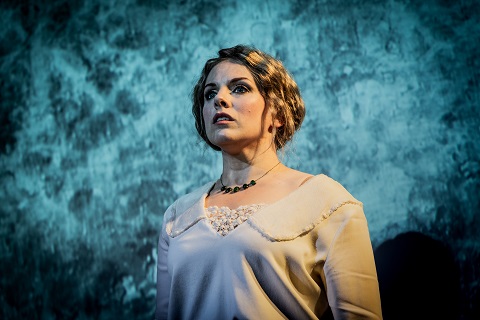 Alexa Mason (soprano). Photo credit: Robert Workman.
Alexa Mason (soprano). Photo credit: Robert Workman.
Reading and hearing these very private testimonies in the small Hall Two at Kings Place was a poignant, at times heartrending, experience, though I did wonder whether sung dramatization of these painful accounts is the most appropriate form of presentation. The words on the page speak for themselves, the simple questions and pleas imbued with an essential eloquence and truth. Mills’ musical setting is certainly sensitive to the text. At times the correspondents’ words are spoken rather than sung, and some recorded voices are interpolated (and projected), enhancing both the sense of historical authenticity and our appreciation of the impact and reach of Stopes’ work. Occasionally, the singers employ a quasi-monotonal declamation while the recitative-arioso style of the vocal melodies respects the natural syntax, with some Britten-esque gestures. The accompaniment - for cello (Clare O’Connell), viola da gamba (Liam Byrne) and percussion (Calum Huggan), with occasional electronic additions - is atmospheric but discreet, the two stringed instruments creating interesting textures, both gentle and tense, the percussion enhancing the moments of emotional intensity. The resulting score is quite cinematic in effect, showing the influence, I thought, of John Tavener.
Alexa Mason (soprano), Jess Dandy (contralto) and Feargal Mostyn-Williams (countertenor) reprised their 2018 performances with considerable skill and dedication. The diction was unanimously excellent, the voices clean and clear. Mills blends the three high-register timbres effectively, as the singers assume a variety of character-roles, echoing each other’s words in a manner which builds dramatic intensity; and Dandy’s rich, earthy lower register provides satisfying contrast, creating a broader expressive palette.
The personal confessions and appeals were deeply affecting, sometimes disturbing. There is the woman who has had 14 children, 9 of whom survive, and who is desperate to avoid the further pregnancy which her doctor has told her will probably kill her. And, the man who fears his sexual dysfunction will forever prevent him showing his “girl” the depth of his love. And, the young girl who despairs that the sexual disease she has contracted will deny her the opportunity to become a mother.
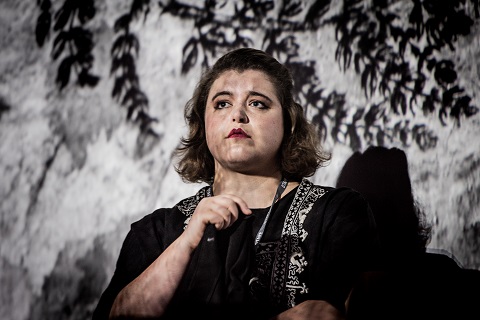 Jess Dandy (contralto). Photo credit: Robert Workman.
Jess Dandy (contralto). Photo credit: Robert Workman.
For all the merits of the music and the cast, though, there were moments where I found the emotional ‘temperature’ a little uncomfortable - that the individual private experiences were not best served by musical setting and dramatic presentation. It is hard, for example, to find an appropriate way to set lines such as those uttered by a young woman who, when helping her injured fiancé to remove his clothes “couldn’t help but see … His sex organs were very large”. There were discernible chuckles in Hall Two … and when such an exclamation develops into a duet for soprano and contralto in which the traumatised cries, “Oh God”, climb higher and higher, ever more hysterically ecstatic, there’s a danger of ‘that scene’ from When Harry Met Sally coming to mind.
More seriously, the libretto presents the counterviews of those who see Stopes’ work as “not only unwholesome but harmful” and who declare that “No-one will be the better for reading it”, but such opinions, rather than simply being representative of the broader social context, often come across as morally self-righteous and censoriously bigoted. The cast were wearing Thirties’ period costume, but at times such genuine outbursts seemed less historically informative and rather reminiscent of Britten’s Lady Billows with her sanctimonious advocacy of celibacy and celebration of ‘innocence’.
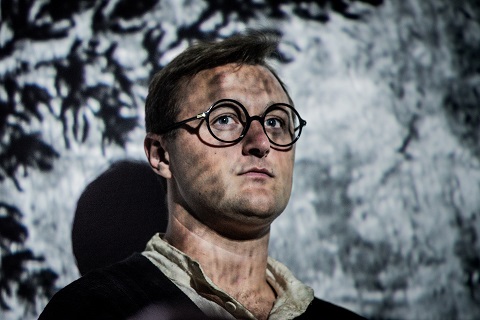 Feargal Mostyn-Williams (countertenor). Photo credit: Robert Workman.
Feargal Mostyn-Williams (countertenor). Photo credit: Robert Workman.
Also, I wasn’t sure about the judiciousness of assigning a countertenor to sing Stopes’ own words. Certainly, the decision lends a ‘neutrality’ that might be welcome but, while Mostyn-Williams has a rounded and focused voice, when he was asked to expound Stopes’ philosophical and political ethics - “Women’s political freedom is well worth the struggle … Without control over her own motherhood, no married woman can have bodily freedom” - the high-pitched, forte, unvarying vocal line inevitably sounded a little hooty at times.
The constituent parts have obvious and considerable potential, but it was Nina Brazier’s clear-sighted direction which brought them together into a coherent and convincing whole. The musicians were seated on the intimate Hall Two stage, from which a short walkway extended into the audience, bringing the latter close to the singers who at times circled the Hall. Assorted box files were piled on the stage and on a single desk at the end of the causeway. Three present-day archivists tentatively donned protective gloves and began to leaf through the historical documents, so troubled and affected by what they discovered that the fragile papers, with their hand-written appeals in fading ink, fell like feathers to the floor. Absorbed and overcome by the letters’ content, the archivists gave voice to the past, bringing the correspondents to life and transporting us back in time, making tangible the real and often raw human experiences. The sequence of vignettes unfolded naturally over 45 mins, as the characters’ stories interweaved with Stopes’ replies, and with aspects of her own life.
In fact, in seeking to do justice to the broader picture, Thorp’s libretto packs in rather more than it has time to explore in satisfactory depth. We learn, in one of the most affecting episodes, of Stopes’ own miscarriage. Similarly, her interest in eugenics is touched upon. Such brief glimpses of the wider context are very interesting, but only raise further questions. Stopes’ passionate promotion of birth control grew in part out of her concern with eugenics and had a specific ideological purpose. For example, in her 1923 book Contraception, she wrote that it was only when contraception was widely used by “diseased persons” could birth control become “the great preventive measure to arrest the spread of disease and degeneracy throughout the nation”; moreover, Stopes tried to translate her ideology into practical outcomes, founding in 1921 her first birth control centre, the ‘Mothers’ Clinic’ in Holloway, with the aim of protecting the health of women and controlling ‘racial purity’.
Dear Marie Stopes cannot, of course, explore all of the arguments and counter-arguments exhaustively. But, Mills’ chamber opera does reveal the complexity of human experience and relationships which, in this performance at Kings Place, Brazier’s sensitive handling of the material communicated directly.
Claire Seymour
Dear Marie Stopes : Alex Mills (composer), Jennifer Thorp (librettist)
Alexa Mason (soprano), Jess Dandy (contralto), Feargal Mostyn-Williams (countertenor), Liam Byrne (viola da gamba), Clare O’Connell (cello), Calum Huggan (percussion); Nina Brazier (director), Gareth Mattey (assistant director), Lucia Sánchez Roldán (video and lighting design), Tyler Forward (video programmer), Alexa Moore (costumes), Kate Romano (producer), Dr Lesley Hall (archivist)
Hall Two, Kings Place, London; Saturday 21st September 2019.
[1] For a detailed account, see A.C. Geppert (1998), ‘Divine sex, happy marriage, regenerated nation: Marie Stopes's marital manualMarried Love and the making of a best-seller, 1918-1955’, Journal of the history of sexuality, 8(3): 389-433.
Photo credit: Robert Workman
September 22, 2019
A revelatory Die schöne Müllerin from Mark Padmore and Kristian Bezuidenhout
Michael Steinberg’s prognosis, expressed in The Boston Globe in July 1976, is taking rather longer to be fulfilled than the eminent classical music critic, writer and lecturer imagined. But, this performance of Schubert’s Die schöne Müllerin by Mark Padmore and Kristian Bezuidenhout at Wigmore Hall will surely have done much to win converts to the cause which Steinberg described over 40 years ago as a ‘Fortepiano Revolution’.
Standing at the centre of the Wigmore Hall platform, the grand fortepiano from the workshop of Christoph Kern (located in Freiburg im Breisgau in the Upper Rhine plain) was a beautiful sight to behold, its glossy chestnut-cherry colour wood gleaming with an elegant grain, its graceful curves evincing a quiet stylishness and assurance.
As Wilhelm Müller’s tale of the young miller’s journey - from awakening and hope through delusion to rejection, despair and death unfolded - Bezuidenhout revealed the expressive responsibility with which Schubert endows the fortepiano part in ways that, for this listener at least, were quite revelatory. The lightness of the sound was coloured by a judiciously applied sharpness of attack, the clarity animated by such alertness, the bass line robust but lithe. This was evident from the opening bars of ‘Das Wandern’, where the low bouncing bass line and the rhythmic articulation of the rollicking right-hand figuration possessed an unusual airiness, perfectly capturing the buoyant optimism of the miller as he sets out, untroubled by desire and delighting in the rushing brook that the piano ceaseless motion embodies. Similarly, in ‘Wohin?’ Bezuidenhout was able to achieve a truly hushed pianissimo, the fluttering right-hand transparent and elegant, the syncopated bass eloquently swaying. The rapid flickers in ‘Halt!’, as the miller espies the mill among the alder trees, were gleamingly defined.
If dynamic range is not one of the fortepiano’s strengths, then Bezuidenhout showed us that the instrument does offer variety, of timbre, texture and colour. The softest passages were beautifully executed, with stylish discernment and detail. Moreover, the more rapid decay of the fortepiano’s tone seemed to become an integral expressive element. For example, the quaver-chords in the central section of ‘Am Feierabend’ were not only crystal-clear and light, but were followed by a distinct silence, the short rest evoking the slowing of the mill-wheel and the young man’s growing weariness, but also his unsettling self-doubts as he wonders if he can inspire love in the girl who has bewitched him. Similarly, at the close of ‘Danksagung an den Bach’, the gentle diminution of the postlude, with its delicate ornamentation, acquired an intimate, almost confessional, quality.
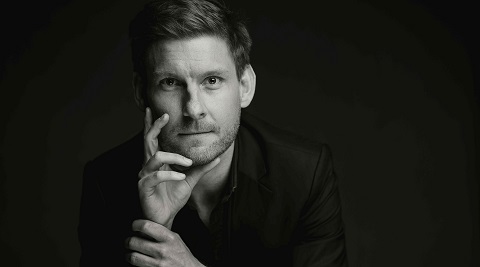 Kristian Bezuidenhout (fortepiano). Photo credit: Marco Borggreve.
Kristian Bezuidenhout (fortepiano). Photo credit: Marco Borggreve.
And, it was a quality that Mark Padmore’s communication of the cycle’s musical narrative wonderfully sculpted and enhanced. Initially, this miller was perhaps not quite the carefree adventurer of Müller’s opening poems. Rather, his purposefulness already seemed tempered by a proclivity for dreamy detachment, but Padmore’s relaxed, beautifully enunciated presentation of the text had the effect of entrancingly drawing the listener into the miller’s psyche. In ‘Danksagung an den Buch’ the tenor seemed to distinguish the words spoken aloud, to us, and those that are heard only within his own mind, and the major/minor alternation was movingly expressive. The floating tenderness of the girl’s sweet ‘good night’, which the miller dreams into being at the close of ‘Am Feierabend’, effected a shift in the expressive temperature in the following ‘Der Neugierige’, the vocal fluency and prevailing ‘simplicity’ suggesting a growing self-delusion which blossomed in the following ‘Ungeduld’ in intense assertions of devotion: “Dein is mein Herz, und soll es ewig bleiben.” (My heart is yours, and shall be forever!)
The uneasy balance of confidence and anxiety dissolved, however, towards the close of ‘Des Müllers Blumen’ where the spaciousness of the fortepiano’s compound rhythms and the delicacy of Padmore’s pianissimo intimated the ‘rain of tears’ to come, in ‘Tränenregen’. Here, again, the move to the minor key in the closing verse, allied with a carefully crafted dynamic rise and retreat, powerfully communicated the miller’s piercing yearning. Such longing was transformed into the ebullient confidence of ‘Mein!’, and the tender ecstasy of ‘Pause’ in which Padmore’s sweet head-voice seemed to embody the transfiguring beauty of the miller’s lute itself, as the breeze brushes gently across its strings, and also the fragility of the miller’s illusions.
The latter were shattered with the arrival of the hunter. The miller was by turns defiant and despairing, his defeat by his romantic rival confirmed by the quasi-reluctance of the fortepiano’s staccato progressions in ‘Die leibe Farbe’ and Padmore’s ghostly, dissolving lament: “Die Heide, die heiss ich die Liebesnot,/ Mein Schatz hat’s Jagen so gern.” (I call the heath Love’s Anguish, my love’s so fond of hunting.) The ‘world beyond’ took an ever more inescapable hold. The dynamic alternations and Padmore’s subtle verbal nuances in ‘Die böse Farbe’ revealed the miller’s fragile grip on the real, while the fortepiano’s delicate pianissimo quavers at the start of ‘Trockne Blumen’ seemed to come from ‘elsewhere’. The exquisite gentleness of the vocal line in the latter made the sudden forcefulness of the close - again, a telling shift from minor to major key in the penultimate verse - all the more troubling.
One remembers that it was in 1823 that Schubert contracted syphilis, and that it was during his hospital stay that year that he composed parts of Die schöne Müllerin. The despair that he expressed in a letter to a friend, Leopold Kupelwieser, in March 1824 was poignantly evident in Padmore’s performance: ‘I feel myself to be the most unhappy and wretched creature in the world. Imagine a man whose health will never be right again, and who in sheer despair over this ever makes things worse and worse, instead of better; imagine a man, I say, whose most brilliant hopes have perished, to whom the happiness of love and friendship have nothing to offer but pain […] “My peace is gone, my heart is sore, I shall find it never and nevermore” I may well sing now, for each night, on retiring to bed, I hope I may not wake again …’
But, Padmore’s lament for what is lost was lifted by the miller’s acceptance of his mortality and by the brook’s promise of renewal and eternity: “Rest well, rest well! Close your eyes! Weary wanderer, you are home.” Despite the melody’s twists of pain, the conversation between the miller and the brook had a compelling fluency that spoke of the miller’s undeniable fate. For the final song, ‘Des Baches Wiegenlied’, Padmore moved to the side of the stage, the emptiness at the centre confirming the miller’s death, the brook’s lullaby ethereal, beatific, calling from beyond, ever more distant until a slight warming - “Schlaf’ aus deine Freude, schlaf’ aus dein Leid!” (Rest from your joy, rest from your sorrow!”) - confirmed the miller’s peaceful union with nature.
Steinberg’s 1976 article with which this review began was a profile of the American fortepianist and scholar Malcolm Bilson, who has been one of the principal evangelists for the renaissance of the instrument. Bilson has remarked, ‘Perhaps it is wrong to put the instrument before the artist, but I have begun to feel that it must be done’. Well, perhaps. But this recital at Wigmore Hall was the occasion of a remarkable unity between the musicians and their respective instruments, an integration of sound and sense which I feel privileged to have experienced.
Claire Seymour
Mark Padmore (tenor), Kristian Bezuidenhout (fortepiano)
Wigmore Hall, London; Friday 20th September 2019.
Photo credit: Marco Borggreve
September 21, 2019
O19: Fiery, Full-Throated Semele
This was a stunning performance of true festival quality, with a cast and creative team operating at the top of their game. Moreover, the intimate Perelman Theatre in the Kimmel Center is a perfect venue for Baroque opera. Every nuance lands, every arched eyebrow communicates, every whispered phrase shudders throughout the house.
Leading the cast, Amanda Forsythe proved a flawless Semele, her freely produced, floating soprano tinged with silver and at first weighted with an immensely appealing melancholy. As she becomes involved with Jupiter, her lyric delivery becomes imbued with more libidinous warmth and by the time she reaches the treacherous demands of Myself I Shall Adore, Ms. Forsythe is fearlessly, effortlessly hurling out roulades, acuti, and ornamentation at such a dizzying clip, your heart starts racing just to keep up. Hers is a towering achievement.
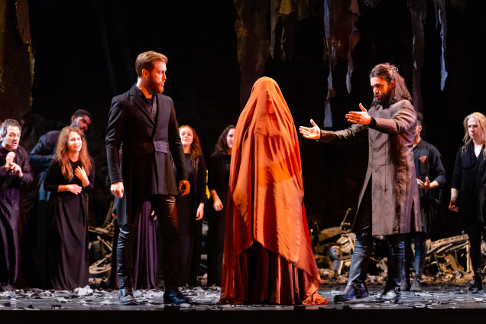 Athamus (countertenor Tim Mead),
Semele (soprano Amanda Forsythe),
and Cadmus (bass baritone Alex
Rosen).
Athamus (countertenor Tim Mead),
Semele (soprano Amanda Forsythe),
and Cadmus (bass baritone Alex
Rosen).
Matching her note for note in intensity and artistry is the sublime mezzo Daniela Mack, who has never been heard to better advantage as she doubled the disparate roles of Ino and Juno. As the former, she imbues her rich tone with a plangent world weariness that is melting, and heartrending in its ravishing effect. As the imperious Juno, Ms. Mack crackles with self-satisfied pomposity, her evenly produced vocalizing zinging out and dominating all within earshot. Her commanding, take-no-prisoners rendition of Iris, Hence Away was one of the evening’s several showstoppers, justifiably greeted with sustained roars of approval.
Erik Shrader’s substantial vocal gifts were also well displayed with his triumphant, strapping traversal of Jupiter. Having had ample chance to ravish us with some impossibly accurate and delightful rapid-fire melismas at full throttle, he plied his honeyed tenor and scaled it to nearly a filigree as he voiced a divinely sweet Where E’er You Walk. We scarced breathe, lest we break the sublime perfection of his music making.
Sarah Shafer was a sure-voiced Iris, displaying a wicked, uninhibited sense of comedy, all the while singing with secure freedom. Ms. Shafer’s creamy, gleaming soprano is a model of polished, poised perfection. She made a true star turn out of her rather licentious physicalization of the aria when she describes the pleasure palace that Jupiter has created for Semele.
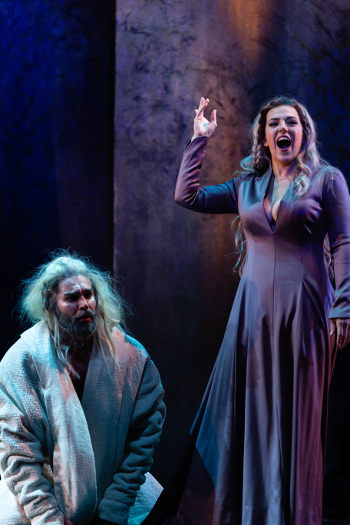 Alex Rosen as Somnus and Daniela
Mack as Juno
Alex Rosen as Somnus and Daniela
Mack as Juno
Alex Rosen does admirable double duty as Cadmus and Somnus. Mr. Rosen’s barrel-toned, massive bass made for a weighty, troubled Cadmus, and he spun out his arching phrases with luminous tone and impressive legato. As Somnus, this gifted singer imbues his assignment with a woozy sexiness, manly torso bared, lulled from sleep but now clearly ready to be on the prowl. This is a major vocal instrument and potent talent that is already impressive and promises much to come.
Tim Mead sported a secure, crystal clear countertenor in the small role of Athamas. His highly musical, incisive portrayal made us wish that Handel had given him more to sing, but even among this starry cast that had many meatier moments, Mr. Mead was memorably committed. This production includes an unscripted Principal Dancer, Lindsey Matheis, that is a shadow double of the hapless Ino.
Ms. Matheis was a key component of the concept’s success, as she hurled herself into anguished twisting and turns with total disregard for gravity. She was not alone in embodying churning emotions in movement, joined as she was by dance corps Justin Campbell, Sydney Donovan, Jesse Jones, and Daniel Mayo, who meticulously, tirelessly executed the inspired choreography by Gustavo Ramirez Sansano. While his devised movement recollected the work of Pina Bausch, Twyla Tharp, William Forsythe and others, Mr. Sansano provided his own vision, as the group ceaselessly writhed, rolled, tumbled, toted, and gesticulated to profound effect.
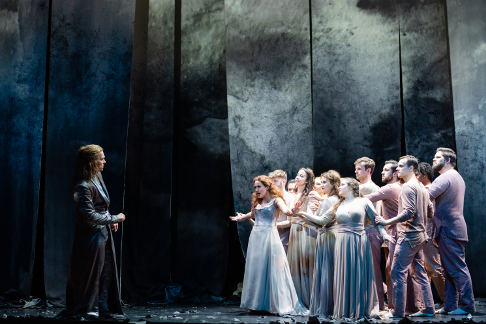 Semele (soprano Amanda Forsythe)
confronts Jupiter (tenor Alek Shrader) to
demand he appear to her in his immortal
form of thunder and lightning.
Semele (soprano Amanda Forsythe)
confronts Jupiter (tenor Alek Shrader) to
demand he appear to her in his immortal
form of thunder and lightning.
In the program notes, director James Darrah discussed the evolvement of movement in his interpretation of the piece. Indeed, the entire evening was not so much enacted as danced, with Elizabeth Braden’s excellent chorus joining in with awesome singing and uninhibited physicality. The precision of their execution was in fact one of the production’s true glories.
Mr. Darrah has fostered finely detailed characterizations, along with wholly understandable relationships, no small feat in a plot that, even after you have carefully read the synopsis twice, still makes you go “Huh?”. This gifted director leads us on an inevitable journey that illuminates and defines the composer’s intent. He has immense help from this creative team.
Emily Anne MacDonald and Cameron Jay Mock’s set and lighting design are a work of art from start to finish, morphing effortlessly as the story develops. As we enter the theatre we see a cloth sculpture enveloping the stage with ragged sheets of muted fabric hanging from the flies. The fire of Juno glows in a rugged cauldron. The ropes and rails are visible stage right. The whole impression is a bit chaotic, highly theatrical, with copious bits of paper strewn on the stage like so many dead (what?) leaves. Thanks to the cast’s tortured swirling on stage I would imagine the orchestra pit unintentionally inherited more than a few of these slips of paper as they flew about.
As we move to Jupiter’s realm, the cloths descend, spread, and smooth out to form a forest of hiding places that completely masks the stage. It is at this point that Adam Larsen’s atmospheric and fanciful projections really come into their own, brightening the gloom and adding innumerable whimsical touches. Sarah Schuessler’s fantastical costumes are indescribably varied and vivid. They aptly bridge the span of the two kingdoms and are so eye-popping and evocative that they greatly enhance the understanding of each and every character.
I hope that Philadelphia realizes the importance of this company and this annual event. I have been fortunate to have attended major festivals around the world and can state unequivocally that O19 can match any of them for quality, daring, originality, and artistic imagination. This nonpareil presentation of Semele is just one more example of Opera Philadelphia’s reliable standard of excellence.
James Sohre
Semele
Music George Frideric Handel
Libretto derived from a drama by English playwright William Congreve
Semele: Amanda Forsythe; Jupiter: Alek Shrader; Juno/Ino: Daniela Mack; Athamas: Tim Mead; Cadmus/Somnus: Alex Rosen; Iris: Sarah Shafer; Principal Dancer: Lindsey Matheis; Conductor: Gary Thor Wedow; Director: James Darrah; Choreographer: Gustavo Ramirez Sansano; Set and Lighting Design: Emily Anne MacDonald and Cameron Jay Mock; Costume Design: Sarah Schuessler; Projection Design: Adam Larsen; Wig and Make-up Design: David Zimmerman; Chorus Master: Elizabeth Braden
image=http://www.operatoday.com/SEMELE%2010.png image_description=Semele (soprano Amanda Forsythe) escapes her wedding and ascends to the realm of the gods to be with Jupiter. [Photos by Dominic M. Mercier for Opera Philadelphia] product=yes product_title=O19: Fiery, Full-Throated Semele product_by=A review by James Sohre product_id=Above: Semele (soprano Amanda Forsythe) escapes her wedding and ascends to the realm of the gods to be with Jupiter.Photos by Dominic M. Mercier for Opera Philadelphia
September 20, 2019
O19: Edgy, Haunting Denis & Katya
Composer Philip Venables and Librettist Ted Huffman’s unsettling, unconventional new opera Denis & Katya challenges the ear, the eye, and the soul to accept a wholly new hybrid form of operatic expression.
This is a performance quite unlike any most have ever experienced. The evening begins not with an overture, but with two actors taking turns narrating three pages of exposition, stage directions, really, that mysteriously allude to two Russian teenagers who have run off together and barricaded themselves in a house in remote Pskov.
The next effect that follows is a projection of texts as they are being written, appearing on a screen filling the upstage. There are pitched bleeps and bloops as each word appears, that form an important, disquieting, even intrusive part of the musical tone scape.
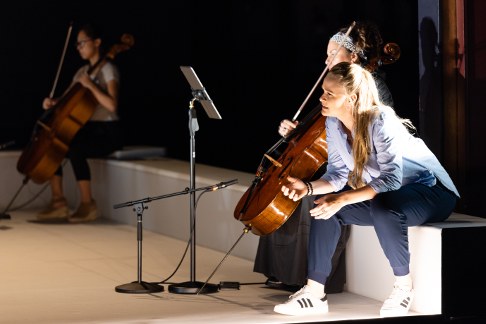
When the “orchestra” finally plays (magnificently) it is in the form of a quartet of cellists, placed at each of the four corners of the stage. Branson Yeast, Rose Bart, Jean Kim, and Jennie Lorenzo play sumptuously as an ensemble, while also proving to be first rate soloists in their own right. The large range of colors and effects they conjure up surely owes a good deal to Emily Senturia’s precise musical direction.
While the piece is about the two title characters, one of the most telling creative decisions is: We never meet them. They are the impetus for the composition, but not the performers in it. If all of this this sounds disquieting and disjointed, it is meant to be.
For the creative team have set out to question how responsibly we communicate in today’s world of technology. The source story that went viral on the Internet concerns the real life Denis and Katya, whose parents do not want them to be romantically entwined, and who rebelled, not unlike a latter day Romeo and Juliet. They ran away and hid in a cabin and began streaming live video of themselves.
(Spoiler Alert) Having fought violently with Katya’s family who came and confronted them, they barricaded themselves for three days. As they discovered guns in the cabin, and began using them against authorities who threatened them, they widened their streaming audience considerably. By the time Special Forces got engaged, the story had multiplied exponentially, had reached the networks, and was being seen by thousands around the world, sparking conspiracy theories and even fan sites. As the world watched with interest and alacrity, it did not end happily.
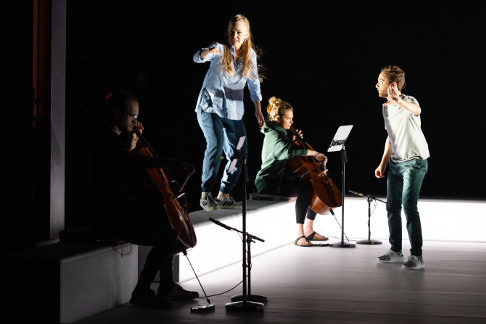
Communicating this multi-faceted storyline to compelling effect fell to two superbly gifted performers, Siena Licht Miller and Theo Hoffman.
Mezzo Miller not only has a lovely and sincere stage presence, but also sports a ripe lyric mezzo that seems to know no bounds. She is called upon to impersonate The Journalist (a fact finder who struggles to remain objective), The Neighbor (who screams with hysterical abandon), and shares the dual roles of The Teacher and The Medic with her fellow cast member. Ms. Miller’s effortlessly fluid vocalizing and warmly appealing timbre are richly colored and dramatically compelling.
Having heard and admired baritone Hoffman on numerous occasions, it is a pleasure to report that he just keeps getting better and better. He displays total command and understanding of The Friend (who tries to understand the tragedy), The Teenager (who languishes in deep despair), and the afore-mentioned pairing with Ms. Miller to voice The Teacher and The Medic. His pointed, awesomely controlled singing is not only ravishingly potent in the dramatic outbursts but also stunning in its heartrending, limpid head voice effects.
The two singers succeed commendably at embodying these six iconic characters who re-tell the couple’s story from very different viewpoints, with text and music often intertwining to create an enriching, mystifying mosaic of sound and commentary. The pair could not have been bettered in their accomplishment.
The physical production is deceptively simple. As the audience enters the Suzanne Roberts Theatre, the open stage is seen edged by a low white bench that outlines stage right, upstage, and stage left. Instrumentalists sit on it spread out to the four corners, while actors sit, climb, and cavort on it as appropriate. The wings are open to the actual stage walls. A large projection screen fills the upstage.
Andrew Lieberman’s set design has more than a few tricks up its sleeve thanks to the same Mr. Lieberman’s complementary lighting design which dazzles and surprises. The neutral looking fence of seating is actually wired up with blinding interior white lights that startlingly heighten the tension at just the right times. His often austere area lighting melds into just the right warmth to underscore the anguish of the characters’ emotional states, and his use of isolated spots is as effective as his fearless use of darkness.
Pierre Martin has devised a miracle of a video design. I will not soon forget the seemingly endless loop of the train departing the station and traversing the countryside after a critical dramatic climax. The annoying appearance and sound of the texts appearing was another master stroke. Rob Kaplowitz has contributed a spot-on sound design that is subtly effective, and the amplification of singers and players is well controlled. Millie Hiibel’s well-coordinated neutral costumes were admirable in their understatement.
Librettist Ted Huffman is also the production’s director and he has brilliantly coaxed natural performances from both Ms. Miller and Mr. Hoffman. He moves the characters around the playing space with meaning, and uses every possible level and traffic pattern. The only set pieces are two folding chairs brought on and removed by the actors. All in all, Mr. Huffman has succeeded in pulling together all the disparate elements inherent in the characters’ reactions to this viral happenstance, and forces us to consider our own complicity in participating in such a tragedy, whether by commenting or simply by passively watching it unfold.
Mr. Venables’ score is a wholly unique aural palette. The deep, often mournful keening of the cello sound grounds the composition in a suitable Russian melancholy. But there are ample flashes of brilliant overtones, and agitated writing as well to complement the often declamatory, angular vocal lines. It was a pleasure to encounter a composer new to me, whose work was forward-looking, yet abundantly accessible. While the score displays parallel influences of other notable contemporary composers, it is decidedly sui generis.
That Denis & Katya defies expectations of what opera should be is one of its real strengths. It is also the source of a couple of questionable choices. The opening, spoken exposition goes on so long that I was wondering when they would ever sing. Later, the very long stillness after the penultimate climax was unnerving in its duration. However, I concede that after a bustling onslaught of images; continual shifts between character fragments; now-singing-now-talking; and projected texts that command our immediate attention like Pavlov’s dog; when there is finally nothing to distract us, in that deadly stillness, we are (gasp) just alone with our thoughts about all of this and our role in it all.
I wish there were music sooner in the evening. I wish that there were more emotional engagement, a bit more sentiment than matter-of-fact in the writing. In the end I greatly admired the result, when what I wanted is to be greatly moved by it. I think that potential is yet lurking just inside.
That said, with Denis & Katya, O19 has produced another first rate operatic experience, a highly effective production that should be seen by anyone who cares about the future of the art form.
James Sohre
Denis & Katya
Music by Philip Venables
Libretto by Ted Huffman
Cast: Theo Hoffman, Siena Licht Miller; Director: Ted Huffman; Co-Creator and Dramaturg: Ksenia Ravvina; Music Director: Emily Senturia; Scenic and Lighting Design: Andrew Lieberman; Costume Design: Millie Hiibel; Sound Design: Rob Kaplowitz; Video Design: Pierre Martin
image=http://www.operatoday.com/Denis%20and%20Katya%208.png image_description=Baritone Theo Hoffman and mezzosoprano Siena Licht Miller [Photo by Dominic M. Mercier for Opera Philadelphia] product=yes product_title=O19: Edgy, Haunting Denis & Katya product_by=A review by James Sohre product_id=Above: Baritone Theo Hoffman and mezzosoprano Siena Licht MillerPhotos by Dominic M. Mercier for Opera Philadelphia]
September 19, 2019
Roméo et Juliette in San Francisco
The French have long known how to create librettos that tell simple stories in beautiful arias and duets. Even minor characters are given at least an arietta to show off their voices. Gounod offers his French choruses plenty of opportunity to harmoniously intervene with action or comment, and the French really do like the elegant movements of ballet.
Conductor Yves Abel, a splendid Rossini conductor, knows how to achieve the expanses of lyricism that suspend all sense of time. And this he did effect last night from the War Memorial pit for Charles Gounod.
Such was the case as well with the Roméo of tenor Pene Pati who soared effortlessly through Gounod’s lovely lines with grace and elegance. He brought smooth, youthful energy to the role, and a long held, full voiced, beautifully produced high C that set a new benchmark for tenors who attempt such things.
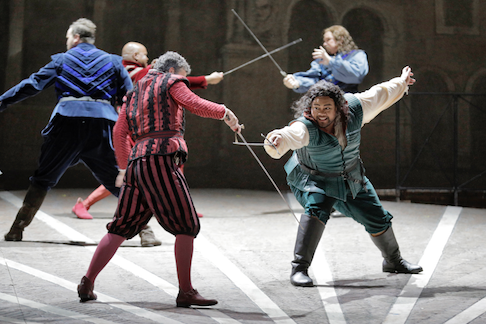 Daniel Montenegro as Tybalt, Pene Pati as Roméo
Daniel Montenegro as Tybalt, Pene Pati as Roméo
Young opera star soprano Nadine Sierra as Juliette brought brilliance of tone to her showpiece arias of extravagantly intricate lines and demanding fioratura. She found lyricism that flowed effortlessly with Mr. Pati in the extended love duets that you wished would go on forever. There was genuine, apparent emotional involvement between the two lovers at their deaths, Gounod’s lovely music delicately touching our hearts.
Of note was Stephano’s (Roméo’s page) aria splendidly sung by young mezzo Stephanie Lauricella who faced off with Adler Fellow SeokJong Baek as an energetic, fine voiced Gregorio to start the melée that provokes the deaths of Tybalt and Mercutio. Adding to the ideal of youth wished by Gounod was the Count Paris (Juliette’s intended) of baritone Hadleigh Adams.
The balance of the casting is inexplicable. Baritone Lucas Meachem played Mercutio as a blustery, look-at-me Figaro who belted out the Mab, Queen of Dreams. Tenor Daniel Montenegro sang a fine, small voiced Tybalt and might have fit into a production that attempted to integrate qualities of voice and of figure. Baritone Timothy Mix was Juliette’s twitchy father who had no sense of French phrasing. James Creswell as Friar Lawrence did not exude any apparent vocal or histrionic sympathy whatsoever for the young lovers in his rough voiced marriage ceremony, and bass-baritone Philip Skinner, maybe tired out from his well executed Dansker in Billy Budd the night before, was simply vocally spent.
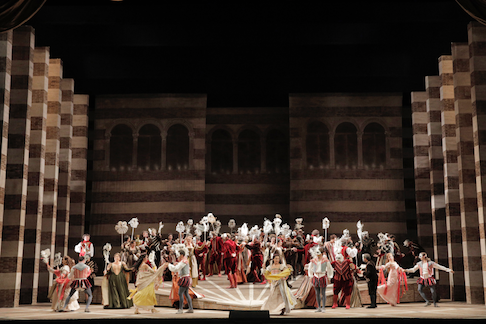 Act I
Act I
The budget production, such as it was, originated in 2012 at the Teatro Carlo Felice in Genoa (with Andrea Bocelli as Romeo), then traveled to Monaco for three performances in 2014 at the Grimaldi Forum (the sumptuous Opéra Garnier was closed for renovation). The unattractive sets attempt to approximate some sense of medieval Verona, eschewing any sense of the opulence and elegance of Napoleon III’s Second Empire and its arts. The staging by the production’s original director Jean-Louis Grinda (general director of the Opéra de Monte Carlo) was perfunctory.
Whatever happened to the splendid 2005 Ian Judge L.A. Opera Roméo et Juliette production? Lacking an appropriate production to rent (surely San Francisco Opera knew the quality of this production) why did the Opera not opt for a white box, a few props and Rigoletto costumes (after all Mantua is not far from Verona) — the San Francisco Ballet scored a huge success with its famed, magnificent blank-stage Prokofiev Romeo and Juliet in 1977.
Michael Milenski
Cast and production information:
Romeo: Pene Pati; Juliet: Nadine Sierra; Mercutio: Lucas Meachem; Friar Lawrence: James Creswell; Count Capulet: Timothy Mix; Tybalt: Daniel Montenegro; Duke of Verona: Philip Skinner; Stephano: Stephanie Lauricella; Gertrude: Eve Gigliotti; Gregorio: SeokJong Baek; Benvolio: Christopher Oglesby; Paris: Hadleigh Adams. Chorus and Orchestra of the San Francisco Opera. Conductor: Yves Abel; Stage Director: Jean-Louis Grinda; Set Designer: Eric Chevalier; Costume Designer: Carola Volles; Lighting Designer: Roberto Venturi; Fight Director: Dave Maier; Choreographer: Lawrence Pech. War Memorial Opera House, San Francisco, September 18, 2019.
image=http://www.operatoday.com/RomeoJuliet_SFO1.png
image_description=Photo by Cory Weaver courtesy of San Francisco Opera
product=yes
product_title=Tosca in Marseille
product_by=A review by Michael Milenski
product_id=Above: Nadine Sierra as Juliette, Pene Pati as Roméo
All photos copyright Cory Weaver courtesy of San Francisco Opera
GSMD and ROH announce Oliver Leith as new Doctoral Composer-in-Residence 2019-2022
Guildhall School of Music & Drama in association with The Royal Opera today announces Oliver Leith as the fourth Doctoral Composer-in-Residence, starting in September 2019.
Launched in 2013, the collaboration between Guildhall School and The Royal Opera is one of the first examples of an opera company and conservatoire joining forces to offer a Composer-in-Residence studentship which leads to a doctoral degree. Fully funded by Guildhall School and supported by The Royal Opera, the studentship offers one composer every two years the opportunity to be Doctoral Composer-in-Residence over a three-year period. During this time, the composer researches and writes a major work, which is staged by The Royal Opera at the end of the residency.
Leith’s forthcoming opera will explore how to create a theatrical world in opera, through the shifts between diegetic and non-diegetic sounds (sounds audible to actors versus sounds meant only for the audience) a convention regularly used in film to support creation of mood and atmosphere. He will take inspiration from moments in cinema that have made a particularly strong impression on him. He is especially interested in exploring ways of composing that start from a visual, rather than textual, stimulus.
Oliver Leith said of his appointment: ‘I am excited to be a fly on the wall at The Royal Opera and cannot wait to start working on something with them and my alma mater, Guildhall School, as I experiment and question what opera means to me. This is a unique collaboration between institutions of which I am thrilled to be a part.’
Having studied composition at undergraduate (2009-2013) and masters (2014-15) level at Guildhall School, supported by The Countess of Munster Trust and Guildhall School Trust, Leith has gone on to win a British Composer Award in the small chamber category (2016) and the Royal Philharmonic Composition prize (2014). He has been commissioned by groups such as London Sinfonietta, Festival Aix-en-Provence, London Symphony Orchestra, Tanglewood Music Festival, Heidelberg Festival, Musicon, Homo Novus/Valmiera theatre and St John’s Smith Square.
He has also collaborated with Apartment House, Ives Ensemble, EXAUDI, Plus Minus, Philharmonia Orchestra, An Assembly, Trio Catch, GBSR Duo, Loré Lixenberg, 12 Ensemble, Explore Ensemble, Matthew Herbert and John Harle. His music has been performed in many key venues across the world including: the Royal Festival Hall, Barbican, Wigmore Hall, Kings Place, Snape Maltings, Liszt Academy (Budapest), Maison du Canada (Paris) and Leeds Lieder. His music has also been broadcast on BBC Radio 3 and NTS Radio.
Professor Julian Philips, Head of Composition, Guildhall School said: ‘Guildhall School’s Composition Department is delighted at the continued flourishing of this unique doctoral Composer-in-Residence scheme. Composer Oliver Leith is one of the most distinctively expressive voices on the new music scene today and we look forward to supporting the development of his new over the coming three years.’
Kate Wyatt Creative Producer, The Royal Opera, said: ‘We are thrilled to be working with Oliver Leith, our fourth Doctoral Composer-in-Residence, who is developing such a distinctive body of work. Developing artists and new work is vitally important for us, and our brilliant partnership with the Guildhall School of Music & Drama is key to this, enabling us to make the most of the learning opportunities and to provide a context and framework to nurture and produce opera with a new generation of artists. The Linbury Theatre is a place for brilliant storytelling, world class music making and above all, great theatre. Oliver’s music, often starting with the visual, grounded in human themes and exploring the poetry in the everyday and his collaborative approach to creation is a natural starting point for us to explore new ways of making opera together. We look forward to working with him, as he develops his processes over the course of the next three years.’
Matt Rogers is the current Doctoral Composer-in-Residence and this year enters his final year in the role, having joined the programme in September 2017. His opera She Described it to Death, featuring a libretto by Sally O’Reilly, takes its inspiration from a future hindered by over-population, to which a sci-fi angle brings an intriguing solution, and new problems of its own. It receives its world premiere performances at the Linbury Theatre, Royal Opera House from Friday 17 July - Tuesday 21 July 2020.
The second recipient, Na’ama Zisser, premiered her first opera Mamzer Bastard in June 2018 at Hackney Empire. The story is set within the Orthodox Jewish community and Zisser merged her own musical idiom with the music of Orthodox Hasidic Judaism: it was one of the very first operas to feature and reference cantorial music & singing. It featured the lead cantor of Hampton Synagogue, New York Netanel Hershtik in the role of David, a cantor in the plotline.
Philip Venables was the inaugural Doctoral Composer-in-Residence and his opera 4.48 Psychosis, which premiered in May 2016, has won numerous awards including the UK Theatre Award for Achievement in Opera (2016), the Royal Philharmonic Society Award for Large-Scale Composition (2017) and the British Composer Award for Stage Work (2017). It was also nominated for the Olivier Award for Best New Opera Production (2017) and the South Bank Sky Arts Award for Best Opera (2017). 4.48 Psychosis is currently being performed at Muscia Festival Strasbourg
The studentship aims to offer an enriching model of opera development that allows a composer substantial creative research experience in the development of operatic practice, within the setting of a unique collaboration between an opera company and conservatoire. It allows for both critical reflection and creative research, in both professional and academic contexts. Leith will be supervised, from Guildhall School, by Professor of Composition Dr Richard Baker, together with Head of Composition, Professor Julian Philips as well as Kate Wyatt, Creative Producer at The Royal Opera.
In addition to the Doctoral Composer-in-Residence, Guildhall School offers an MA in Opera Making and Writing in association with the Royal Opera House. Launched in 2014, this full-time, one-year Masters programme allows composers and writers to focus on how new opera is created, developed and performed.
image=http://www.operatoday.com/Oliver%20Leith.jpgMartinů's gripping Greek Passion from Opera North
After its rejection by Covent Garden, which had originally commissioned the work for performance (in English) in 1958, the opera was extensively revised, including the removal of its spoken dialogue, and it premiered in Zurich in 1961 - two years after the composer’s death.
Based on Nikos Kazantzakis’s novel Christ Recrucified and staged in its reconstructed original version, the work’s moral weight, underlining humanity's grim record of spiritual and political failure, comes at a time when its plea for tolerance and Christian charity could not be more relevant. It is no coincidence that in recognition of its initiatives for refugees and asylum seekers Opera North is the first opera company in the UK to be awarded Theatre Company of Sanctuary status.
So why has this score taken so long to be fully appreciated? It’s very much a people’s opera; direct, uncomplicated and very moving. It tells the tale of a remote Greek community preparing for its traditional Passion play. Disturbed by the arrival of a group of starving refugees whose homes have been burnt by neighbouring Turks, the villagers are divided between offering help and turning their backs. Along the way, those cast in the Easter play begin to assume aspects of the characters they portray and as Manolios (the local shepherd boy) as Christ and his Apostles grow quite literally into their roles the village elders fear for their own spiritual authority and a fatal outcome is the tragic denouement.
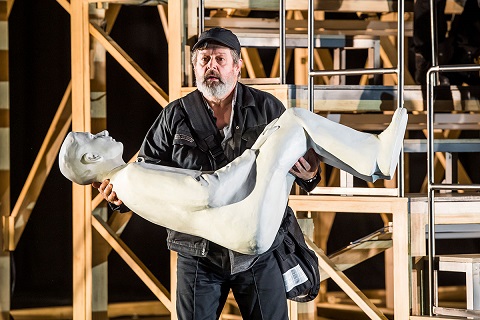 Paul Nilon (Yannakos). Photo credit: Tristram Kenton.
Paul Nilon (Yannakos). Photo credit: Tristram Kenton.
Director Christopher Alden opts for a minimal set and modern dress and, with designer Charles Edwards, provides an unflinching commentary on society’s response to asylum seekers, representing the refugees as lifeless mannequins - a nod perhaps to Anthony Gormley’s figures, with their identical and expressionless faces. But right at the start, before the villagers appear for their Eastertide lots, a lone plaster figure is seen carried off stage, an ambiguous gesture conveying kindly support or calculated removal. Consideration for the refugees is shown by Manolios (Nicky Spence) and Katerina/Mary Magdalene (Magdalena Molendowska) who offer food and shelter the refugees on a nearby mountainside, its steep contours evoked by the tiered staging. Indifference comes from the village’s cold-hearted priest Grigoris (Stephen Gadd) who blames the death of one of the newcomers on cholera, and the refugee’s corpse floats skywards but remains visible to haunting effect.
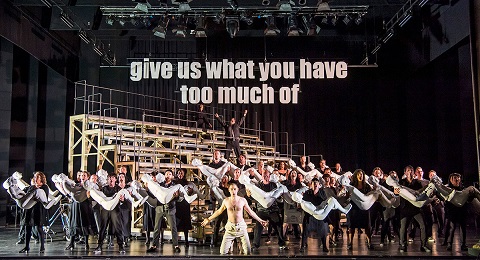 John Savournin (Priest Fotis, front), Paul Nilon (Yannakos, back) with the Chorus of Opera North. Photo credit: Tristram Kenton.
John Savournin (Priest Fotis, front), Paul Nilon (Yannakos, back) with the Chorus of Opera North. Photo credit: Tristram Kenton.
Alden has updated some of the text, including a humorous cry of “bloody vegans”, and the refugees’ plea “give us what you have too much of” hangs in block lettering over the stage as a reminder of their plight. Lighter touches include an egg-throwing Easter Bunny (its ritualistic generosity clearly only temporary), an onstage Klezmer-style trio play for the rustic wedding celebrations of Niklios (Alex Banfield) and Lenio (Lorna James), and a local postman Yannakos (Paul Nilon) who makes his deliveries on a bicycle. Beyond these comic interventions, there is a dark centre to this staging, most obviously conveyed by Manolios whose burden of a wooden cross forms the work’s central drama within a drama.
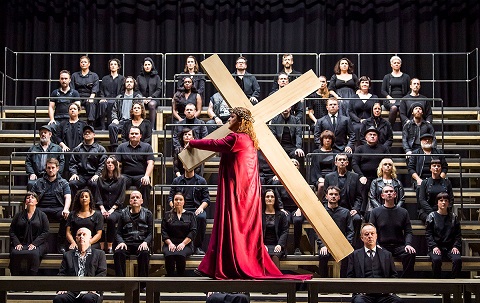 Nicky Spence (Manolios), with the Chorus of Opera North. Photo credit: Tristram Kenton.
Nicky Spence (Manolios), with the Chorus of Opera North. Photo credit: Tristram Kenton.
Musically, The Greek Passion dazzles too, weaving its spoken text into an eclectic procession of styles bearing cinematic delivery: Greek Orthodox chant rubs shoulders with folk-inspired passages, opulently scored scenes yield to a single strand with ethnic colouring, and there’s even a passage straight out of Music Theatre redolent of Leonard Bernstein. Above all, it’s a vivid score marked by an ardent lyricism, to which the Orchestra of Opera North under their musical director designate Garry Walker respond with much refinement.
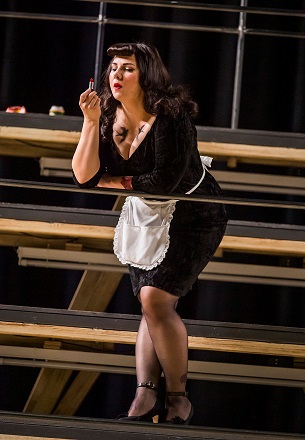 Magdalena Molendowska (Katerina). Photo credit: Tristram Kenton.
Magdalena Molendowska (Katerina). Photo credit: Tristram Kenton.
There’s tremendous commitment too from a well-chosen cast that includes the radiant soprano of Magdalena Molendowska, Nicky Spence’s clarion tenor, as the tormented Manolios, and a well-projected Paul Nilon as the appealing Yannakos. Stephen Gadd wields a rich baritone as the assertive and scheming Priest and John Savournin commands our sympathy as the refugees' spiritual guide, Fotis. Jeffrey Lloyd-Roberts convinces too as a beer-swilling Judas, as does Steven Page's Captain, an addled war veteran. Finally, the expanded Opera North Chorus are all on excellent form, relishing their sacred and secular input.
David Truslove
Grigoris - Stephen Gadd, Archon - Jonathan Best, Captain - Steven Page, Schoolmaster - Ivan Sharpe, Father Ladas - Jeremy Peaker, Kostandis - Richard Mosley-Evans, Dmitri - Christopher Nairne, Manolios - Nicky Spence, Yannakos - Paul Nilon, Michelis - Rhodri Prys Jones, Panait - Jeffrey Lloyd-Roberts, Andonis - Campbell Russell, Nikolio - Alex Banfield, Lenio - Lorna James, Katerina - Magdalena Molendowska, Fotis - John Savournin, Despino - Amy Freston, Old Man - Dean Robinson; Director - Christopher Alden, Conductor - Garry Walker, Set/Lighting Designer - Charles Edwards, Costumes - Doey Lüthi, Choreographer - Tim Claydon, Chorus and Orchestra of Opera North.
Grand Theatre, Leeds; Saturday 14th September 2019.
image=http://www.operatoday.com/Greek%20Passion%20title%20image.jpg image_description= product=yes product_title=Martinů’s The Greek Passion: Opera North, Grand Theatre, Leeds product_by=A review by David Truslove product_id=Above: Nicky Spence (Manolios), Rhodri Prys Jones (Michelis), Paul Nilon (Yannakos) and Richard Mosley-Evans (Kostandis)Photo credit: Tristram Kenton
September 18, 2019
A thought-provoking ROH revival of Massenet’s Werther
If the Royal Opera’s revival of Benoît Jacquot’s 2004 production of Werther was in anyway rescued it was almost entirely down to the conductor, Edward Gardner, and the magnificent playing of the orchestra. It was, in fact, rather symphonic, almost epic in scale. I’ve often found Gardner willing to linger, almost be rather self-indulgent, in his conducting, but here he was quite the opposite - fluid, lithe, yet more than capable of generating a searing passion in the orchestra’s playing, something which was often missing on stage. Acts I (especially) and II still, typically, felt much longer than they were - but this is so common in this opera one just expects it. I’ve rarely heard a more thrilling, more Wagnerian, opening to Act I - but then Massenet rather loses the plot until the staggering depth he somehow brings to Act III. And perhaps it was down to the exceptionally powerful and urgent conducting of Gardner, but this is where the evening turned into something that veered towards being memorable. Just a little of Tristan to wash away whatever had happened before.
Jacquot’s production is in the tradition of Grand Opera, the height and depth of it often impressive. It’s undeniably elegant, though I’m probably not the only one who found the design of Act II giddying, nor the long corridor of open doors in Act III, centre stage, a little derivative of Velasquez’s Las Meninas. There are moments the design seems out of sync with the libretto - Johann and Schmidt, perched on a wall drinking, yet singing of a beautiful day under a gorgeous sun when the backdrop is of a sky leaden with thunder, seems careless. The assumption that cluttered stages make for clumsy acting is often correct, but Jacquot’s idea that huge sets dominate here works both for and against this production. As a depiction of a couple whose passion is a conflict of the platonic and the sexual, of the intimate and the distant, and of the hopeful and the tragic the sheer size of the staging can only really portray one element of this at the expense of the other. But perhaps the staging was an irrelevance because there was little in the way of intimacy, sexual or otherwise, between Juan-Diego Florez’s Werther or Isabel Leonard’s Charlotte.
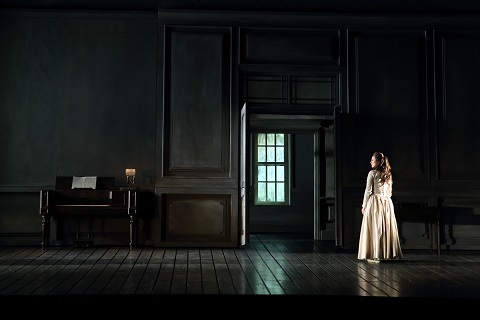 Isabel Leonard (Charlotte). Photo credit: Catherine Ashmore.
Isabel Leonard (Charlotte). Photo credit: Catherine Ashmore.
I’m not really sure how much of this had to do with Florez himself, a singer whom I have often thought is very much an acquired taste. This was his first London Werther - though the role is not unfamiliar to him. It’s always been the case that Florez’s acting has been somewhat stilted, even unconvincing. What was interesting about the performance was that in the first two acts, which generally require the voice to have both longer lines and be more lyrical, it pressed him harder and strained him more. The unease was palpable, the voice clearly so small, especially at fortissimo, it was sometimes just ravaged by the orchestra. Yet, he was like a man reborn by Act III - if hardly of the suicidal bent. The youthfulness of the poet from earlier assumed a maturity which suddenly had depth and richness - this was a Werther in reciprocity with his Charlotte. Florez’s middle register has undoubtedly darkened over the past couple of years, it’s both fuller and richer - pretty much ideal for the Werther of Act III, which it clearly was here. His pianissimos were gorgeous, breath-taking in fact, and if the high A’s in Act III sometimes betrayed reserves of power that weren’t always available to him it was less obviously a problem than earlier in the evening.
There are better singers as Werther - Kaufmann, for example - who just seem to be tragic in this role. If Florez probably lacked soul, there was a softness to this portrayal which was touching. He probably benefitted from Gardner’s fluid tempo - any broader and I suspect Florez’s comfort zone would have been challenged to breaking point. This wasn’t a Werther which had the luxury of languishing in melancholy like Kaufmann’s, or broke the sound barrier like Domingo’s. This was a Werther which was sometimes elegant, sometimes a little stressed - but rarely sounding like Massenet.
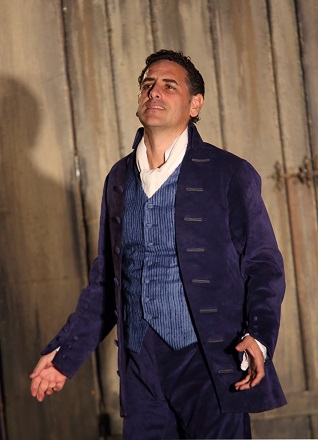 Juan Diego Florez (Werther). Photo credit: Catherine Ashmore.
Juan Diego Florez (Werther). Photo credit: Catherine Ashmore.
Isabel Leonard’s Charlotte, on the other hand, was impressive vocally, even if she was a little frosty in her acting (such a common thread of this production). There was something rather matronly about this Charlotte - a mother figure who seemed to emote distance from her sister and the children, a not entirely convincing bride of Albert (but not convincingly in a loveless marriage either), and in many minds about her poet, but rarely of guilt. Often, she felt like she was in completely the wrong opera. But there’s nothing quite like a letter scene to bring out the best in a singer-actress and Leonard was superlative. That middle-range mezzo, which can appear so stifling for such large sections of this opera, was used for all it was worth - and where Florez was inhibited in his acting, Leonard used everything at her disposal to dominate the stage. This big aria was a moment of revelation, the poise with which it was sung uncommonly tight. Her voice does have considerable colour when she chooses to use it against the orchestra - in Act III, her tones against both the saxophone and harps were both careful and subtle. Her vibrato can sometimes sound a little thick, but this is not a voice which sounds ungainly.
Heather Engebretson’s Sophie was perfectly cast. Of all the lead singers she probably came closest to Massenet’s libretto: adolescent enough, virginal, innocent and with a rock-solid soprano which stood in stark relief to that of her sister, Charlotte. Jacques Imbrailo’s Albert is in one sense miscast - every bit as attractive as the mystical poet, and with a depth and range to his baritone you really wonder why Charlotte feels as conflicted as she does. Jacquot’s vision of this opera, its grand gestures, and the focus on the triangle of tangled love, does leave little room for smaller roles to excel. A small gaggle of children, singing of Christmas, are bookended at either end of the opera - cheerily at the beginning, rather sinisterly at the end.
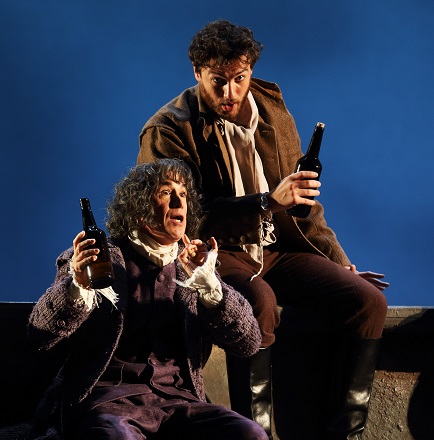 Michael Mofidian (Johann) and Vincent Ordonneau (Schmidt). Photo credit: Catherine Ashmore.
Michael Mofidian (Johann) and Vincent Ordonneau (Schmidt). Photo credit: Catherine Ashmore.
When this production works it’s hard to put a price on its merits. If one can get through the sheer boredom of the first two acts - and everything really suffers because of that - there is much to admire for the last hour (though you have spend two hours to get there). Florez and Leonard are compelling in Act III, and Werther’s death in Act IV is not without raw power. Florez is not entirely miscast; his is clearly not a verismo Werther but nor, I think, will it be to everyone’s taste.
Marc Bridle
Jules Massenet: Werther
Werther - Juan-Diego Florez, Charlotte - Isabel Leonard, Albert - Jacques Inbrailo, Sophie - Heather Engebretson, The Baili - Alastair Miles, Johann - Michael Mofidian, Schmidt - Vincent Ordonneau, Brühlmann - Byeongmin Gil, Kätchen - Stephanie Wake-Edwards; Director - Benoît Jacquot, Conductor - Edward Gardner, Revival Director - Andrew Sinclair, Set Design - Charles Edwards, Costume Design - Christian Gasc, Lighting Design - Charles Edwards, Orchestra of The Royal Opera House.
Royal Opera House, Covent Garden, London; Tuesday 17th September 2019.
image=http://www.operatoday.com/Massenet%20title%20Isabel%20Leonard%20%28Charlotte%29%20Juan%20Diego%20Florez%20%28Werther%29.jpg image_description= product=yes product_title=Massenet’s Werther at the Royal Opera House, Covent Garden product_by=A review by Marc Bridle product_id=Above: Isabel Leonard (Charlotte) and Juan Diego Florez (Werther)Photo credit: Catherine Ashmore
Bampton Classical Opera: Bride & Gloom at St John's Smith Square
That’s perhaps not surprising, if Stephen Storace’s comic opera Gli sposi malcontenti (The Discontented Newly-Weds) is evidence of what might await those who take the nuptial plunge: loneliness and longing, desolation and distress, if Storace’s librettist, Gaetano Bertati, is to be believed!
But, as always, Bampton Classical Opera’s Artistic Director, Jeremy Gray, has found witty ways to make Bertati’s characters’ misery the source of our own merriment in the company’s Summer 2019 production of Storace’s opera buffa, which arrived at St John’s Smith Square after performances at Bampton and Westonbirt. And, while the premiere performance of Gli sposi malcontenti resembled a wedding-day disaster - with Nancy Storace collapsing mid-aria in Act 1, bringing proceedings to a halt - there was no danger of such catastrophe at St John’s where the consistently accomplished cast of seven presented Bride & Gloom in Brian Trowell’s English translation, with charm, bonhomie and uniformly terrific diction. CHROMA provided light and lilting instrumental support, conducted by Anthony Kraus.
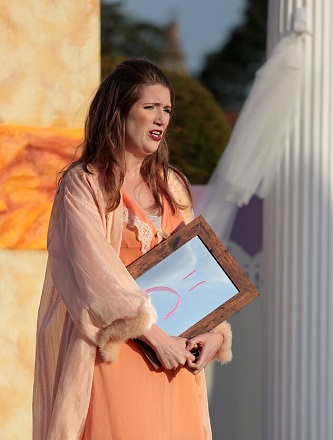 Jenny Stafford (Eginia).
Jenny Stafford (Eginia).
Gaetano Brunati’s libretto serves up the anticipated buffa recipe: a suspicious husband, a domineering father, a boorish boffin hell-bent on revenge, a pair of thwarted, scheming beloveds, and a wily maidservant. (See here for detailed synopsis and historical background.)
After their tantrums and tiffs as the self-centred sisters in Bampton’s 2018 production of Isouard’s Cinderella, Jenny Stafford and Aoife O’Sullivan returned here as the stepsister rivals for Artidoro’s love, demonstrating equal grace and style in shaping Storace’s tuneful melodies. As the emotionally conflicted Eginia, Stafford’s soul-searching was delivered with focus and gravity. Her opening cavatina - think the unhappy, abandoned Countess of ‘Porgi amor’ - was poised and affecting, and Stafford established a particularly convincing musico-dramatic stature before the concluding nocturnal disguises and denouements. O’Sullivan’s sporty, spirited Enrichetta was as adept at keeping a tennis ball aloft mid-aria as negotiating the vocal challenges, singing, as always, with unwavering security, and a well-centred and appealing tone.
 Gavan Ring (Casimiro).
Gavan Ring (Casimiro).
Gavan Ring’s vocal strength and character belied Casimiro’s blandness. Ejected from his marital bed, as he nestled under a blanket on the chaise longue Casimiro may have looked content with just a shabby teddy-bear for company. But, a superb performance from Ring drew forth a rich range of developing emotions and as Ring swelled sonorously to the tenorial high-points of Casimiro’s avowal of lingering love for Eginia, we understood that beneath the Barbour and flat cap was a burning, ardent heart. No wonder that Eginia eventually comes to appreciate his hidden merits and attractions.
Arthur Bruce’s relaxed baritone conveyed Artidoro’s easy charm and confidence, cockily tossing and bouncing a tennis ball, suavely anticipating the success of his elopement scheme. When, discovered by the suspicious Rosmondo hiding under a blanket in the chair, this Artidoro did not panic when threatened by the collapse of his strategy or the bullying jabs from Casimiro, whipping out a water-pistol with the panache and poise of Indiana Jones.
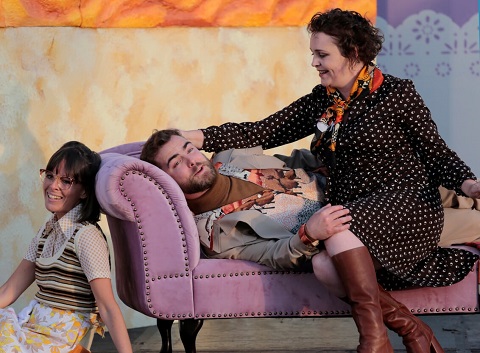 Caroline Kennedy (Bettina), Arthur Bruce (Artidoro), Aoife O'Sullivan (Enrichetta).
Caroline Kennedy (Bettina), Arthur Bruce (Artidoro), Aoife O'Sullivan (Enrichetta).
Rosmondo’s patriarchal pontificating was delivered with firmness and strength by baritone Robert Davies, who achieved the difficult task of being sufficiently mean to inject credible tension but not so menacing as to preclude compromise and reconciliation. Like Adam Tunnicliffe as Valente, Davies demonstrated a good instinct for physical comedy, both singers falling over and into the chaise longue, and the wedding-cake walls, with neat timing and without undue mishap.
Despite seeming almost to strangle himself with his academic hood, Tunnicliffe’s Valente blustered and raged with bite and colour, out-tricked by Caroline Kennedy’s vivacious Bettina - a put-upon but opportunist maid who was ever on the look-out for a swig from one of her employer’s wine bottles or a smoke from Artidoro’s joint. Tunnicliffe’s dark grain was a lovely complement for Kennedy’s light, graceful soprano, especially in their final duet in which Bettina dupes the disagreeable don into believing that she will collude in his conspiracies.
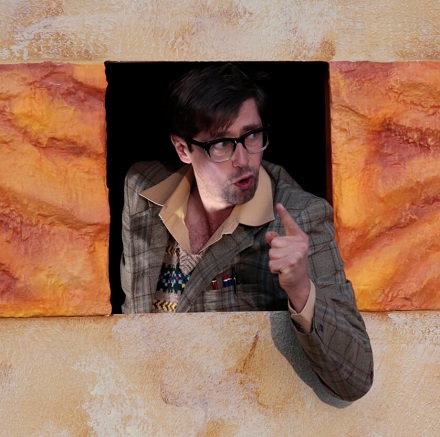 Adam Tunnicliffe (Valente).
Adam Tunnicliffe (Valente).
Storace evidently had a fine ear for a silky cavatina, a sure sense of how to shape an ensemble-finale, and the ability to create moments of heart-warming sincerity. His arias may lack a little variety of invention and tempo, but if he doesn’t equal Mozart for musical wit and dramatic sparkle then one imagines that the latter, into whose orbit Nancy’s success drew Stephen, was not entirely unconscious of Gli sposi malcontenti’s comic episodes - a romantic interloper discovered hiding in a chair, a climactic nocturnal escapade in a garden - when he penned Figaro the following year.
Gray’s simple, witty design essentially sets the action - given a Seventies feel by the prevailing harvest-gold and burnt-orange palette - inside a wedding cake, with the proceedings overseen by outsized Ken and Barbie look-a-likes in their nuptial finery perched atop a gigantic slice of frosted sponge. The busy ensembles were deftly handled, the confusions and conflicts which end Act 1 exploding in a storm of smoke, buttercream and confetti: the icing on the cake of an evening which ended, naturally, with sweet forgiveness and harmony.
Claire Seymour
Stephen Storace: Bride & Gloom
Eginia - Jenny Stafford, Casimiro - Gavan Ring, Enrichetta - Aoife O'Sullivan, Artidoro - Arthur Bruce, Rosmondo - Robert Davies, Valente - Adam Tunnicliffe, Bettina - Caroline Kennedy; Director/Designer - Jeremy Gray, Conductor - Anthony Kraus, Associate director - Alicia Frost.
St John’s Smith Square, London; Tuesday 17th September 2019.
image=http://www.operatoday.com/Robert%20Davies%20%28Rosmondo%29%2C%20Arthur%20Bruce%20%28Artidoro%29.jpg image_description= product=yes product_title=Bampton Classical Opera: Stephen Storace’s Bride & Gloom (St John’s Smith Square) product_by=A review by Claire Seymour product_id=Above: Robert Davies (Rosmondo) and Arthur Bruce (Artidoro)All images © Anthony Hall/Bampton Classical Opera
A new recording of Henze’s Das Floß der Medusa
Although a recording was made prior to this – conducted by the composer – it has taken half a century for a second one to appear. Das Floß der Medusa has perhaps become a work which symbolises the shipwreck it was composed to commemorate.
Das Floß der Medusa closely aligns with Henze’s left-wing politics, nurtured in Italy where Henze had exiled himself in 1953 because of his perceived intolerance of the German state to both his homosexuality and his Marxist views. It’s probably not coincidental either that he chose for his oratorio one of the most ignominious, and politicised, events in early nineteenth century French maritime history – the wrecking of the Meduse which ran aground off the coast of West Africa in 1816. The most obvious allusion Henze, or indeed any artist, composer or writer, could reference for this is Gericault’s painting which hangs in the Louvre.
The painting itself is vast – of such a monumental scale it appears almost life-sized. What Gericault paints is the moment of death, of bodies strewn naked and half-clothed; a few survivors are rendered helpless amongst corpses, in despair and beaten. Limbs are twisted and stiff, flesh pallid and decayed. There is the look of lunacy and madness in the expressions, a theme which would form much of Gericault’s output after this work as his painting took him deep into the abyss of French asylums. It is art as requiem. But the painting is in two halves, almost pyramidal to look at and it is this which Henze exploits in his oratorio. Henze has his chorus move from the left side of the stage to the right side – in essence, from the side of the living to the side of the dead. A baritone is the affirmation of life; a soprano an allegory of death.
The painting and the oratorio probably have more in common than first meets the eye. Although both works are particularly savage in their depiction of the shipwreck itself, both Henze and Gericault take an approach which is semi-documentary in style. Henze’s librettist, Schnabel, certainly had an agenda which was to give a socio-historical viewpoint of the events of 1816 as seen through the prism of 1967/8 – but this is little different than what Gericault was doing in the early nineteenth century. Schnabel’s allusions to Dante’s Divine Comedy, and to Charon, the Ferryman, which inspired Rachmaninoff in his Isle of the Dead, have some parallels in the painting, not least in the tones of the colours Gericault uses – even if the texts are never explicit.
But Henze’s Das Floß der Medusa is also a requiem for a fallen revolutionary hero – Che Guevara, who was killed in 1967. Painting and oratorio now diverge from their core purpose as Henze’s work begins to become a statement for its time: The conflict of class struggle, the inversion of parliamentary democracy, opposition to government. Even at its ill-fated premiere this division was palpable: Fischer-Dieskau was resolutely against the performance; Edda Moser was for it continuing.
It is certainly questionable whether Henze’s own recording of Das Floß der Medusa could ever really be bettered. The composer could be uneven in recording his own works – though this has much to do with the unevenness of the works themselves – but this oratorio is one of Henze’s most powerful pieces, even if it presents a challenge for both performers (technically) and audiences (contextually) alike. The 1968 recording does come from one of the rehearsals prior to the aborted premiere and as such is particularly well prepared – in fact, it’s of exceptional artistic quality. Audiences today will probably recoil slightly from Henze’s archaic message of revolution; European politics seems to be traveling in the reverse direction to Henze’s preferred one. It’s perhaps rather extraordinary that Dietrich Fischer-Dieskau should actually be so compelling on the Henze recording given his catholic, even conservative tastes; but politics does seem to have played almost no part in his choice of roles. The voice is powerful, and he is in command of his full vocal range. Likewise, Edda Moser can be both angelic but frigid as she embraces death. There is a wonderful sense of spatial transparency to the recording – you hear the choruses move from left to right, the timpani clearly in the centre. It’s one of those recordings, like Britten’s own of his War Requiem, which is just stamped with authority.
But this is an oratorio – indebted in many ways to Bach – and it relies as much on narration as it does on theatre. For a work that runs to just over seventy minutes, the narrative can be heavy-handed. Henze’s own narrator, Charles Regnier, is chilling enough (an almost essential requirement if one is reading the part of Charon) but convincing though he is the passages never escape being lengthy.
This new recording, made at the Hamburg Elbphilharmonie in November 2017, couldn’t have a better advocate in Peter Eötvös. Indeed, there are many things about this performance which just sound “right” – the acoustic, the clarity of the choral divisions, the spatial mystery of the work’s vision which alternates between horror and pathos. One could argue that the acoustic does little to emphasise the impact of contrast between life and death as the choruses move across the stage – this is, in one sense, an unremittingly darker performance than the one Henze gave us. Eötvös does, of course, use Henze’s 1990 revision of the score, one which tones down some of more obviously Marxist chants such as “Ho! Ho! Ho! Chi! Minh!” and there is clearly room today to interpret this oratorio beyond the events of the decade in which it was written. I think some performances of the work can still sound uncomfortable, perhaps this one doesn’t.
Peter Stein’s narrator (often the most difficult role to cast) is exceptional, but given his background this probably isn’t a surprise. This is such a nuanced, beautifully crafted reading of Charon it’s hard not to be persuaded by the mythology of the character. There is something Sophoclean about it, a depth which Henze didn’t particularly get from Regnier. The diction is impeccable – so much so I don’t think you particularly have to understand German fluently to understand what is being narrated. There is a printed libretto in the booklet, but in German only – but when Charon speaks “Dreihundertzweiundzwanzig Füsiliere, drei Dutzend Weiber, Kinder: neun” it’s not difficult to follow. A narrator can easily sermonise the text of this oratorio, but what Stein does so masterfully is direct himself as if performing in the theatre; often whilst hearing his narration it feels less like he is reading Henze and more like he is standing in front of Gericault’s painting and interpreting every horrific stroke of the artist’s brush.
There are no particular weaknesses with the soprano and baritone either. Camilla Nylund – a notable Venus in the past – has a powerful voice to cut through the orchestra; and yet, there is no lack of vulnerability either. But this is an assumption of La mort (Death) which seems as Sophoclean, too, in its reach as it is chilling and menacing. Some of Henze’s writing for the soprano is treacherous; the octave leaps and sudden vaults between notes – their very range almost alludes to a tragedy that is inevitable. Nylund sounds like a Siren, luring sailors from a shipwreck against the craggiest of rocks; it could almost have come from the pages of Homer. Peter Schöne’s Jean Charles is perhaps not quite in the same class as Fischer-Dieskau’s (as with many baritones in this role the struggle is with the orchestra). But he shares with his predecessor a lieder-like attention to detail and he is rarely short on conveying the horror of the events unfolding.
Henze’s choruses, especially the children’s chorus, were exceptionally well-drilled. That is the case here. Intonation is very clear, but what impresses is the harrowing intensity. The choruses fade from left to right, a fan of death which is coruscating in its power as the children drown in the waters first, a moment of almost shimmering unease in this recording, until only a handful of survivors survive. Eötvös is even more cataclysmic in driving the orchestral climaxes like crushing blows – those terrifying, thunderous hammers of percussion sounding like the severing of life. The Finale is just excoriating, a vision of hell which shatters the senses. It almost seems right that this recording should end in more than a minute’s silence.
As I mentioned earlier in this review, Henze’s recording was very much one for its time. Eötvös’s recording is very much one for our time. The booklet points out that today Das Floß der Mudusa has a contemporary topicality in the modern refugee crisis afflicting Europe in the Mediterranean. This doesn’t just make Henze’s oratorio more relevant; it also makes Gericault’s painting more relevant. Neither recording – Henze or Eötvös – is more essential than the other in my view because both are of exceptional artistic quality. Das Floß der Medusa is an uneven masterpiece, but its message could not really be lost on anyone who hears it.
Marc Bridle
image=http://www.operatoday.com/Henze%20-%20Das%20Flos%20der%20Medusa.jpg image_description=Henze: Das Floß der Medusa product=yes product_title=Henze: Das Floß der Medusa product_by=Camila Nylund (soprano), Peter Schöne (baritone), Peter Stein (narrator), Peter Eötvös (conductor)SWR Volkanensemble, WDR Rundfunkchor, Freiburger Domsingknaben, SWR Symphonie Orchester, product_id=SWR Classic [CD] price=$18.99 product_url=https://amzn.to/2LXgdEhSeptember 16, 2019
La traviata at the Palais Garnier
No longer the sad tale of a fallen woman and the illusions of her Parisian beau monde, of a dangerous infatuation and the vindication of simple country life, director Simon Stone’s tale was of a celebrity Parisian beauty who was dying of cancer, and her drunken lover whom she rejected by capitulating to his authoritarian father.
This gave conductor Michele Mariotti carte blanche to explore Verdi’s musical world in bold strokes. An enormous orchestral explosion confirmed the declaration of love in the second act, a shattering fortissimo announced the lovers’ separation. But before and above all else the maestro sought and found the musical beauty of the full throated voices — this splendid bel canto ideal drew us not into this oft told tawdry tale but into a world of high operatic art.
South African soprano Pretty Yende had to be both an icon of beauty in the French capital and a singer equal to the musical aspirations of the conductor. With a purity of voice and dramatic innocence she well fulfilled the first, and with a formidable technique plus a willingness to take vocal risks she well met the maestro’s expectations. It was beautiful singing, the brilliance of her upper voice was carried amply into her lower registers, she dared exaggerated pianissimos in “Dite alla giovane si bella e pura,” she glowed in her farewell aria “È tardi . . .”
Pretty Yende as Violetta ValeryMetteur en scène Simon Stone constructed a noisy counterpoint to the maestro’s bel canto. It was the nervous energy that seeps through the flashy Parisian veneer. There was actual noise from the grinding and creaking of the huge stage box that turned to reveal ever changing musical moments. The resulting cacophony of scenes invented by director Stone and his Australian designer Bob Cousins added both visual noise and conceptual noise to this real noise.
The huge box, missing two sides, sat on the revolving platform. The interior was empty white, though it took on significant accoutrement as it turned to color each of the revealed scenes — a gilded equestrian statue and one slowly dancing couple for “Sempre libera,” a live cow (milked by Violetta) for Germont’s Act II entrance, a chemotherapy lounge for the Act III prelude, among many other conceptually poignant, off-the-wall images.
The exterior sides of the two constructed walls were massive video screens that were first the show curtain as the closed eyes of Mlle. Yende, the lid of the left eye moving slightly from time to time (yes, this put us on edge). The video screens sometimes served to display frantic tweeting and news flashes, and more often the screens were covered with perfect roses (until an Act III scene when their pedals were burnt).
The walls provided backdrop as well for a kebab stand, and pointedly as backdrop for the trash bins that held the detritus of Parisian revelry, by extension, sadly, the fate of the opera’s true love. These among other striking, off-the-wall images — yes, it was indeed conceptually edgy.
A very drunk Alfredo appeared at Flora’s costume ball dressed as Daffy Duck (Simon Stone dressed the Duke of Gloucester as Mickey Mouse in his Salzburg Lear). The other guests in grotesque costumes (including a couple of misplaced prosthetic penises) were the sole decor in the choreographically-less white box of this spectacle scene. Australian theater costumer Alice Babidge dressed Violetta in an off-the-wall constructed white gown in which Mlle. Yende chose to appear to accept the extended ovations awarded her when it was all over.
While the Dumas fils La Dame aux camélias and the Piave Traviata were soundly destroyed, Verdi’s score did not suffer, taking on contemporary emotional rhythms, revealing a myriad of hidden resonances that made this Paris Traviata a completely new, compelling opera — a remarkable feat!
Benjamin Bernheim as Alfredo GermontTenor Benjamin Bernheim ascended the pyramid of champagne glasses to deliver his “Libiamo” with the worldly energy of this unique Alfredo. He played the drunken Alfredo to the hilt and sang the final duet “Parisian, o cara, noi lasceremo” with remarkably beautiful phrasing. By incising his lines with precision baritone Lodovic Térzier surmounted the dramaturgical challenge of transforming Germont into a titan of industry before whom nothing is refused.
Simon Stone plays with a heavy hand. His Salzburg Médée just now was not a success, the slightness of the piece disappearing into the torrents of information that infused his staging. The brilliance of this Verdi masterpiece in the confident hands of bel canto conductor Michele Mariotti achieved a presence that the excessive energies of the Stone staging always amplified, and never diminished, to the very great pleasure of the opening night audience.
Michael Milenski
Cast and production information:
Violetta Valery: Pretty Yende; Alfredo Germont: Benjamin Bernheim; Giorgio Germont: Ludovic Tézier; Flora Bervoix: Catherine Trottmann; Annina: Marion Lebèque; Gastone: Julien Dran; Barone Douphol: Christian Helmer; Marchese d”Obigna: Marc Labonnette; Dottore Grenvil: Thomas Dear. Chorus and Orchestra of the Opéra National de Paris. Conductor: Michele Mariotti; Mise en scène: Simon Stone; Set Design: Bob Cousins; Costumes: Alice Babidge; Lighting: James Farncombe; Video: Zakk Hein. Palais Garnier, Paris, France, September 12, 2019.
image=http://www.operatoday.com/Traviata_Paris1.png image_description= product=yes product_title=La traviata at Paris' Palais Garnier product_by=A review by Michael Milenski product_id=Above: The "Sempre libera"All photos © Charles Duprat, courtesy of the Opéra National de Paris.
San Jose Pops the Cork With Fledermaus
And like prime bubbly, the production tickled the senses and warmed the heart.
From the first downbeat, it was evident that conductor Michael Morgan achieved that rare happenstance: He elicited echt Viennese stylistic playing from a group of American musicians. That is not as easy as it seems. European bands usually effortlessly “live” this music, its subtleties are second nature to them. Rarely do American instrumentalists achieve this unity of nuanced purpose, that successfully suggests just the right elitist Kaffekultur ambience.
Maestro Morgan’s sure baton expertly finds the inevitable sweep of the waltz, the building excitement of the accelerandi, the spunk in the novelty numbers, and the melancholy in the introspective stretches. From first to last, this was wonderful music making and the first rate orchestra responded brilliantly. Moreover, Morgan is highly adept at partnering his superb singers.
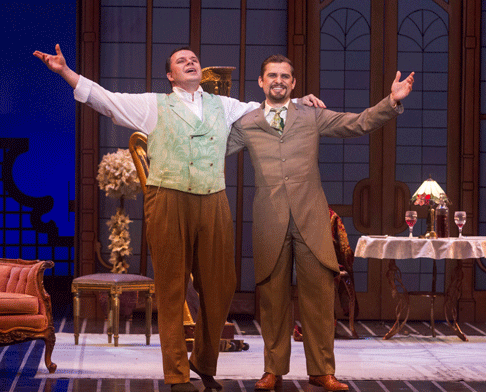
Maria Natale is a radiant Rosalinde. Her poised soprano sports a full-bodied, gleaming sheen, with a technique that is even from top to bottom. Her stately physical elegance does not prepare us for her eventual savvy comedic sensibilities. Whether cooing sweetly, exulting passionately, or teasing playfully, Ms. Natale found every bit of variety and color that are the hallmarks of a fine Rosalinde. Her Czardas was the hot-blooded showpiece it needed to be, from the searing opening declamations to the limpid and colorful folksy section to the ebullient urgency of the final allegro.
Eugene Brancoveanu’s animated von Eisenstein was altogether remarkable not just for vocal achievement but especially for theatrical inventiveness. Mr. Brancoveanu is possessed of a pliable, eloquent, burnished baritone that is capable of any effect from the sweetest of pleadings to the most potent of protestations.
His substantial physique makes him self-important and earth bound at first, but his total physical abandon in the duet with Falke was marked by hip bumps, leaps, and gyrations that hilariously suggested a cross between Baby Huey and Lola Falana. When he later impersonates Dr. Blind in the world’s rattiest wig with a comprimario twang, he has completely won us over to thinking that his is perhaps the definitive Eisenstein currently on stage. It is certainly the most animated.
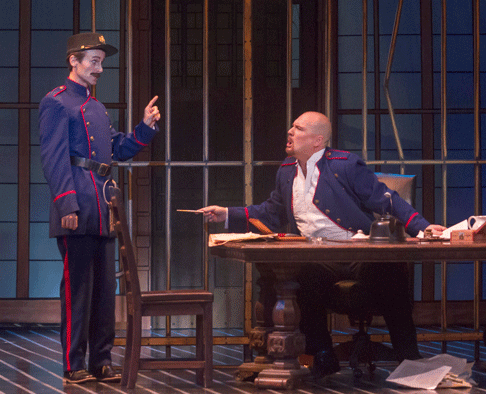
As Dr. Falke, Brian James Myer’s assured role traversal served notice once again that he is one of the finest actors and most accomplished young baritones of his generation. Mr. Myer has it all: A handsome charismatic presence, spontaneity and honesty in his acting, and a melting, rich tonal output. His Brüderlein was creamily delivered, an affecting highlight in an evening that was rife with riches.
Elena Galván’s perky Adele threw off plenty of spunk and sparks, making her a decided audience favorite. Ms. Gavan’s perfectly spun, silvery soprano caressed the ear as it effortlessly soared above the staff, below the staff, and all points in between. Her accurate coloratura provided much pleasure, and her bubbly personality and wicked sense fun proved infectious. As her sister Ida, Ellen Leslie made the most of her brief moments as she showed off her bright, pure soprano.
The scent of ham was in the air as the engaging tenor Alexander Boyer snacked on the scenery as a suitably over-the-top Alfred. Mr. Boyer’s gorgeous lyric tenor gifted this role with caressed phrases, his meltingly beautiful singing only surpassed by his faux-Italian accent and shamelessly persistent romantic solicitations. Mason Gates made a good impression as the garrulous Dr. Blind, bending his substantial and honeyed lyric tenor into service of a petulant, characterful take on the argumentative lawyer.
Nathan Stark was a no-holds-barred force of nature as police chief Frank, his substantial, orotund bass-baritone ringing out with power and beauty in the house. A total performer, Mr. Stark immersed himself in a self-assured portrayal that was as winning as it was resourceful. His uninhibited carousing in Act II, and hungover reactions in Act III were among the production’s great assets.
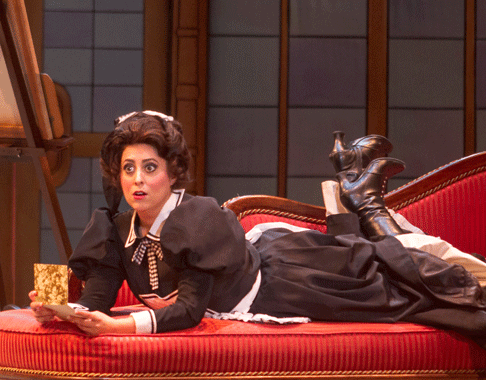
Stephanie Sanchez negotiated the pants role of Prince Orlofsky with an easy panache. Ms. Sanchez possesses a ripe, throbbing, womanly mezzo, so it is no small feat that she was able to bend it into service to suggest a bored young male character. Her/his party piece, Chacun a son gout was craftily vocalized, but it was when she could really let her voice roll out that we were treated to a major talent.
Jess Merlin’s Frosch was deprived of the lengthy schtick that usually makes Act III ten minutes too long, but Mr. Merlin’s wry, irascible performance made every moment count. Brevity seemed liberating and he scored on every beat.
While Charlie Smith’s clever set design never quite distracted from the fact that his was a unit set that was effectively redressed for three locales, it was a handsome structure, with massive walls of grid work and filigree that ably suggested the period. The show curtain with news clips about the characters made for amusing reading during the overture.
The thing that really enhanced Mr. Smith’s efforts was the sumptuous lighting design from Pamila Z. Gray. Ms. Gray used some well-considered isolated spots to really point up the action, and her use of gobos and area lighting were most effective. Cathleen Edwards has devised a rich and telling costume design, one that greatly helps to establish the societal stations of the participants. Christina Martin’s make-up and wig design were to be wholly commended, although I wondered why Rosalinde was blonde in Acts I and III, and redheaded (a better look) in Act II.
Director Marc Jacobs has concocted a fairly straight-forward staging with the complicated plotting always completely understandable, but often punctuated with whimsical flights of fancy that enlivened the experience. The audience was engaged and enchanted the whole night. Choreographer Robyn Tribuzi contrived effective dance moves for a handful of dancers who intermingled Christopher James Ray’s excellently tutored chorus, all of whom moved with commitment and precision.
Die Fledermaus has set the bar very high indeed for Opera San Jose’s 2019–2020 season, and I eagerly look forward to all that is in store.
James Sohre
Johann Strauss II: Die Fledermaus
Gabriel Von Eisenstein: Eugene Brancoveanu; Rosalinde: Maria Natale; Adele: Elena Galván; Ida: Ellen Leslie; Alfred: Alexander Boyer; Dr. Falke: Brian James Myer; Dr. Blind: Mason Gates; Frank: Nathan Stark; Prince Orlofsky: Stephanie Sanchez; Frosch: Jesse Merlin; Conductor: Michael Morgan; Director: Marc Jacobs; Choreographer: Robyn Tribuzi; Set Design: Charlie Smith; Costume Design: Cathleen Edwards; Lighting Design: Pamila Z. Gray; Make-up and Wig Design: Christina Martin; Chorus Master: Christopher James Ray
image=http://www.operatoday.com/1979_2052s.png image_description=Photo by Robert Shomler courtesy of Opera San Jose product=yes product_title=San Jose Pops the Cork With Fledermaus product_by=A review by James Sohre product_id=Photos by Robert Shomler courtesy of Opera San JoseTempestuous Francesca da Rimini opens Concertgebouw Saturday matinee series
The elegantly precise Stanislav Kochanovsky returned to the NTR ZaterdagMatinee to lead the Netherlands Radio Philharmonic in thrillingly tumultuous performances of Tchaikovsky’s symphonic fantasy, Francesca da Rimini and the eponymous one-act opera by Sergei Rachmaninov. Poor Francesca da Polenta – she was led to believe she was about to set up house in Rimini with handsome Paolo, when, in fact, he’d been sent to woo her for his less physically favored older brother. When her husband caught them embracing, he killed them both. In Dante’s Divine Comedy, Paolo and Francesca are doomed, with other adulterous couples, to be buffeted in the afterlife by an eternal whirlwind, a metaphor for the earthly passions that had swept them away. But, although he puts them in hell, Dante assigns them the mildest level of torture, while he smites their killer, Malatesta, deep into the icy ninth circle, with others who have murdered their relatives. The poet is so touched by Francesca’s fate that, when she tells him her story, he collapses, overcome by emotion.
In their similarly structured retellings, Tchaikovsky and Rachmaninov are both emotionally instructed by Dante. They both frame the episode in which the lovers’ submit to their forbidden passion by scenes of the pitiless infernal winds. Tchaikovsky’s spiral up swift and high, Rachmaninov’s are more heavily orchestrated and move ominously like a dark, dense mass. His chorus of the wailing damned gives his hell a human shape, however faceless. On Saturday, the Netherlands Radio Choir raised their voices in horrifying and beautiful desperation. But even in Tchaikovsky’s voiceless perdition, Kochanovsky managed to suggest echoes of human cries by filing a sharp edge onto the winds and strings. This piercing orchestral quality contrasted with the restrained lyricism of the love scene, which culminates, as in Wagner’s Tristan und Isolde, in the brutal interruption of an ecstatic embrace. As in his earlier appearances conducting Russian operas in Amsterdam, Kochanovsky proved a masterful storyteller, knowing when to go in for grand gestures, as in the violent tornados of both finales, as well as how to let a passage such a Tchaikovsky’s refined romance release its perfume gradually.
Rachmaninov’s opera, which sets a libretto by Tchaikovsky’s brother Modest, is broodier and less graphically descriptive than Tchaikovsky’s fantasy. It has the feel of a symphonic poem, with the orchestra always having at least as much to say as the voices. Besides finding the Radio Philharmonic close to their best, this concert version upheld the ZaterdagMatinee’s reputation for engaging choice vocalists. Alongside the chilling chorus, tenor Dmitry Golovnin as Dante and bass Mikhail Kolelishvili as his guide, the Ghost of Virgil, perched high behind the orchestra, ensured that the singing in hell was of the highest order. A last-minute substitute for soprano Venera Gimadieva, Maria Bayankina was a dignified, slightly elusive Francesca. She has an attractive middle voice and the slight flutter in her metallic top lent the necessary tension to the love duet.
Bayankina and the honey-voiced tenor Oleg Dolgov in the role of Paolo handled the demands of their unsparing, high-lying music very well, holding their own over the rich orchestral carpet. Still, there was something missing in terms of passion and the real erotic fire was stoked in the orchestra. Here again Kochanovsky displayed how expertly he uses space and dynamics to bring details to the fore. The vocal performance that equaled his expressive powers had come just before the lovers’ tryst, in Lanciotto Malatesta’s jealousy monologue. Vladislav Sulimsky turned his scene into a mini-opera, eliciting with his formidable baritone fear and revulsion, but also pity and understanding. Malatesta’s obsessing on unrequited desire and hate-filled plotting may not be as well known as other jealousy arias, such as “Eri tu” from Verdi’s Un ballo in maschera. But an interpretation such as Sulimsky’s, especially when accompanied so sensitively and vividly in the orchestra, almost made the case that it should be.
Jenny Camilleri
Tchaikovsky: Francesca da Rimini, Op.32
Rachmaninov: Francesca da Rimini, Op.25
Mikhail Kolelishvili, Ghost of Virgil; Dmitry Golovnin, Dante Alighieri; Vladislav Sulimsky, Lanciotto Malatesta; Maria Bayankina, Francesca Malatesta; Oleg Dolgov, Paolo Malatesta. Stanislav Kochanovsky, Conductor. Netherlands Radio Choir (Groot Omroepkoor). Netherlands Radio Philharmonic. Heard at the Concertgebouw, Amsterdam, on Saturday, the 14th of September, 2019.
image=http://www.operatoday.com/Inf._06_Alexandre_Cabanel%2C_Morte_di_Francesca_da_Rimini_e_di_Paolo_Malatesta%2C_1870.png image_description=The death of Francesca da Rimini and Paolo Malatesta by Alexandre Cabanel (1870) [Source: Wikipedia] product=yes product_title=Tempestuous Francesca da Rimini opens Concertgebouw Saturday matinee series product_by=A review by Jenny Camilleri product_id=Above: The death of Francesca da Rimini and Paolo Malatesta by Alexandre Cabanel (1870) [Source: Wikipedia]Erich Wolfgang Korngold: Die Tote Stadt
First Performance: 4 December 1920 at Hamburg and Köln.
| Principal Characters: | |
| Paul | Tenor |
| Ghost of Marie, his deceased wife | Soprano |
| Marietta, a dancer | Soprano |
| Frank, Paul's friend | Baritone |
| Brigitte, Paul's housekeeper | Mezzo-Soprano |
| Fritz an actor | Baritone |
| Juliette, a dancer | Soprano |
| Lucienne, a dancer | Soprano |
| Gaston, a dancer | Tenor |
| Victorin, the director | Tenor |
| Count Albert | Tenor |
Synopsis:
Act I
Since his wife's death, Paul has saved a braid of her hair, her scarf and her lute as mementos. She lives only in his memory. Paul's housekeeper, Brigitta, declares that his friend, Frank, has returned to Brügge after a long absence. He tells Paul that has met a young woman who closely resembles the dead Marie. Frank warns him to let the dead rest in peace, but Paul dreams of her return. He has Brigitta procure red roses.
The young lady, Marietta, arrives. She is a dancer on tour. Paul gives her the roses and then gives her Marie’s scarf and lute. Marietta sings a song that Marie always sang. Marietta uncovers Marie’s portrait and notes the striking similarity with her. She must leave to attend a rehearsal of Meyerbeer’s Robert le Diable, in which she plays Hélène. She urges him to join her at the theater; but, he stays behind. The apparition of Marie appears from the portrait and transforms into the dancing figure of Marietta.
Act II
Paul and Frank meet outside Marietta’s house. Brigitta has left Paul’s service. Frank has the key to Marietta’s apartment. Paul wrestles the key from him. Marietta’s troupe arrives. They begin to rehearse the resurrection scene from Robert le Diable, with Marietta as the risen Hélène. Paul interrupts, humiliating Marietta. Nevertheless, Marietta wishes to win over Paul. She goes with him to his house. There she will battle with the ghost of Marie.
Act III
The next morning, Marietta stands before Marie’s portrait, triumphant. She challenges the dead woman. Paul’s conscience is in turmoil, which only increases as a holy procession passes by the window. Marietta mocks Paul because of his piety. She takes the braid of hair. Paul snatches it away from her and strangles Marietta with Marie's hair. Now dead, Marietta resembles Marie completely.
Paul awakens. Brigitta reports that Marietta has forgotten her roses and umbrella. After Marietta leaves, Frank invites Paul to accompany him on a trip to get away from the city of the death. Paul, who determines that a reunion with the dead is not possible in this life, follows him.
Click here for the complete libretto
image=http://www.operatoday.com/Rozenhoedkaai_Brugge.png image_description=The Rozenhoedkaai [nl] (canal) in Bruges with the belfry in the background [Source: Wikipedia] audio=yes first_audio_name=Erich Wolfgang Korngold (1897-1957): Die Tote Stadt first_audio_link=http://www.operatoday.com/Die_Tote_Stadt.m3u product=yes product_title=Erich Wolfgang Korngold (1897-1957): Die Tote Stadt product_by=Maud Cunitz (Marie/Marietta), Karl Friedrich (Paul), Benno Kusche (Frank), Lilian Benningsen (Brigitta), Hans Braun (Fritz), Margot Guilleaume (Juliette), Eleonor Junker (Lucienne), Richard Holm (Victorin/Gaston), Josef Traxel (Count Albert), Chor und Orchester des Bayerischen Rundfunks, Fritz Lehmann (cond.)Live performance, 1952, München
Immortal Beloved: Beethoven Festival at Wigmore Hall
In his eighteenth sonnet, Shakespeare celebrates the power of his poetry which, through its own immortality, ensures the posthumous survival of its muse. This concert at Wigmore Hall - the culmination of the Hall’s weekend Beethoven Festival - explored the figure of the ‘immortal beloved’ as it lives on in the work of Beethoven, Mahler, Janáček and Berg.
Immortalising the beloved is indeed one of art’s supreme powers, though it is often the artist’s own emotions that are foregrounded, the loved one - distant or departed - remaining ineffable, tinged with an air of unreality. And, just as Shakespeare’s ‘Fair Youth’ and ‘Dark Lady’ have remained elusive to scholars, so the identity of Beethoven’s ‘Unsterbliche Geliebte’ continues to generate historiographical debate and dispute. Antonie Brentano, Josephine Brunsvik, Almeria Esterhazy, Bettina Brentano: which was the woman to whom Beethoven expressed his apparently unrequited devotion? Or, was that mysterious beloved someone else altogether?
Just as unanswerable is the question, ‘Did the circumstances of Beethoven’s life affect his music, and if so, in what ways?’ Yet, it is this relationship between biography and music that we are invited to consider when we listen to the composer’s 1816 An die ferne Geliebte (To My Distant Love) which sets six poems by Alois Jeitteles, weaving them into a continuous musical narrative - the first ‘song-cycle’ of this kind. And, it was this relationship between art and life which broadcaster and Beethoven biographer John Suchet emphasised in his engaging introduction to the evening’s performances.
Baritone Benjamin Appl immersed himself in Jeitteles’ poems, which present suffering and yearning through natural imagery - the mountains and valleys that separate the poet-speaker from his loved one; the winds, clouds and brooks he envies as they wend their way towards the object of his desire; the nest-making swallows whose peaceful togetherness he covets. As well as effectively drawing out Beethoven’s gentle word-painting, Appl and pianist Kristian Bezuidenhout effectively built the continuous thirteen minutes of music towards the Romantic heights of the final song.
There was nothing melodramatic about Appl’s performance, though; he communicated directly, without undue mannerism, his sweet, walnut baritone infused with a lovely smooth grain. This was an unwaveringly elegant performance, and occasionally I wished for a little more rhythmic ‘drama’. For example, a slight rubato in the penultimate verse of the first song was finely judged, emphasising the poet-speaker’s distress (“Singen will ich, Lieder singen,/ Die dir klagen meine Pein!”), but the subsequent accelerando that Beethoven indicates was rather mild: surely Beethoven, in urgently pushing the music towards Allegro not only evokes but embodies a brief blooming of rapture, as the protagonist sings of song’s own transfiguring powers which “put to flight all space and all time”?
Appl crafted a lovely floating line at the start of ‘Wo die Berge so blau’ (Where the blue mountains), though occasionally the intonation did not feel entirely settled, and the duo negotiated the song’s temporal twists and turns fluently, finding passionate warmth in the closing crescendo . Bezuidenhout’s linking episodes shaped the unfolding moods convincingly. The circling arpeggios at the start of ‘Leichte Segler in den Höhen’, for example, captured the movement of the clouds sailing high above, their lightness suggested too by Appl’s graceful staccatos. ‘Diese Wolken in den Höhen’ (These clouds on high) was bright and buoyant, with deft piano ornaments and a vocal line with a firm rhythmic spring in its step.
Towards the close of ‘Es kehret der Maien’ (May returns), the poet-speaker’s optimism wanes, however, and Appl made effective use of a gentle head voice with the return of the text of the opening, pensively slowing into the final song, ‘Nimm sie hin den, diese Lieder’ (Accept, then, these songs’). Music’s power to transcend time and space is not, after all, eternal. Appl shaped the resigned ending beautifully, diminishing - like the red rays of the evening light which fade behind the mountains - to a wistful pianissimo, and leaving the protagonist’s yearning hanging in the air: “Nur der Sehnsucht sich bewüsst” (… aware only of longing).
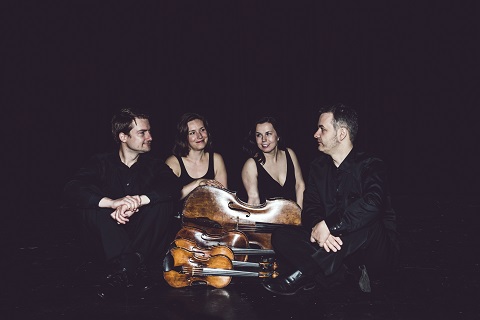 © Škampa Quartet.
© Škampa Quartet.
If the object of Beethoven’s affection remains elusive, then there is no doubting the inspiration of the passion expressed in Janáček’s Second String Quartet, which was given an astonishingly intense, even visceral, presentation by the Škampa Quartet. This was playing of striking vivacity and immediacy: an ‘operatic’ performance which made the elderly composer’s soul-consuming love for Kamila Stösslová powerfully tangible. The cello’s opening trill virtually throbbed and was complemented by the upper strings’ rich, warm tone, establishing the ardency that impelled the music ever onwards. I was struck by the way each voice in the texture had a clearly defined character and strong individual presence, but without any sense of ‘competition’ between the four voices which blended expertly in articulating the Romantic drama.
I don’t think I’ve ever heard the viola theme at the start of the second movement sing so tenderly as it did in Martin Stupka’s rendition or the high first violin line here and in the following movement sail with such a powerful combination of strength and sweetness as did Helena Jiříkovská’s. While the tutti sound was gloriously full it was never overly forceful and there was a lovely transparency to the textures allowing us to appreciate each singing voice. The pulse of the final movement was compelling - a heart beating with strong surges of love - and the Škampa did not push the tempo of this movement too much, allowing space for the contrasts to register and for the trills and decorations to be carefully defined. At the end, there was an overwhelming feeling of hope - an optimism that was absolutely uplifting. A truly wonderful performance.
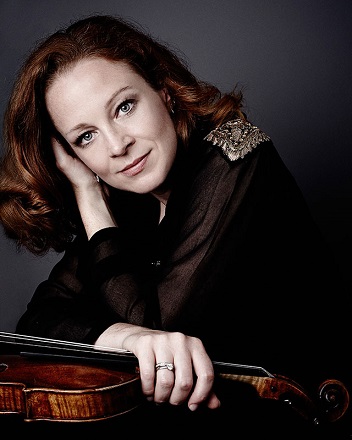 Carolin Widmann.
Carolin Widmann.
Carolin Widmann’s performance of Berg’s Violin Concerto, which is dedicated to the memory of Manon Gropius, the daughter of Alma Mahler Werfel and Werther Gropius, was no less absorbing. Widmann’s immensely powerful and focused sound conveyed every ounce of the work’s Romantic lyricism, all the while articulating the structure with assured insight and clarity. Standing at the centre of the O/Modernt Chamber Orchestra, directly facing the audience, Widmann communicated with astonishing poise and probing musicality. Immersed in the musical explorations, at the close of the cadenza she turned almost fiercely towards ensemble leader/director Hugo Ticciati, as if to dare him to join her unfolding arguments. There was gentleness too, though, most especially in the closing Adagio which faded mesmerisingly into silent stillness, preparing us for the final item of the programme, the Adagietto from Mahler’s Fifth Symphony which, led by violinist Priya Mitchell, brought peace and closure to the evening’s Romantic yearnings.
Claire Seymour
Beethoven Festival: Beethoven - An die ferne Geliebte Op.98, Janáček - String Quartet No.2, ‘Intimate Letters’, Berg -Violin Concerto, Mahler - Symphony No.5, Adagietto
Benjamin Appl (baritone), Kristian Bezuidenhout (piano), Škampa Quartet, Carolin Widmann (violin), O/Modernt Chamber Orchestra (director/violin, Hugo Ticciati).
Wigmore Hall, London; Saturday 14th September 2019.
Image=http://www.operatoday.com/Benjamin%20Appl.jpg image_description= product=yes product_title=Wigmore Hall: Beethoven Festival - Immortal Beloved product_by=A review by Claire Seymour product_id=Above: Benjamin ApplSeptember 15, 2019
Stars of Lyric Opera at Millennium Park 2019
Soloists performing in this concert were Marianne Crebassa, Lawrence Brownlee, Adam Plachetka, Krzysztof Bączyk, and members of the Patrick G. and Shirley W, Ryan Opera Center. The Lyric Opera Orchestra was led by the company’s music director, Sir Andrew Davis, and the Lyric Opera Chorus was prepared by Michael Black.
Both halves of the concert were introduced by an orchestral selection. The overture to Giuseppe Verdi’s Luisa Miller, scheduled to begin performance in October, opened the evening’s program. Davis elicited lush, lyrical motifs from the string section while punctuating these with dramatic lines emphasizing the opera’s fundamental tensions between love, family, and political intrigue.
 Adam Plachetka [Photo courtesy of Askonas Holt]
Adam Plachetka [Photo courtesy of Askonas Holt]
In the first vocal selection Mr. Plachetka gave a spirited performance of Ford’s monologue from Verdi’s Falstaff. Since Plachetka is arguably equally skilled as an actor as singer, this role and scene fits his voice ideally. He concluded the aria with dramatic extended pitches.
 Lawrence Brownlee [Photo by Shervin Lainez courtesy of IMG Artists]
Lawrence Brownlee [Photo by Shervin Lainez courtesy of IMG Artists]
The audience was subsequently treated to the bel canto artistry of Lawrence Brownlee in Fernand’s aria, “Ange si pur,” from Gaetano Donizetti;s La favorite. Brownlee’s matchless sense of communicating the spirit of the piece while respecting the beauty of the musical line was manifest in this performance. His choice of piano emphasis, gleaming top notes of perfect pitch, and innate sense of legato throughout rendered this selection a memorable highlight of the evening.
As a fitting prelude to the new season’s production of Giacomo Puccini’s Madama Butterfly Matilda Edge sang “Un bel dì.” Ms. Edge showed an excellent use of shading on top notes, while the final bars of the aria floated into the aether. Experience and innocence were captured nicely by Kayleigh Decker and Christopher Kenney in their rendition of “Lã ci darem la mano” from Mozart’s Don Giovanni. In a subsequent excerpt Mr. Kenney performed Prince Ylizky’s aria from Tchaikovsky’s The Queen of Spades. As one of the memorable solo, lyrical passages from that opera, it is essential for the baritone to give a sense of focused, emotional longing. Kenney’s rounded, full tone succeeded with a touch of melancholy in the mix.
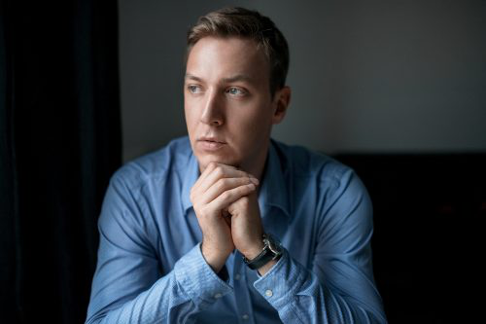 Krzysztof Bączyk [Photo by Ksenia-S Photography courtesy of GM Art & Music]
Krzysztof Bączyk [Photo by Ksenia-S Photography courtesy of GM Art & Music]
The first part of the concert featured two additional soloists in noteworthy performance. Mr. Bączyk sang an aria from Sergei Rachmaninoff’s Aleko. Bączyk’s commanding vocal and stage presence suggested a blend of emotions, enhanced even more by shades of coloring in repeated phrases and words. The message of musical urgency resulted dramatically even for those not conversant in the Russian language.
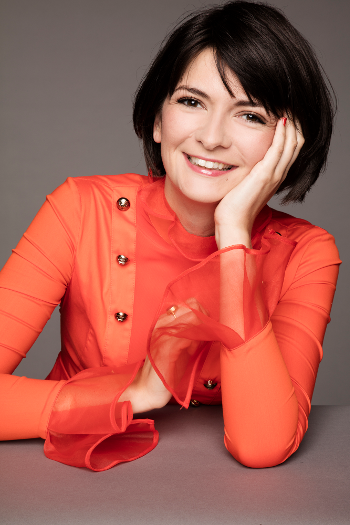 Marianne Crebassa [Photo by Simon Fowler courtesy of IMG Artists]
Marianne Crebassa [Photo by Simon Fowler courtesy of IMG Artists]
Ms. Crebassa concluded this portion of the concert by singing the “Habanera” from Bizet’s Carmen in a scene also featuring the Lyric Opera Chorus. Crebassa sounded at once seductive and subtle, her breath control allowed for extended note and rapid shifts in tempo, while occasional passages taken with rubato gave appropriate emphasis.
The second half of the evening included four iconic arias from Il barbiere di Siviglia and the finale to the first act of the opera. Brownlee sang the serenade “Ecco ridente” with sufficient yearning so that his urgent desire to see Rosina was surely perceived. Brownlee’s rapid passagework, his performance of runs and decorative trills, and his beautifully phrased top notes were flawless. The emotional fervor of the scene was captured in the beauty of the singing. In much the same way, Crebassa’s performance of “Una voce poco fa” demonstrated those rare qualities of a Rossinian mezzo-soprano. Her evenness of projection and range with effortless, full low notes and flexibility of line throughout made this clever Rosina appear even more likely to outwit her superiors. Mr. Plachetka sang “Largo al factotum” with gusto and comic intensity, while Bączyk delivered a thundering performance of “La calumnia,” in which speed and volume were varied so that individual pitches communicated as much as phrases taken as a whole. The finale was spirited and bright, acting as a invitation to hear and see more of this glorious performance on stage. Since the artists here performing will be the principals in the opening of the 2019–2020 season at Lyric Opera of Chicago, there should be much to enjoy in the months to come.
Salvatore Calomino
image=http://www.operatoday.com/Crowd%20Shot_c.%20Todd%20Rosenberg.png image_description=View of audience at Millennium Park [Photo by Todd Rosenberg courtesy of Lyric Opera of Chicago] product=yes product_title=Stars of Lyric Opera at Millennium Park 2019 product_by=A review by Salvatore Calomino product_id=Above: View of audience at Millennium Park [Photo by Todd Rosenberg courtesy of Lyric Opera of Chicago]Prom 74: Uplifting Beethoven from Andrew Manze and the NDR Radiophilharmonie Hannover
A season which has celebrated Henry Wood’s innovations, traditions and achievements closed with a week commemorating his practice of programming single-composer Proms, and after evenings devoted to Wagner and J.S. Bach, now it was Beethoven’s turn. Generally, in Wood’s day, a ‘named composer’ Prom confined the majority of the honoured musician’s music to the first half of the programme, but here Beethoven interweaved with Handel and Bach.
The concert aria ‘Ah! perfido’ for soprano and orchestra was composed when Beethoven was in Prague, on a piano concert tour, in 1796. The first performance was given by renowned soprano Josepha Duschek the following year, but it was not until December 1808 that it was heard in Vienna for the first time - in a marathon concert that included Beethoven’s Fifth and Sixth symphonies, Fourth Piano Concerto, three movements from the C major Mass, and the Choral Fantasy. Even Wood’s lengthy programmes tended to comprise a long medley of works of a much ‘lighter’ nature!
The Viennese concert didn’t go entirely to plan: the Choral Fantasy unravelled, the heating system in the hall failed, and just as punters were about to expire from the chill Beethoven launched into an extended improvised encore at the piano.
Elizabeth Watts [Photo by Marco Borggreve courtesy of Maxine Robertson Management]On this occasion, there was no question of any chaos or collapse. Soprano Elizabeth Watts gave a performance of absolute command and control, her tone unwaveringly focused, full and even. She had the measure of both the musical and dramatic demands of this quasi-operatic scena, the text of which is taken from Metastasio’s Achille in Sciro and deals with betrayal, injustice and despair. Watts communicated every twist and turn of emotion, her words of indignation soaring with authority and strength, her outpourings of heartbreak crafted into a line of beauty, the more florid outbursts attacked with passion. ‘Ah! perfido’ is a demanding showpiece and Watts emphasised its impassioned Romantic qualities, occasionally at the expense of the more delicate, Classical moments. But, her performance was an impressively poised tour de force.
Such might and majesty was perhaps less apt for Leonora’s ‘Komm, Hoffnung, laß den letzten Stern der Müden nicht erbleichen’) from Act 1 of Fidelio, in which Leonora expresses her anger at the evil Pizarro whose plans to murder her husband she has just overheard. But, if the peace within Leonora’s soul was not always evident in Watts’ powerful rendition, then there was no doubting Leonora’s dignity and the sincerity and strength of devotion, and the ardency of her pleas was moving. Leonora’s outraged opening recitative was a flurry of fierce, even bitter, questions, and we could almost feel the heat of the anger and fury that rage in Pizarro’s soul (“dir in der Seele Zorn und Wut”). And, if Watts’ soprano didn’t quite have the transparent gentleness to capture the serenity which supersedes such ferocity, then the focus of Watts’ low-lying line as the vision of the rainbow becalms Leonora’s blood re-established her self-composure, just as the silky aria that followed confirmed the goodness in her heart. Watts’ attention to the words and the shaping of the phrases through carefully placed breaths emphasised the nobility of the melodic line, which gradually became more urgent culminating in an intense declaration of determination to free Florestan.
Andrew Manze. Photo credit: BBC/Chris Christodoulou.Leonora’s aria had been preceded by the 1814 version of the Overture to Fidelio in which Manze skilfully ratcheted up the tension in the opening sections before flicking a ‘relax’ button at the start of the Allegro and allowing freedom to sail forth in the form of a warm horn solo. This was a bright and breezy rendition, perhaps neglecting the darker tints, but one which emphasised ebullience and joy. “Hoorah!” cried one Prommer, as the final chord rang in the air.
Manze’s reading of Beethoven’s Fifth Symphony was similarly vigorous and optimistic. Flinging his loose limbs far and wide, opening his arms to their full, wide span to welcome and embrace the tutti fortissimos, punching his baton at the air, suddenly shrinking inwards to draw his players together in tight piano interplay, Manze - unorthodox, imposing, invigorating - was a captivating sight on the podium: my young guest found his impassioned, sometimes wild, gestures absolutely transfixing, and I was minded of Otto Böhler’s silhouettes of Mahler!
But, there is no doubting the efficacy of his extravagant and idiosyncratic style. This Fifth Symphony was probably not one for the purists, nor is it the one I would necessarily choose for my desert island collection, but it was terrifically exciting. Manze signalled his intention to do things his own way right from the start, practically ignoring the fermatas in the second bar and at the close of the first full phrase, denying the doubts and charging forwards in hope-fuelled determination. In this vein, the Andante con moto was a carefree, lazy stroll, the violas and cellos introducing the theme with complete ease - not a figurative furrowed brow in sight. Again, one might have wished for a little more sombreness - the harmonic shadows were readily, even defiantly, pushed aside - but Manze’s approach inspired a consoling sanguinity which was troubled only by the bronchial Prommers who seemed to have more than their fair share of autumnal agues.
Similarly, the entry of the horns’ confident theme after the strings’ initial tentative climbs at the start of the Scherzo swept away any clouds of uncertainty - I’d have challenged any listener not to smile each time the theme reappeared with a cheeky sway in its step. After a bracing fugue, the movement segued seamlessly and with a gleaming roar into the final movement which raced home, fuelled by affection, spiritedness and sunny assurance.
Beethoven had not got proceedings underway, though; that fell to Handel, whose Music for the Royal Fireworks opened the Prom in grandiose style, Manze conceiving of the movements in extended, far-reaching sweeps. We also heard Bach’s Fantasia and Fugue in C minor BWV 537 as arranged by Elgar, with Manze emphasising the lyricism of the Fantasia, though not always clearly defining the relationship between the voices - something that he did much more successfully in the Fugue, articulating the colossal architecture of Elgar’s transcription.
We came full circle with the encore: the Lentement and Bourée from Suite No.2 in D major from Handel’s Water Music, as arranged by Hamilton Harty. Like their fellow musicians from Bremen last week, the players showed the joy that their shared music-making had brought them as they left the platform, embracing and shaking hands. Such heart-warming, uplifting gestures are beginning to look decidedly European.
Claire Seymour
Elizabeth Watts (soprano), Andrew Manze (conductor), NDR Radiophilharmonie Hannover
Prom 74: Handel - Music for the Royal Fireworks; Beethoven - Aria, ‘Ah! perfido’; J.S. Bach - Fantasia and Fugue in C minor BWV 537 Op.86 (orch. Edward Elgar); Beethoven - Fidelio, Overture and ‘Abscheulicher! … Komm, Hoffnung, lass den letzten Stern’, Symphony No.5 in C minor.
Royal Albert Hall, London; Friday 13th September 2019.
image=http://www.operatoday.com/Elizabeth%20Watts%20Prom%2074.jpg image_description= product=yes product_title=Prom 74: Beethoven Night - the Radiophilharmonie Hannover conducted by Andrew Manze product_by=A review by Claire Seymour product_id=Above: Elizabeth Watts (soprano)Photo credit: BBC/Chris Christodoulou
September 12, 2019
In conversation with Nina Brazier
Nina joined Frankfurt Opera in 2018 as a staff director and she describes some of the challenges of leading the company’s revivals, not least the very short amount of time - just a couple of weeks - that she has to prepare a new cast and chorus. In the case of Julietta , one or two of the soloists and many of the chorus are familiar with Klepper’s production, which sets Martinů’s strange, surreal opera (in which the inhabitants of a town have no memories) in what Nina describes as a “theatrical dream world” which plays with the aesthetics of impersonal spaces such as offices, nursing homes and cafeterias where otherwise inconspicuous waiting-room plants grow and develop into a forest of dreams. It’s beautifully directed, she says, and the challenge is to find a balance between honouring Martinů’s opera and doing justice to the work itself, and respecting the original director’s conception.
I ask Nina how she goes about preparing a revival? She explains that when she arrived in Frankfurt eighteen months ago, all the productions were ‘new’ to her. There is usually a video recording of the premiere, so she will watch one or two DVD versions and also study the original staff director’s book, which will indicate the blocking. Comparing the two will sometimes reveal when a mistake has been made and Nina will aim, as far as possible, to be loyal to the original, though she’s concerned, too, to allow the singer some ‘freedom’: “All singers are different, in terms of their instinct and emotional response to a character, and I try to respect that, as the original director would have done.” So, while the choreography needs to be observed, so that characters are in the right place at the right time, a singer must have some freedom to be and feel that character. On a few occasions Nina has had to call the original assistant director, if a detail isn’t clear - especially is the lighting design involved a lot of darkness and shadow, making it difficult to see on the DVD exactly what was happening!
There’s a real satisfaction in getting the production ready for its revival run, but with rehearsal time so restricted Nina confesses to finding it frustrating when it’s not possible to observe every detail of the original. She must have found it satisfying to have the opportunity to mount her first fully independent opera production in Germany recently - Le nozze di Figaro at Delphi Theater Berlin, which inaugurated Opernfest, the International Festival of Young Opera Singers hosted by the Berlin Opera Academy, and which was described by one critic as ‘characterized by an economy of gesture married to an unbridled sense of whimsical fun’.
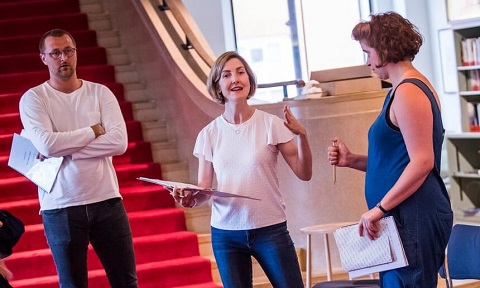 Nina Brazier in rehearsal. Photo credit: Tristram Kenton.
Nina Brazier in rehearsal. Photo credit: Tristram Kenton.
The autumn will be busy, as Nina will be travelling between Germany, Austria and the UK: in September, for the reprise at Kings Place of Dear Marie Stopes - an opera by Alex Mills first performed at the Wellcome Collection museum as part of the Tête à Tête opera festival in 2018, commemorating the centenary of the publication of Stopes’ Married Love - and the following month when the ongoing world tour of East West Street - a partly staged reading inspired by international human rights lawyer Philippe Sands’ award-winning bestseller about the Nuremberg trials - arrives at the Southbank Centre and later tours to MuTh in Vienna in November.
How did Nina come to be involved in these unusual creative projects? She explains that Mills had seen and enjoyed her one-hour ‘re-imagining’ of A Winter’s Tale with The Hermes Experiment, involving four musicians and five actors, at the Tête à Tête Opera Festival in 2017, and subsequently approached her to direct Dear Marie Stopes. With issues relating to birth control and female sexual health still very much current today, and as the proposal fitted her schedule, Nina accepted. Mills’ chamber opera sets emotionally charged letters, now stored in the Wellcome Collection’s archives, from readers asking Stopes for advice and sharing their individual stories. Nina comments that many could have been written today and that they are often utterly heart-breaking. The opera opens with a harrowing letter from a woman who has had fourteen children, nine of whom were still living, asking for help as a doctor had told her that she will die if she has another child.
As for East West Street, Nina comments that it’s surprising that her path ever collided with that of Philippe Sands, prize-winning author of book exploring the lives of three men involved in the Nuremberg Trials who, while on opposite sides of the ‘good-evil’ divide, find solace in the same piece of music: Bach’s St Matthew Passion. Hans Frank, who had been Hitler’s personal lawyer, was known as the ‘Butcher of Poland’ and was accused and convicted for his role in the murder of three million Jews and Poles. Raphael Lemkin was an advisor to the American prosecutors who championed the concept of genocide, a term he invented. Hersch Lauterpacht was a member of the British prosecution team who argues for the concept of ‘crimes against humanity’. As Nina describes the action in a programme article for a performance at the 92nd St Y in New York: ‘The two men contemplated different moments in their lives: Frank awaited judgement for his terrible role in the atrocities in Poland and a possible sentence of death; Lauterpacht had just learned of the murder of his entire family - by the man he was prosecuting. Music, it seems, does not discriminate.’
Sands originally presented his research as a lecture at Oxford Unversity, and then expanded this by integrating a violist in a second reading at Inner Temple. But, as the project grew he realised that it needed more music. One of his childhood friends was the French bass-baritone Laurent Naouri; Sands ‘pestered’ a reluctant Naouri to look at the text, and when the singer finally agreed to take a look he recognised a musical thread woven through the story and selected an eclectic range of pieces, from Ravel to Beethoven, Rachmaninov to Leonard Cohen. Naouri involved a friend from Paris, the renowned jazz pianist Guillaume de Chassy: East West Street was growing - and it was a work in need of a director.
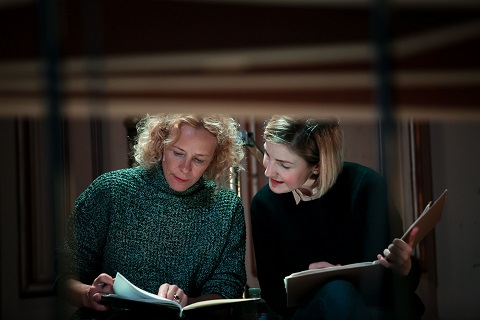 Katja Riemann and Nina Brazier, East West Street (offstage).
Katja Riemann and Nina Brazier, East West Street (offstage).
Sands didn’t have many musical contacts, but one such was Paul Cremo, dramaturg at the Metropolitan Opera New York. Asked if he knew of any directors in the UK who might be interested, Cremo contacted English National Opera where Nina was working as a freelance staff director. As Nina puts it, she’d been badgering producing director Terri-Jayne Griffin to see some of her work, and so when the call from Cremo arrived Terri-Jayne recommended that Sands get in touch with Nina. Surprised to find herself receiving a telephone call from the Metropolitan Opera, Nina subsequently travelled to the Hay Festival in 2014, where the work was performed, with Sands as narrator, piano and bass-baritone contributions, some images, but no movement. It was fascinating but not very theatrical, she remembers; but the next day, the group sat in the garden at Hay and brainstormed development ideas, with contributions too from Naouri’s wife, Natalie Dessay.
One major decision was to introduce a second narrator: 90 minutes is a long time, even with musical interjections, for the audience to listen to a single voice, Nina suggests. Vanessa Redgrave agreed to perform the role of female narrator for the performance in the Purcell Room, and while there was not much time to rehearse, and Nina would not describe the work at this point as ‘staged’, the resulting performance had greater “theatrical shape”. Sands began to receive invitations to present East West Street overseas, often in academic or judicial contexts, and the ensemble travelled to Stockholm and, in the 70th anniversary year of the Nuremburg Trials, to the original court room itself. This was obviously an incredibly emotional performance: as Nina explains, there were elderly people present who had themselves been at the Trials. Awarded an Evening Standard Theatre Award, Vanessa Redgrave was unable to participate in the Nuremberg performances; her ‘replacement’ was German film doyenne Katja Riemann - when Nina asked her German uncle if he knew of Riemann, he replied, “She’s a genre of her own!”
Sands’ book had now been published, and the ensemble accompanied him on what was essentially a ‘world book tour’. The emotional resonances of the performance accumulated: Emmanuel Ax joined them as guest pianist, performing East West Street for the first time in November 2017 in Lviv in western Ukraine, the city of his birth, which he had left as a child in 1956 and not since revisited. His encore, not surprisingly, wrought tears from many as the city’s, the people’s and the pianist’s shared history came together. The impact of East West Street was absolutely unanticipated, says Nina. Sitting on the lawn in Hay in 2013, no one knew what it would become.
Given that her initial training was in the field of drama (Drama at Exeter University, followed by a Masters in Text and Performance at RADA), I wonder how Nina came to be involved in opera? She explains, with characteristic modesty, that finding herself in London, a recent graduate hoping to make a career in the theatre and dreadful at networking, she wrote what she describes as “terribly bad letters” seeking opportunities to gain experience. The result of one such letter was an invitation from Ian Riches, then Artistic Director at the Royal Court Theatre, to participate in a two-week directors’ course, working alongside playwrights, directors such as Katie Mitchell, actors and writers, and involving workshops and performances. During the course, hearing that John Wright was looking for a director who could read music to assist him on a new contemporary opera, Arcane, by Paul Clark, another director, Vicky Jones, suggested Nina. “My childhood in Wales had involved lots of singing and playing music, but at that time I hadn’t even been to the opera.”
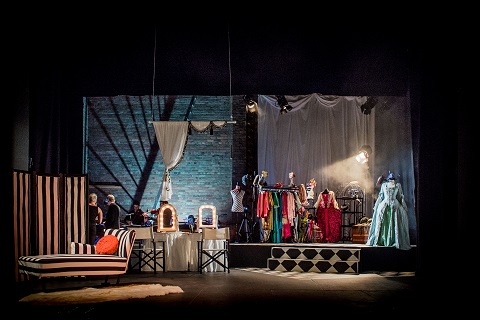 Così fan tutte, Ryedale Festival Opera, 2019.
Così fan tutte, Ryedale Festival Opera, 2019.
This first experience of opera “brought together everything I love about theatre - I was completely overwhelmed with the way it heightened human expression”. Things snowballed from there: Nina assisted Charles Edwards on his Rigoletto for Opera North in 2006, and thereafter has worked as an Assistant/Staff director at Welsh National Opera, the Royal Opera House, English National Opera, Bayerische Staatsoper, then more recently as an Associate Director at Theater Bonn, and directed independent productions at Ryedale Festival Opera, Tête à Tête, Theâtre de la Colline in Paris, 92 nd St Y and the Center for Contemporary Opera in New York, Kings Place, Buxton International Opera Festival and the Royal Festival Hall, among other venues. Her productions have earned stellar praise, withOpera Now admiring her ‘genuine music theatre sensibility’ ( A Telephone Call, Tête à Tête 2015); Opera Magazine calling her a ‘skilful director’ (The Merry Widow, Ryedale Festival Opera 2015) Early Music extolling the ‘impressively light directorial touch’ and the ‘simplicity of the staging and direction [which] meant that the music was allowed to speak for itself, portraying the characters in the way that Handel’s music suggests’ (Alcina, Ryedale Festival Opera and national tour 2016); and Opera Scotland noting her ‘talent as a director ... emphasising clarity of plot outline’ (La finta giardiniera, Ryedale Festival Opera and national tour 2018).
October will see Nina back in Frankfurt, turning her attention to the revival of David Hermann’s 2017 production of Ernst Křenek’s Drei Kurzopern . Her contract with Frankfurt Opera ends next summer, though she can imagine herself staying in Germany longer to “learn the language better”: “there’s a lot of pressure rehearsing a chorus of 60 in a language that is not your own!” - particularly as German houses do not have full stage management teams, unlike the UK where even for a revival production, the director might work with as many as three stage managers and an assistant director. Her work in Frankfurt will, Nina hopes, be a springboard for subsequent directorial work in the UK and worldwide.
In the meantime, Londoners can enjoy Dear Marie Stopes on 21st September at Kings Place and East West Street on 21st October at the Queen Elizabeth Hall.
Claire Seymour
image=http://www.operatoday.com/Nina%20Brazier.jpg image_description= product=yes product_title=An interview with Nina Brazier product_by=By Claire Seymour product_id=Above: Nina BrazierProm 69: Elena Stikhina’s auspicious UK debut in a dazzling Czech Philharmonic concert
For a soprano who has already sung Brünnhilde (in Siegfried) and is about to take on Norma, there were many assumptions to make about the kind of voice Stikhina might have; none were actually founded in fact. Everything about this performance suggested a thorough grounding in the role’s youthfulness, innocence, and romantic instincts. It was almost unbearable to hear Tatyana’s soul being displayed with such depth; it was if every novel, every chapter and paragraph of a book ever written were being narrated by Stikhina with heartrending insight. What was so unusual about this Letter Scene wasn’t just the careful attention to detail (and the impeccable Russian), it was that you felt she was writing the letter as it happened. Less the vast monologue it often is, it was a gripping and believable performance of time and place which was of the moment.
The voice itself is extraordinarily beautiful and rather wide in what it can do. It has the creaminess of Janowitz yet that rather mezzo-like, shadowy appeal of Ludwig; in a sense it’s febrile, like a molten furnace embracing dark embers from the middle of the chest, right up to a rock-solid spiralling high register that is crystalline. The vibrato is controlled with unwavering precision. Her stage presence is such that she lives the role of Tatyana - and I imagine everything else she sings. She completely charmed a capacity audience, just as she managed to persuade Bychkov and the Czech Philharmonic to follow every instinct of a performance that was as sublime as it was utterly incomparable.
The concert had opened with very familiar Czech fare - Smetana. The Overture, and Three Dances to The Bartered Bride fizzed with that unique blend of infectiousness and rustic brilliance which only a Czech orchestra can muster. That reedy woodwind sound, the rather bright brass is never a surprise from this orchestra; what did prove a revelation was the astonishing richness of the strings, particularly a cello section which really left me wondering if there is a finer one anywhere in the world.
One can imagine the work after the interval - Shostakovich’s searing Eighth Symphony - with its distinctive Soviet implications (even though it is markedly differently in tone from the Seventh) - being a touch unsettling for a Czech orchestra. The performance we heard actually suggested it might have been because I have rarely heard one in which the angst, tragedy and eruptions of sound were so visceral. This is indeed a symphony which is marked out by climaxes of terrifying power, and the Czech Philharmonic did not hold back in the slightest. Hard sticks on the timpani were mighty, and scarcely refrained from making an impact which was monumental. Yet, could one have asked for a more bittersweet, more serene cor anglais solo played over lamenting tremolo strings than the mercurial one we heard here? I very much doubt it. But when one heard those grinding climaxes against clarinet and flute duets the dichotomy of a symphony which is always in conflict with itself simply put into focus an orchestra which has an exceptional ability to display itself as a body of craftsmen rather than instrumentalists.
Semyon Bychkov tends towards a more aggressive slant in Shostakovich - a Tenth with the Orchestre de Paris in the 1990s at the Proms was a vividly wild performance - and he coaxed some very grim playing from his Czech players in the central movements of this Eighth. There were great slabs of darkness from the strings, a toccata in the Allegro non troppo that stuttered and grinded like machinery in a great industrial iron foundry; trumpets blazed through the orchestra like gun fire. Those climaxes which seemed to come from nowhere in this symphony were horrific in their power and then just collapsed; in the final movement you felt the weight of the bows against cellos and basses would break their strings.
This was a performance of such magnitude, a gripping brilliance and played with devastating power, that Bychkov was able to hold off applause for a significant amount of time. It really was that exhausting for conductor, orchestra and audience. But this had been an exceptional Prom in every way. Without a doubt the highlight of this year’s season for me.
Marc Bridle
Elena Stikhina (soprano), Semyon Bychkov (conductor), Czech Philharmonic.
Royal Albert Hall, London; Tuesday 10th September 2019.
image=http://www.operatoday.com/Prom%2069_CR_BBC%20Chris%20Christodoulou_4.jpg image_description= product=yes product_title=Prom 69: Czech Philharmonic conducted by Semyon Bychkov product_by=A review by Marc Bridle product_id=Above: Elena Stikhina (soprano)Photo credit: BBC/Chris Christodoulou
Prom 68: Wagner Abend - Christine Goerke overwhelms as Brünnhilde
From the outset, with the treacherous horn writing in Weber’s overture to Der Freischütz, one got the impression that this was an RPO on magnificent form. It wasn’t just the precision of the playing; it was the tone and attention to dynamics as well. What was perhaps less convincing was Albrecht’s view of the overture which seemed much more Wagnerian than it is. The music is dark, downright sinister in places, but the ‘Wolf’s Glen’ themes are a tad stormier than we got here. Albrecht conjured such lugubrious playing from the strings there wasn’t too much room for the music to glitter; those heavy-handed closing bars felt oddly misplaced.
There was nothing heavy-handed about Forest Murmurs from Siegfried . Ravishingly played, almost as transparent in its textures as you might hear in a performance of Siegfried Idyll, everything sounded right. The divided writing for the strings was so carefully drawn out; but so too was the music for woodwind, with birdcalls that quivered around the fluttering wings of the strings. If Albrecht had been a touch reticent at drawing the nature perspective into the overture of Der Freischütz , Forest Murmurs dazzled with rustic charm.
Franck’s Le chasseur maudit (‘The Accursed Huntsman’) bears more than a few similarities to the Weber which began this concert: The hunting theme, the supernatural, the sinister demons, even the music which edges towards the sinister and gloomy in places. But this is also music which seems overwhelmingly religious in parts; bells toll, and there is a hymnal melody which accompanies sections of the score. Again, the playing was exceptionally fine; passing exchanges between the strings and woodwind that suggested the galloping of the hunt, thundering trombones which roared through the orchestra like demons, beautiful string tremolos that splintered and speckled, brass which refracted with a blazing brightness.
The second half was entirely devoted to Wagner’s Götterdämmerung, beginning with the interlude linking the Prologue to the first act, the love duet, ‘Zu neun Taten, teurer Helde’, Siegfried’s Rhine Journey, Death and Funeral March and, finally, Brünnhilde’s Immolation Scene. It’s often struck me when listening to Wagner taken out of the opera how fragmented and disjointed it sounds from the point of view of tension - that was rarely the case here. Incomplete it may have been, but it felt entirely convincing. Rarely has ‘Dawn’ opened in a concert performance with such a vermillion glow of sunrise; it felt genuinely luminous, with cellos rising through the orchestra as if awakening from a dark sky. Those magnificent RPO horns - the leitmotif of Siegfried himself - were heroic and pristine.
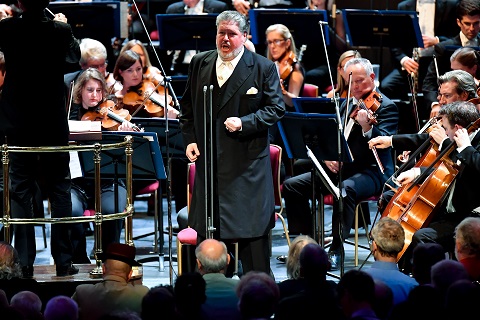 Stephen Gould (tenor). Photo credit: BBC/Chris Christodoulou.
Stephen Gould (tenor). Photo credit: BBC/Chris Christodoulou.
Christine Goerke’s very first line - ‘Zu neuen Taten’ - as she sings for him to go forth on new ventures rather begged the question of role reversal here. The voice is magnificently rich, so broad and dark in its tone, you wondered if her Siegfried, Stephen Gould, could ever be the heroic journeyman on his quest; the answer is he couldn’t. Likewise, if this is a love that burns with fire - ‘Brünnhilde brennt dann ewig hellig dir en der Brust’ - it never entirely felt one which was convincingly reciprocated. It wasn’t that Goerke sang as if she was detached from Gould’s Siegfried, rather that she was so daunting and fearsome you weren’t persuaded by it all. So much of the libretto here seemed entirely descriptive of Goerke’s assumption of Brünnhilde: fearless, powerful, stormy, raging - all emerging with effortless, even terrifying, strength from a voice that easily strode above an orchestra at full tilt. As the duet ends, the sheer chill factor of both singers’ ‘Heil! Heil!’ served to emphasise the size of one voice against the comparative meekness of the other.
Back to the orchestra again, and we got a beautifully phrased Rhine Journey, a gloriously graphic picture of the flowing river, before Gould gave an outstanding performance of Siegfried’s death scene. Where he had seemed remote in the Love Duet, the intensity he brought to his death was affecting. If you had wondered where the passion for his Brünnhilde might have been in the duet’s ‘Heil, strahlende Liebe!’ the answer was given in his inwardness and tenderness in the death scene’s ‘Ach, Dieses Auge’. The link to such a towering and brutal Death and March was quite astonishing: trenchant strings in unison like pallbearers, timpani that weren’t just menacing, but with a gravity that felt more terrifying than usual. It was enough to stiffen the sinews.
I’m not sure what happened with the transition between the end of March and the beginning of the Immolation Scene, but conductor and orchestra briefly drifted apart. Goerke doesn’t take this music as fiery as some sopranos; in fact, it’s such a slow burn, the tension she brings to it is unmistakably one that flickers, ignites and then blazes like an inferno. Some might find her voice, which is more bronze than golden, to lack sufficient colour - but this is all of a part with her embracing a Brünnhilde who would rather take her tone from the braying, yet velvety, tubas in the orchestra, rather than the steely horns. You hear betrayal in this voice, a desolation and dolefulness which often isn’t apparent in a more penetrating voice. It left an unforgettable impression, as did most of this concert. This was a Wagner evening which felt entirely Teutonic - a not inconsiderable achievement.
Marc Bridle
Christine Goerke (soprano), Stephen Gould (tenor), Marc Albrecht (conductor) Royal Philharmonic Orchestra.
Royal Albert Hall, London; Monday 9th September 2019.
image=http://www.operatoday.com/Christine%20Goerke%20soprano.jpg image_description= product=yes product_title=Prom 68: Wagner Night, the Royal Philharmonic Orchestra conducted by Marc Albrecht product_by=A review by Marc Bridle product_id=Above: Christine Goerke (soprano)Photo credit: BBC/Chris Christodoulou
September 11, 2019
2019 Wigmore Hall/Independent Opera International Song Competition
After four days of rounds in front of a distinguished panel of jurors and Wigmore Hall audiences, on Wednesday 11th September 25-year-old Mikhail Timoshenko won the £10,000 First Prize at Wigmore Hall’s International Song Competition, sponsored for the first time by Independent Opera .
The Final and Semi-Final rounds were live streamed to international
audiences and can still be viewed at
https://wigmore-hall.org.uk/
The £5,000 second prize place was awarded to 29-year-old British soprano Harriet Burns. Third place, with a prize of £2,500, went to British mezzo-soprano Beth Taylor and fourth to British tenor Kieran Carrel.
Michael Pandya, the 25-year old British pianist who partnered Harriet Burns, won the £5,000 Pianist’s Prize.
Mikhail Timoshenko studied at the Mednogorsk Conservatoire and the Hochschule für Musik Franz Liszt, Weimar. He has won top prizes in several other competitions in the past few years with his duo partner, pianist Elitsa Desseva, including First Prize at the Franz Schubert und die Musik der Moderne Competition in Graz, and the Hugo Wolf Competition in Stuttgart.
Director of Wigmore Hall and chair of the Jury John Gilhooly OBE says of the Competition:
‘The Wigmore Hall/Independent Opera International Song Competition is all about recognising and encouraging the next generation of great performers and there is no doubt that this thrilling week highlighted many wonderful musical personalities. The quality of the performances has been outstanding, and it is certain that the future of the great art of song is assured. Congratulations to Mikhail Timoshenko and to all our prize winners. We greatly look forward to hearing them again in future.’
Natalie Murray Beale, performer, jury member and Creative Director of Independent Opera said:
‘We've had an exceptional week, from the jury's viewpoint, witnessing exciting and brave performances from a wide range of talented young artists. Open masterclasses and expert talks have also given fascinating insights to performers and audiences alike. Independent Opera is delighted to have sponsored the competition and looks forward to its return in two years' time.’
Celebrating the art of song, the biennial International Song Competition has grown in status and prestige to become one of the most significant platforms worldwide for recognising young talent in song recital since it was established in 1997.
A truly international list of emerging performers aged 33 and under, all on the verge of embarking on significant international careers, had taken part during the week, which also included public masterclasses, coaching and feedback from some of the foremost international song performers and experts.
The Jury was mainly comprised of eminent performers including John Mark Ainsley, Iain Burnside, Bernarda Fink, Graham Johnson, Dame Felicity Lott, Thomas Quasthoff and Ailish Tynan.
image=http://www.operatoday.com/WH%20International%20Song%20Competition%202019.pngSeptember 10, 2019
An Englishman in Vienna: Stephen Storace
His celebrity-sibling, the soprano Nancy Storace, a favourite with Emperor Joseph II and prima buffa in the Italian opera troupe that he had established at the Burgtheater two years earlier, sang the role of Eginia - a young girl previously enamoured of Artidoro and now, as compelled by her fortune-hunting father, unhappily wed to Casimiro. Alongside Nancy was a roll call of Vienna’s finest: tenors Michael Kelly (as Valente, a middle-aged boffin) and Vincenzo Calvesi (Casimiro), baritone Stefano Mandini (Artidoro), bass Francesco Benucci (as Rosmondo, Casimiro’s grumpy, suspicious father), and sopranos Catarina Cavalieri (as Enrichetta, Casimiro’s sister) and Therese Teyber (as the meddling maid, Bettina).
Gli sposi malcontenti was followed in 1786 by Gli equivoci, with a libretto by Da Ponte based on Shakespeare’s The Comedy of Errors, which may well make it the first Shakespearian opera, predating Salieri’s Falstaff by several years. Yet, despite this promising start in Vienna, Stephen Storace ended his short career as de facto composer-in-residence at Richard Sheridan’s Drury Lane Theatre, having failed to find favour at London’s Italian opera company, and was scorned by subsequent critics as an uninspired arranger of pastiches. He died in 1796, at the age of just thirty-three years.
It was probably due to Nancy’s influence that her brother, who at that time had only some chamber music and a handful of songs to his name, and no previous experience of writing for the stage, was commissioned to write an opera for the Burgtheater. Sadly, it was also owing to Nancy’s incapacitation at the premiere, that the first night was a disaster.
Encouraged by her mother, Elizabeth, to wed the English violinist John Fisher (at eighteen years-of-age, she was barely half Fisher’s age), Nancy found herself married to a violent drunkard whose abuse adversely affected her health and threatened to derail her nascent career in Vienna. By the time, just a few months after their marriage on 29th March 1784, the Emperor had banned Fisher from Vienna for his abusive behaviour, Nancy was depressed, ill and pregnant. During the premiere of Gli sposi malcontenti she collapsed on-stage mid-aria in the opening act (some reports say that the performance was abandoned, others that the cover, Celestine Coltellini, stepped in). Nancy gave birth a few months later, whereupon Elizabeth Storace placed the baby girl in a foundling hospital, declaring that they didn’t care if the child lived or died: the unfortunate and unwanted baby duly obliged by perishing a few weeks later.
Nancy's return to the stage four months later was marked by the performance of the Cantata per la ricuperata di Ophelia, composed specially for the occasion by Mozart, Salieri and the unidentified ‘Cornetti’: perhaps it is not too far-fetched to speculate that Stephen himself was that third, anonymous contributor?
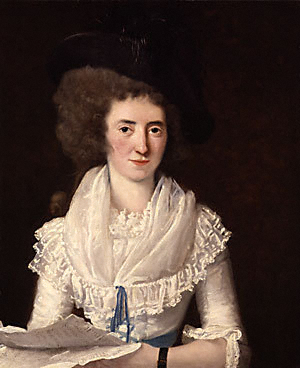 Ann Selina (Nacny) Storace (1765-1817), attrib. Benjamin Vandergucht, c.1790 © National Portrait Gallery, London.
Ann Selina (Nacny) Storace (1765-1817), attrib. Benjamin Vandergucht, c.1790 © National Portrait Gallery, London.
For, despite this inauspicious start, Gli sposi malcontenti entered the Burgtheater repertory and received many performances. In his book Antonio Salieri and Viennese Opera (University of Chicago Press, 1998), John Rice observes that while Emperor Joseph mixed comic operas written specifically for his Italian troupe with operatic imports from abroad - the troupe presented 62 operas at the Burgtheater between April 1783 and Joseph’s death in Feb 1790, of which only 23 were especially written for Vienna - the ‘home-grown’ operas tended to be given many more performances. Several operas received more than 20 performances and half of this group of favourites were written specifically for the Viennese troupe, including Figaro, Paisiello’s Il re Teodoro, Martìn’sUna cosa rara and L’arbore di Diana, Salieri’sLa grotta di Trofonio and Axur, and Storace’s Gli sposi malcontenti.
Performances of Gli sposi malcontenti were subsequently given across Europe: in Prague and Leipzig the following year, in Dresden in 1789, and (in French translation) in Paris in 1790. Some arias were arranged for wind band by Johann Went - a sign of their popularity and dissemination.
The son of a professional musician from Naples, Stephano, who had settled in London during the 1950s, and his wife Elizabeth, whose father, John Trusler, was an esteemed pastry cook and the proprietor of Marylebone Gardens, Stephen was born in London on 4th April 1762. A meeting with the Mozart family during their 1764-65 sojourn in England, encouraged Stephano to follow Leopold Mozart’s example in the education of his two musical prodigies, Wolfgang and Nannerl. Initially, Stephano taught his son violin, keyboard and composition, but fearing (probably rightly) that the quality of music education in London was inadequate, he sent Stephen to his alma mater, the San Onofrio Conservatory, under the care of an uncle who was a local bishop.
According to the Welsh landscape painter Thomas Jones, Stephen’s attentiveness to his studies left something to be desired. In his memoirs, Jones recounts several sketching expeditions throughout Italy which he undertook with the ‘a giddy, thoughtless young fellow’ as his companion, and the scrapes they got into may have prompted Stephano to travel to Italy in 1778 with his wife and the then twelve-year-old Nancy, who was already marking quite a mark as a singing prodigy.
In 1779, Stephen left San Onofrio and travelled with his family as Nancy pursued her career as an operatic soprano. The siblings met the Irish tenor Michael Kelly who, in his Reminiscences (1826), described them as ‘the warmest and most attached of all my friends’, and in 1783 Nancy and Kelly became members of Emperor Joseph II's opera buffa company at the Burgtheater.
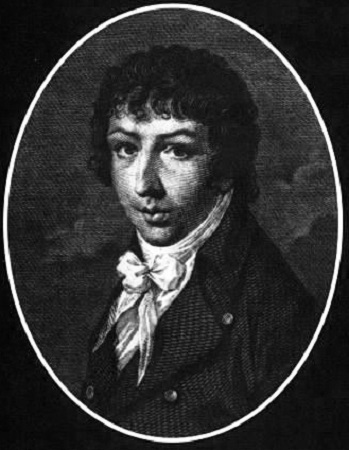 Stephen Storace.
Stephen Storace.
And, there they remained until Nancy, Stephen and Kelly returned to London in 1787. Their departure was delayed by Stephen’s arrest on 20th February by what Kelly described in his Reminiscences as drunken brawling at a Carnival ball. And, if we should doubt the garrulous Irishman’s account, Jane Girdham has shown that Stephen’s own words confirm the substance of the tenor’s tale, in the form of a letter addressed to a friend, J. Serres at 1 St George’s Row, Oxford Street, London, written on the morning after the night before [original spelling and punctuation preserved]:
'You might not have recieved a letter from me, so early as this, long good friend had it not been owing to a ridiculous circumstance that happen’d last night or rather early this morning - to make short of the story - it is some hours since I have been in a guard:house under an arrest-and of course having much leisure I know no better mode of passing my time than devoting it to my friends in England-but to inform you of some of the particulars - you must know that there never perhaps were so hard:a going sett of English in any one town out of England - as are at present in Vienna - we have lived these last six weeks almost in one continual scene of riot - amongst ourselves - as long as it remain’d so, nobody could find fault-but lately some of our youths - high:charged with the juice of French grapes - have made their occasional sallies - & exposed themselves to the natives especially at the Ridotta’s, or Masquerades - many of which have been given in the course of the newly expired Carneval a few nights ago the Honbl: Charles Lennox - Ld: Clifford and one or two others - courted some ladies-with rather too much vehemence-which occasion'd an order-that every Englishman that behaved with the least impropriety, at the ensueing Ridotta - (the one last night) should be put under an arrest-It so happen’d that about three oclock this morning as my Sister was dancing a minuet with Ld: Barnard, a Man who was standing by chose to stand in such a manner that Lord Barnard, turning the corner inadvertently trod on his toe - upon which he was rather impertinent-Ld: B took no notice but proceeded - on again coming to the same corner - the Gentleman took an opportunity of advancing still further into the ring & had nearly thrown him down - upon which I who was a stander by-with more spirit than prudence-asked him, ‘what he meant by being so impertinent as to attempt throwing down any gentleman that was dancing’ - he then immediately chose to use some very ungentlemanlike language - which I (who had rather too much Champaigne in me, though far beneath intoxication) could not brook - inshort words begat words - the whole rooms were presently in a confusion - the report was that an Englishman had mis:behaved we were almost press’d to death-by the multitudes that crowded round:us - my antagonist proved to be an officer-he immediatly apply’d to the officer of the guard - who sans:cerimonie put me under charge of a corporal’s guard - and I was conducted to the guard-house - from which place I have the honor of addressing to you this epistle - as all the English have taken up this matter warmly - I immagine I shall soon be liberated-and we shall strive hard to bring the aggressor to condign punishment.'
Storace seems to have borne his incarceration lightly, concluding his letter, ‘I can hardly refrain from laughing at the Idea of myself in durance vile.’ [1] In her book English Opera in Late Eighteenth Century London: Stephen Storace at Drury Lane (Clarendon Press, 1997), Gardham presents a comprehensive account of the little that is known of the details of Stephen’s biography, but remarks: ‘We may regret that the best documented event in Storace’s life was an incident of youthful indiscretion.’
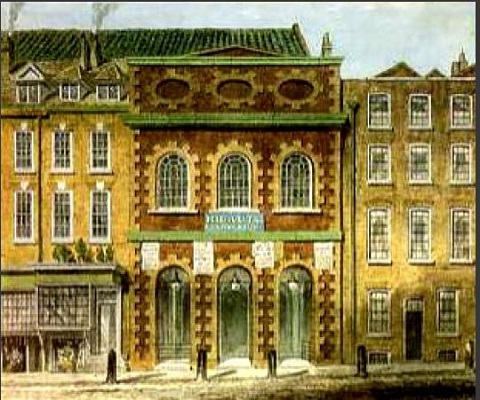 King's Theatre, Haymarket, 1783, William Capon.
King's Theatre, Haymarket, 1783, William Capon.
In London, the Storaces hoped to continue their careers in Italian opera at the King’s Theatre, meeting with some initial success as a singer and, in Stephen’s case, erstwhile arranger of pasticcios and director of music. Yet, despite their training and experience in opera buffa they were never fully accepted by the Italian clique. (Ironically, while Stephen emphasised his Englishness - both the score and libretto of Gli sposi malcontenti naming him as ‘Stefano Storace Inglese’ - Nancy affected an Italian accent and insisted her name be pronounced ‘Stora-ce’.) In 1788, Stephen moved to the Theatre Royal Drury Lane, where Sheridan already had Kelly in his employ, and he was followed shortly after by Nancy who became the company’s highest-paid singer.
After a failed attempt with a third Italian opera, La camariera astuta, Stephen devoted his Haymarket years to writing operas in English with spoken dialogue. Of his sixteen English operas, only one, No Song, no Supper, survives in full score. Not that these English operas were not popular: as late as 1864 a revival of No song, no supper at the Haymarket Theatre was, according to the reviewer in The Era (18 December) ‘most favourably received’, and the hope expressed that ‘a few more musical pieces from the old school may be similarly rescued from undeserved obscurity’. As Robert Fiske notes: ‘In view of numerous revivals in different theatres, many copies must have existed; presumably they perished in theatrical conflagrations. Twelve of the others were published, but only in vocal score with occasional instrumental indications, a sad fate for a composer in a position to benefit from Mozart's orchestration.’ [2]
And, the US was not immune to the pleasures of Stephen’s pasticcios. Otto E. Albrecht has charted opera performances in Philadelphia during the years 1800-30, noting that of the 258 different operas presented during this period ‘155 were British imports from the three Theatres Royal, Covent Garden, Drury Lane and the Haymarket’, and that ‘Those three Mozartians who left Vienna together in 1787, Michael Kelly the Irishman, Stephen Storace the Italian and Thomas Attwood the Londoner, between them accounted for no fewer than thirty of the operas given in Philadelphia in this period.’ [3]
Gli sposi malcontenti was, however, never performed in England during the 18th or 19 th centuries, although Storace was not averse to recycling his material and made frequent use of excerpts from both Gli equivoci and Gli sposi malcontenti in his English operas. From the latter, Storace imported two arias into The Pirates (1792), reused the overture in The Cherokee (1794) and made use of other excerpts in Mahmoud (1796).
The English premiere of Gli sposi malcontenti was given by Opera Viva at the New Theatre, King’s College London in March 1985, in a new English translation by Brian Trowell but the opera has not been performed since. Following Bampton Classical Opera’s 2000 production of Gli equivoci and more recent commemorative concert on the bicentenary of Nancy’s death, the company’s decision to return to the Storace siblings for their 2019 repertoire choice is most welcome. After performances earlier this summer at Bampton and Westonbirt, they bring their production of Gli sposi malcontenti - retitled in characteristically droll fashion, as Bride & Gloom (and performed in Trowell’s translation) - to St John’s Smith Square on Tuesday 17th September.
The libretto of Gli sposi malcontenti adheres to the familiar buffa recipe. Set in 18th-century Genoa, as the title suggests the plot centres on the ‘discontented newly-weds’, Eginia and Casimiro. Eginia is still burning a candle for Artidoro, but the latter’s eyes have been drawn by Casimiro’s sister, Enrichetta, and the pair are planning to elope. Valente, enraged by Enrichetta’s rejection of his own affections, salves his jealousy by spreading rumours that Artidoro and Eginia are having an affair. Casimiro and Rosmondo are alarmed by Artidoro’s suspicious behaviour. Valente, believing that his scheming is being aided by the maid, Bettina, exults in his success. But, Bettina has in fact exposed Valente’s villainy to Artidoro who arranges a nocturnal gathering in the garden so that the truth can be revealed, Eginia’s honour restored, and his marriage to Enrichetta assured.
Performed the year before the Viennese premiere of Le nozze di Figaro, Gli sposi malcontenti anticipates several features of Da Ponte’s action in the latter, not least an episode in which Artidoro hides behind and on a sofa, the muddle of mistaken identities in the night-time garden, and the final scene of reconciliation which sees Valente forgiven for his intrigues. Evidently, Beaumarchais’ Le mariage de Figaro was well-known, despite being banned in Vienna at that time.
Grove describes Gaetano Brunati’s libretto as well-constructed and suggests that Storace ‘manages to infuse the farcical misunderstandings with touching humanity. The music has a Mozartian flavour, combined with an English quality sometimes tending towards the ballad air’. Indeed, Robert Fiske ( Ibid.) has remarked that ‘About the time that his sister Nancy was creating the role of Susanna in Figaro, Stephen was having lessons in Vienna from its composer’, and although there is no certain evidence that Mozart gave Stephen lessons, they were certainly in close contact, and one may detect a Mozartian flavour in some aspects of his style, not least in the precedence that Stephen gave the music over the text. Fiske draws attention to an article on Storace in the Thespian Dictionary of 1802, which suggests that Stephen’s approach ‘cuts across the whole theory of English opera’: ‘It must, however, be remarked, that the words [of his librettos] were chiefly adapted to the music: indeed, Mr. Storace openly declared in a music-seller's shop in Cheapside (then Longman & Broderip’s) that it was impossible for any author to produce a good opera, without previously consulting his intended composer, for, added he, the songs must be introduced as he pleases, and the words (which are a secondary consideration) be written agreeably to his directions.’
Then, there is his predilection for ensembles and finales which further the action. Fiske goes as far as to suggest that, had he lived, ‘Storace might well have established fully-composed comic opera in the London playhouses.’ He argues that, at the King’s Theatre, Stephen: ‘turned his attention to educating his new public, who were primarily play-goers, and training them to foster a greater appreciation of the increasing integration of libretto and music on the stage. He introduced his London audiences to the multi-section finales that were commonplace in opera buffa, most notably in The Pirates (1792).’
Interestingly, Dorothea Link included arias by Stephen Storace in her three editions, Arias for Nancy Storace, Mozart’s First Susanna (2002),Arias for Francesco Benucci,Mozart’s first Figaro and Guglielmo (2004), andArias for Vincenzo Calvesi: Mozart’s First Ferrando (2011). In the preface to the 2002 edition which brings together fifteen of Nancy’s most popular arias, Link sets out her aim to ‘establish a basis for creating a vocal profile for Nancy Storace’ and to ‘allow aspiring Susannas to sing their way into the role with comparable repertory’.
Some expected ‘hits’ appear, such as ‘Deh vieni, non tardar’ ( Figaro), ‘Ah non ver che in seno’ from Salieri’s La scuola de gelosi , and ‘D’un dolce amor la face’ and ‘La ra la ra, che filosofo buffon’ from the latter’s La grotta di Trofonio , but Link also notes that Stephen Storace composed many of the ‘hits in productions other than premieres’, and selects five examples from his work, including ‘Compatite miei signori’ (1783), a substitute aria for Giuseppe Sarti’s Fra i due litiganti, and ‘Care donne che bramate’ which was inserted into Paisiello’s Il re Teodoro in Venezia for the opera’s London premiere in December 1787. Stephen’s recitative and aria ‘Fra quest’orror ... Ma tarde le la grime’ from Gli sposi malcontenti serves as ‘an example of an aria for which Nancy wished to be admired’.
To conclude, Fiske’s assessment of Stephen Storace’s work suggests that it has languished in undeserved neglect:
‘Alone of English eighteenth-century composers, Storace and [Charles] Dibdin had a sense of the theatre, a feeling for characterisation and dramatic effect. Arne's melody was more refined, but neither he, [William] Boyce, nor [William] Shield, let alone small fry like [Samuel] Arnold, had this gift for composing so to speak visually, with the stage effect in mind as the notes go down on paper. Nor had they the advantage of knowing Figaro and its composer.’
Bampton Classical Opera performs Stephen Storace’s Gli sposi malcontenti (Bride & Gloom) at St John’s Smith Square, London at 7pm on Tuesday 17th September 2019. There will be a pre-performance talk at 6pm.
Claire Seymour
[1] S. Storace to J. Serres Esq., 21st February 1787, Vienna (Harvard Theatre Collection), reproduced in Jane Girdham, 'Note on Stephen Storace and Michael Kelly', Music & Letters 76/1 (1995): 64-67.
[2] Roger Fiske, 'The Operas of Stephen Storace', PRMA 86 (1959-60): 29-44.
[3] Albrecht, Otto E. Albrecht, 'Opera in Philadelphia, 1800-1830', Journal of the American Musicological Society 32/3 (1979): 499-515. The operas by Storace identified by Albrecht are: My Grandmother, 27th January 1804; The Haunted Tower, or The Baron of Oakland, 3rd February 1800;The Siege of Belgrade, 11th February 1800; No Song, no Supper, 17th February 1800; The Prize, or 2, 5, 3, 8, 9th April 1800; The Doctor and the Apothecary, 6th February 1804; The Iron Chest, or Honor’s Victim, 1810. These operas were all also performed in Philadelphia during the 1790s.
Copper eng., coloured, by Eduard Gurk (1801-1841); From the series: Wiens vorzügl. Gebäude und Monumente, 1823
September 9, 2019
Stendhal on the Rossini Revolution
The art of bel canto was created in the year 1680 by Pistocchi; and its progress was hastened immeasurably by Pistocchi’s pupil, Bernacchi (c. 1720). The peak of perfection was attained in 1778, under the aegis of Pacchiarotti; but since that date, the race of male sopranos has died out, and the art has degenerated.
Millico, Aprile, Farinelii, Pacchiarotti, Ansani, Babini and Marchesi all owed their reputation to this style favoured by the older composers, who, in certain passages of their operas, provided the interpreter with scarcely more than a framework or canvas,[1] upon which to work out his own conceptions; and there is scarcely a single one of these great singers who did not, in addition, enrich the lives of his contemporaries by fostering the talents of two or three first-class prime donne. The biographies of such fine cantatrici as la Gabrielli, la de’ Amicis, la Banti, la Todi and others, all reveal the names of the famous soprani from whom they had learnt the supreme art of managing a voice.
More than one of the leading prime donne of our own generation owes her talents to Velluti – Signorina Colbran, for instance.
The supreme qualities of the soprani and of their pupils were seen at their most resplendent in the execution of largo and cantabile spianato passages; and we have a beautiful example of this style of writing in the prayer-scene from Romeo e Giulietta. Yet this precisely was the type of aria which Rossini, ever since the moment when he arrived in Naples and adopted what is now known in Italy as his “second manner”, has been at greatest pains to eliminate from his operas. In former days, a singer might train for six or eight years before being able to achieve a true largo, and the patient perseverance of Bernacchi, for instance, is proverbial in the history of the art. But once this degree of perfection, purity and sweetness, which the generation of 1750 considered to be the sine qua non of good singing, had finally been attained, the singer had nothing further to do but to reap his reward; his reputation and his fortune lay ready to hand. However, since Rossini has appeared on the scene, success or failure in the execution of a largo passage has become a matter of sublime indifference, and if ever such a passage were to be offered to any of our own audiences to-day, I can hear, even from where I now sit, the echoes of that little proverb about the devil and his own funeral. … That poor audience would be bored to death; and the reason is simple because it would find itself being addressed in a foreign language which it thinks it knows, but which in fact it needs to sit down and re-learn from the beginning.
The older style of singing could stir a man to the innermost recesses of his soul; but it could also prove rather boring; Rossini’s style titillates the mind, and is never boring. It is a hundred times easier to acquire a fair enough proficiency to give a competent rendering of one of Rossini’s great rondo movements (the rondo from la Donna del Lago, for instance), than it is to achieve a similar standard in some great aria by Sacchini.
The subtleties involved in sustaining a long holding-note; the art of portamento; the technique of modulating the voice so as to make it fall with equal stress upon every note in a legato passage; the skilled control which enabled a singer to draw breath quite imperceptibly, without interrupting the long-drawn phrases of vocal melody so typical of the arias of the old school[2] – these and similar qualities represented formerly the most difficult and the most essential attainments of a good performer. The mere agility, remarkable or otherwise, of the voice, served only one purpose: it was employed in the execution of gorgheggi, i.e., it represented a luxury, it was used for display, or, in a word, for supplying an element of superficial glitter, and never for providing those essential qualities which were to shake and stir the soul. Every aria was provided, towards the conclusion, with a cadenza, usually of some twenty bars, whose whole raison d’être was to allow the singer to perform tricks with the muscles of his throat,[3] and to indulge in gorgheggi.
Rossini has been responsible for a musical revolution; but even his sincerest friends blame that revolution for having restricted the boundaries of the art of singing, for having limited the qualities of emotional pathos inherent in that art, and for having rendered useless, and therefore obsolete, certain technical exercises, valueless in themselves, but which could ultimately lead to those transports of delirium and rapture which occur so frequently in the history of Pacchiarotti and other great artists of an earlier generation, and so very rarely to-day. The source of these miracles lay in the mystic powers of the human voice.
The revolution inaugurated by Rossini has killed the gift of originality in the singer. What incentive can any singer have nowadays for taking infinite pains to convey to his audience, firstly, the native and individual quality of his voice, and secondly, the precise shade of expression by which it may be endowed through his peculiar and original sensibility? In Rossini’s operas he is doomed to wait for ever in vain for one single opportunity to display these rare qualities, whose acquisition may have cost him literally years of unrelenting labour. But in any case, the mere habit of expecting to find everything already worked out, already noted down in black and white in the music from which he has to sing, is enough to kill his own inventiveness, to quench the last spark of initiative within him, and to induce a fundamental attitude of laziness. The average modern composer makes no greater demands in his score than can be fulfilled by the exercise of a moderate degree of technical competence in a specifically material field: the field, in fact, of the instrumentalist. Rossini’s attitude of lasciatemi fare (leave everything to me), which is typical of his relations with his interpreters, has now reached such a pitch, that the latter may not even dispose of the right to improvise on the last note of all; in almost every instance, Rossini will be found to have supplied his own embroidery.
In days gone by, the great singers, Babini, Marchesi, Pacchiarotti, etc., used to compose their own ornamentation whenever the musical context required an exceptionally high level of complexity; but in normal circumstances, they were concerned with extempore invention. All the various categories of simpler embellishments (appoggiature, gruppetti, mordenti, and so on) were theirs to dispose and arrange as they thought best, spontaneously, and following the dictates of their art and their inner genius; the whole art of adorning the melody (i vezzi melodici del canto, as Pacchiarotti used to call it, when I met him in Padua in 1816) belonged by right to the performer. For instance, in the aria:
Ombra adorata, aspetta …[4]
Crescentini would suffuse his whole voice and inflexion with a broad and indefinable colouring of satisfaction, because it would strike him, while he was actually standing up and singing, that an impassioned lover about to be reunited with his mistress probably would feel something of the sort. But Velluti, who perceives the situation rather differently, interprets the same passage in a vein of melancholy, interspersed with brooding reflections upon the common fate of the two lovers. There is no composer on earth, suppose him to be as ingenious as you will, whose score can convey with precision, these and similar infinitely minute nuances of emotional suggestion : yet it is precisely these and similar infinitely minute nuances which form the secret of Crescentini’s unique perfection in his interpretation of the aria; furthermore, all this infinitely minute material is itself in a perpetual state of transformation, constantly responding to variations in the physical condition of the singer’s voice, or to changes in the intensity of the exaltation and ecstasy by which he may happen to be inspired. At one performance, he may tend towards ornaments redolent of indolence and morbidezza; on a different occasion, from the very moment when he sets foot on the stage, he may find himself in a mood for gorgheggi instinct with energy and life. Unless he yield to the inspiration of the moment, he can never attain to perfection in his singing. A great singer is essentially a creature of nerves; a great violinist, on the other hand, needs a temperament of a radically different quality.[5]
But in any case, it is fundamentally wrong for the composer to elaborate all the ornamentation, for the simple reason that he would have to possess a perfect and intimate knowledge of the voice for which his music is destined, whereas this knowledge is something which can be known only to the singer who possesses it, and who has spent perhaps twenty years studying it and training it to the required flexibility.[6] A single ornament, I will not say badly, but even unenthusiastically performed, rendered dutifully but without brio, can destroy in an instant every shred of enchantment which had ever existed. You had been in heaven; but now you come tumbling down into the prosaic world of a box-at-the-opera; and you can count yourself lucky if you have not landed bang in the middle of a singing-lesson!
[Stendhal, and Richard N. Coe. Life of Rossini. (New York: Criterion Books, 1957), 341–345. (Translator’s notes omitted)]
[1] The great singers of this school never actually altered the theme of an aria; they gave It first in a comparatively simple rendering, and then proceeded to embroidery. At the end of each aria, they were normally given some twenty bars to be filled ad lib. with gorgheggi and other light embellishments of this nature; and finally, the song concluded with a bravura passage; v. for instance, pria che spunti …, from il Matrmomo segreto. This particular aria belongs to a category known in Naples as arie di narrazione.
[2] I find it to all intents and purposes quite impossible to write adequately of the art of singing in any language other than Italian: here is the passage which I have just written as it would have appeared in the original: Le ombreggiature per le messe di voce, il cantar di portamento, l’arte di fermare la voce per farla fluire eguale nel
canto legato, l’arte di prender fiato in modo insensible e senza troncare il lungo periodo vocale delle arie antiche.
[3] The word gorgheggi is associated with the verb gorgheggiare, to make warbling noises in the throat. Cf. French: gorge = throat; English: gargle. (Trans.)
[4] Adored shade, wait …!
[5] The greatest violinist in Italy, and perhaps in all the world, is Paganini, who is still a youngish man, thirty-five years old, with black, piercing eyes and dishevelled hair. This ardent creature did not stumble upon the secrets of his divine art by dint of eight years’ dogged perseverance through the Conservatoire; a hasty impulse inspired by loving too well (so the legend goes) resulted in long years of imprisonment; and there, solitary and abandoned in a dungeon which might well have had no issue save to the scaffold, he discovered that the only companion who could console him in his fetters was his violin. Gradually he acquired the art of expressing the very whispers of his soul in sound; and the endless, dragging evenings of captivity gave him ample time to perfect this new language. Paganini should not be heard when he is striving to emulate the violinists of the North in some mighty concerto; but rather on some informal evening when he is in the mood and playing capriccios. Let me hasten to add that these capriccios present just as many difficulties in execution as any concerto!
[6] Velluti always prepares three different sets of ornamentation for any given passage; so that, when the instant of performance arrives, he can choose the one which best suits his mood. This precaution ensures that his embellishments never sound forced (stentati).
image=http://www.operatoday.com/Stendhal.png image_description=Stendhal, by Olof Johan Södermark, 1840 [Source: Wikipedia] product=yes product_title=Some Details concerning the Revolution inaugurated by Rossini product_by=Stendhal (Marie-Henri Beyle, 1783–1842) product_id=Above: Stendhal, by Olof Johan Södermark, 1840 [Source: Wikipedia]Prom 65: Danae Kontora excels in Mozart and Strauss
An assemblage of instrumental items by Mozart, Richard Strauss and Beethoven might have proved difficult to sequence and balance. To close with Beethoven’s 40-minute Seventh Symphony threatened to overwhelm the slighter Mozart amuse-bouches - a three-minute Cassation, some short arias - heard previously. And, while both Capriccio and Ariadne auf Naxos see Strauss exploring the very nature of opera itself, the opening sextet from Capriccio - elegant, wistful and ardent by turn - might seem a strange bedfellow for Zerbinetta’s’ Grossmächtige Prinzessin!’ with its worldly advice on life and love.
In the event, it all made perfect sense. And, the charm and success of the evening was due in no small part to the contribution of Greek soprano Danae Kontora. Based at Oper Leipzig, Kontora has performed across Germany and with Greek National Opera and Israel Opera. Next season will see her make her debut at the Vienna State Opera. As far as I can tell this was not just her Proms debut, but - other than performances at the Edinburgh International Festival, as Woglinde in a concert-performance of Götterdämmerung a couple of weeks earlier, and as a last-minute stand-in Woodbird in Siegfried in 2018 - also, to date, a rare appearance in the UK. I hope some of country’s casting agents were in the Royal Albert Hall and have started making the calls and contacts that will bring Kontora back to London soon.
How both Mozart and Strauss would surely have delighted to hear their music performed with such effortless, silvery sweetness - the drama so fluently expressive, the vocal peaks reached so pure and integrated within a cohesive architecture. Both the concert arias by Mozart that we heard were written for one of his singing students, Aloysia Weber Lange, with whose voice Mozart became infatuated and for whom he composed at least eight arias, all difficult and all exploiting her strong upper range. When she was only sixteen years old, Mozart commented, in a letter to his father, “she sings most admirably and has a lovely, pure voice”, and a little later: “"As far as her singing is concerned, I would wager my life that she will bring me renown. Even in a short time she has already greatly profited by my instruction, and how much greater will the improvement be ...”.
The text of ‘Popoli di Tessaglia … Io non chiedo, eterni dei’ is Alcestis’ entrance scene in Gluck’s Alceste, in which she beseeches the gods, in a noble, dramatic and intensely personal lament, to spare the life of her husband, Admetus, King of Thessaly. Kontora walked regally onto the platform during the closing bars of the overture to Die Entführung aus dem Serail, and Carydis guided the mood from spirited to sombre, the strings sighing achingly as oboe and bassoon twisted in torment. Dignified and strong, in dramatic, grand recitative Kontora presented Alceste’s pleas plaintively but proudly, as oboe and bassoon obbligatos wove expressively around her entreaties. The orchestral colour softened during the gentle syncopations of the subsequent major-key Andante sostenuto e cantabile, preparing for a fluent, warm prayer in which the vocal decorations unfolded silkily, the coloratura crystalline, and which was followed by a fired-up Allegro assai - all vigorous strings and punchy horns - in which Kontora demonstrated both control and agility. If her first soaring ascent to a high G was a fraction short of the target, then she nailed it absolutely the second time round, the tone of her soprano remaining full and true however high she climbed.
When, in Vienna in 1783, Weber Lange was to appear in Pasquale Anfossi’s opera Il curioso indiscreto, Mozart - who had by then married Constanze, Aloysia’s sister - composed three arias for insertion in Anfossi’s score, two of which were written for his favoured soprano. ‘No, no, che non sei capace’ presents Clorinda’s indignant denials when accused by her husband of infidelity. The haughty dismissals of the recitative were all the more dramatic for having emerged from the stately grace of the preceding Cassation, with Carydis emphasising dynamic contrasts and sforzandi, the strings dancing on tiptoe in the pianissimos and digging in brusquely in the fortes. Kontora sailed brilliantly and tirelessly through the roulades and fireworks, making light of the virtuosity and inserting some expressive decorations of her own to shape the transitions between the various sections and moods.
One might imagine that a string sextet would seem a little ‘lost’ in the vastness of the Royal Albert Hall but, on the contrary, the six instrumentalists of the Deutsche Kammerphilharmonie Bremen perfectly captured that ‘distant but immediate’ quality of the sextet which opens Strauss’s Capriccio - which is, after all, designed to evoke the eighteenth-century world in which the opera is set and to inspire a strong emotional and visceral response. As we listened ‘from afar’, the players seemed immersed in their music-making, but their collection expression had the power to reach out across the Hall. Once again, the vocal solo emerged from the preceding instrumental music, a simple piano chord bringing to a close the strings’ sentimental winding and the subsequent piano-based sonority, with cheeky woodwind interjections, established a light-hearted, even cabaret-esque, mood.
There was a beguiling directness about this Zerbinetta’s advice to the despairing Ariadne: every word was crystal clear, the sentiments sincere, the recollections of past romantic encounters and adventures carefree - utterly untrammelled by shadows or regret. The insouciance - complemented by capricious flute and oboe echoes - was balanced by sudden surges of heartfelt fellow-feeling and musical intensity, as when Zerbinetta impresses upon Ariadne that she is not alone in her anguish - where is the woman who has not suffered it? Independence of spirit and exuberance gradually infused her honest recollections of romance, flourishing in a gloriously flowing declaration: ‘I deceive him in the end yet love him truly.” The elaborate listing of past lovers was a delight of floating flightiness, the accompanying musicians playing with chamber-like intimacy combined with dramatic expressiveness, while Zerbinetta’s reliving of her erotic transportation and surrender was by turns ecstatic and then pensive, almost ethereal, enhanced by a beautiful cello solo, finally summitting in fountains of roulades and trills, as clean as a whistle even on the highest sustained Ds.
The first half of the concert had concluded with a lovely performance of Mozart’s Haffner Symphony. On the podium, Carydis exudes energy and a confident appreciation of the dramatic sweep of the whole, bending his knees to lower his arms to the floor, seeming to dig deep into the air, and then rising again, embracing all in his outstretched arms which wave, arc, sculpt and dance. Clearly the detail has been done and dusted in rehearsal, and players and conductor can confidently communicate their collective understanding and feeling. Cardyis encourages quite a raw sound at times, with little vibrato, but the Bremeners can sing softly and sweetly too. Such contrasts were even more strongly felt in the final work of the Prom, Beethoven’s Seventh Symphony.
I’ve recently been reading Beethoven for a Later Age by Edward Dusinberre, the leader of the Takács Quartet, in which the violinist, reflecting on the alternative endings of the Op.130 quartet and the ambivalences and contradicts that dominate the composer’s late style, remarks perceptively that the essence of the apparently irreconcilable contrasts in Beethoven’s music, evident from the earliest works, is the discomforting juxtaposition, even co-existence, of the ethereal and the demonic. Dusinberre views this disconcerting conflict as evidence of Beethoven’s ‘ambition to integrate lightness and weight, youthfulness and experience, comedy and tragedy’. This performance of the Seventh Symphony seemed to embody that quest for integration, and if such a quest must end ultimately in failure, the pursuit will be unsettling and inspiring in equal measure - and in this case, incredibly uplifting, as the Prommers’ roar of applause - and the affectionate embraces with which the musicians showed their gratitude to each other, as they left the stage - confirmed.
Claire Seymour
Prom 65: Mozart - The Abduction from the Seraglio K384, Overture; Aria: ‘Popoli di Tessaglia! - lo non chiedo, eterni dei’ K316; Cassation No.1 in G major, Andante; Aria: No, no, che non sei capace’ K419; Symphony No.35 in D major, ‘Haffner’ K385; Richard Strauss - Capriccio, Sextet; Ariadne auf Naxos, ‘Grossmächtige Prinzessin!’; Beethoven - Symphony No.7 in A major
Danae Kontora (soprano), Constantinos Carydis (conductor), Deutsche Kammerphilharmonie Bremen
Royal Albert Hall, South Kensington, London; Saturday 7th September 2019.
image=http://www.operatoday.com/Danae%20Kontora.JPG image_description= product=yes product_title=Prom 65: The Kammerphilharmonie Bremen conducted by Constantinos Carydis play Mozart, Beethoven and Richard Strauss product_by=A review by Claire Seymour product_id=Above: Danae Kontora (soprano)Photo credit: BBC/Chris Christodoulou
September 7, 2019
British Youth Opera: Rossini's La Cenerentola
Stendhal blamed the banality of the music - ‘a servants’ hall vulgarity’ - which failed to inspire his imagination, because it left too little to the imagination.
The same certainly could not be said of director Stuart Barker’s production of Rossini’s prince-and-pauper fairy-tale romance for British Youth Opera at the Peacock Theatre, which found a perfect balance between fantasy and realism. Bek Palmer’s designs merged the Dickensian with the Expressionistic, with an occasional dash of Walt Disney thrown in. The acute rakes, plunging angles and oppressive shadows of the Act 1 set established the grey, bleak world in which Angelina toils and suffers: after all, the very name Cenerentola suggests a life lived amid ashes - and on this occasion the bullying Don Magnifico and his dastardly daughters, Clorinda and Tisbe, practically shoved this ragged Angelina into the fire-place with a broomstick. The only touch of colour was the purple velvet of ‘Dandini’s’ jacket and ‘Prince Ramiro’s’ splendid green spencer jacket - the gilt trimming and brocade hinting at Cinders’ future good fortune, perhaps.
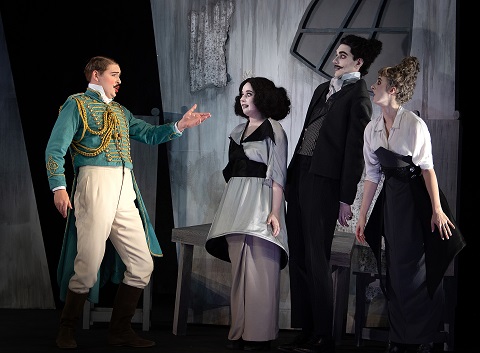 Jerome Knox (Dandini), Natalie Davies (Tisbe), Adam Maxey (Don Magnifico) and Holly Brown (Clorinda). Photo credit: Bill Knight.
Jerome Knox (Dandini), Natalie Davies (Tisbe), Adam Maxey (Don Magnifico) and Holly Brown (Clorinda). Photo credit: Bill Knight.
Transformation came via a starry indigo front-drop, as Angelina was whisked in a crescent-moon stagecoach - the man-in-the-lunar-carriage smiling beneficently - to the Klimt-like arbours, vaults and turrets of the Prince’s palace, for Act 2. There may be no glass slipper in librettist Jacopo Ferretti’s version of the fairy-tale, but Angelina’s essential goodness and preciousness seemed reflected in her surroundings - a shimmering dazzle of gold and light.
Rossini makes considerable demands upon his cast and the young singers uniformly met them with panache. Mezzo-soprano Siân Griffiths has made a strong impression as part of the ensemble in several recent BYO productions - Riders to the Sea and Sāvitri Riders to the Sea and Sāvitri (2015), English Eccentrics (2016) and Judith Weir’s The Vanishing Bridegroom (2017) - and it was satisfying to see her take her moment in the title role in her stride, expressively establishing Angelina’s sadness and gentility in ‘Una volta c’era un re’ and stylishly negotiating the glittering coloratura and gleaming peaks of ‘Nacqui all’affanno’. Griffiths’ mezzo has a lovely darkness at the bottom, capturing the depth of Cinders’ melancholy, and it brightens as it rises, accurately and agilely nailing every individual note in Rossini’s fearsome fioritura.
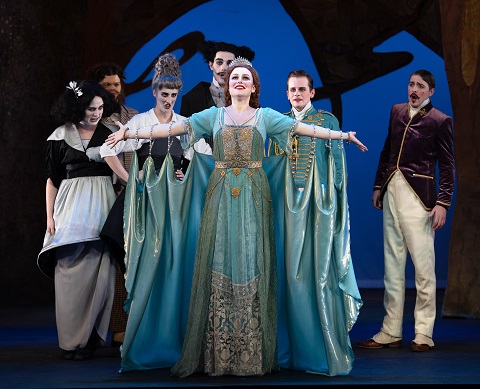 Siân Griffiths (Angelina). Photo credit: Bill Knight.
Siân Griffiths (Angelina). Photo credit: Bill Knight.
Ferretti avoided the erotic symbolism of the glass shoe, replacing it with a bracelet, so we are spared the gruesome sight - à la Brothers Grimm - of the sisters hacking at their toes in order to stuff them into the silken slipper. But, this ghastly pair were a grisly duo indeed: Holly Brown (Clorinda) and Natalie Davies (Tisbe) groaned and grimaced with a sourness that would curdle the blood, all the while singing with winning gloss and glitter, and interacting with terrific comic accord - it was hard to believe that they weren’t in fact sisters.
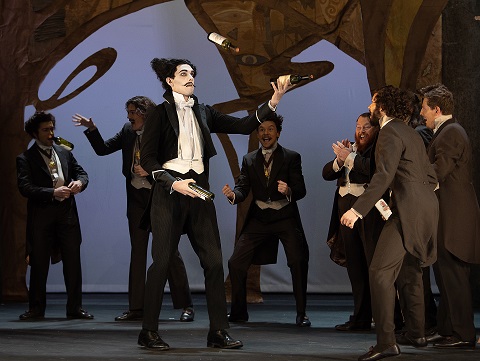 Adam Maxey (Don Magnifico). Photo credit: Bill Knight.
Adam Maxey (Don Magnifico). Photo credit: Bill Knight.
I admired Adam Maxey’s Figaro at the RCM last autumn and he used his strong baritone to balance the brutality and buffoonery which characterise Don Magnifico: threatening Angelina with violence and cruelly pronouncing her to be dead with the Prince comes calling, and ebulliently juggling the Prince’s vintage vinos in celebration of his promotion to ‘Master of the Wines’. The surreal cavatina in which Don Magnifico dreams he is an donkey, but a dignified one - “un bellissimo somaro … ma solenne” - was exuberantly comic. Maxey’s height - and his coiffure and superciliary extravagance (a touch of Disney’s Lady Tremaine, perhaps?) - helped him command the stage, and made Don Magnifico’s fall from disdain to discomfort all the more satisfying.
Liam Bonthrone was a Prince Ramiro of integrity. Bonthrone and Griffiths blended beautifully in their Act 1 duet, ‘Un soave non so che’, both crafting shapely melodies, and the tenor fearlessly climbed to the top of Rossini’s challenging vocal lines, using the energy of the music to suggest the Prince’s ardency and nobility. Jerome Knox enjoyed his chance to be Prince for a day: his Dandini was confident and ingratiating.
Ferretti gives Angelina no fairy godmother to replace her own absent one. Instead, she has to make do with Alidoro, allegedly the Prince’s tutor. In BYO’s The Rake’s Progress last year, bass Thomas Mole was a splendid Keeper of the Madhouse, a title that might have been just as fitting on this occasion: attired in a tweed suit and adorned with charmingly whimsical whiskers, Mole was an altruistic guardian, ensuring that goodness got its just rewards but retaining just the right touch of mystery and magic.
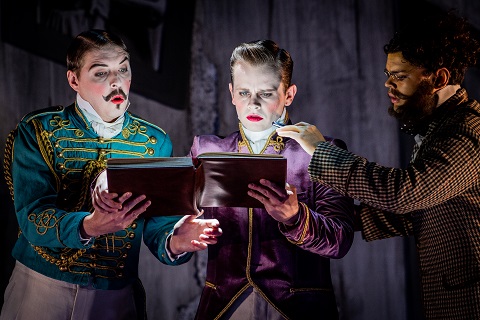 Jerome Knox (Dandini), Liam Bonthrone (Prince Ramiro), Tom Mole (Alidoro). Photo credit: Robert Workman.
Jerome Knox (Dandini), Liam Bonthrone (Prince Ramiro), Tom Mole (Alidoro). Photo credit: Robert Workman.
In the pit, conductor Peter Robinson led the Southbank Sinfonia in a performance that failed to match the dizzying, dazzling action on stage. The instrumental playing was competent but lacked the kaleidoscopic colour and movement which Rossini score offers.
The performance was sung in Wilfred Judd’s 1986 English translation in order, according to Assistant Conductor Chloe Rooke’s programme note, to ‘give the singers the opportunity to communicate directly with an audience and to reproduce English speech rhythms in their working of the musical lines’. Well, they certainly communicated with punch - particularly impressive given the rather unhelpful Peacock Theatre acoustic - but since the open vowels and soft consonants of the Italian language, particularly at word-endings, facilitate the bel canto style, one wonders whether the young singers might have welcomed the opportunity to develop their skills in that idiom.
That said, this was a delightful evening of astute comedy and accomplished singing. The young cast were fully in command of their roles and the drama unfolded with a naturalism that belied the comic follies. Ferretti eschews the dark conclusion of the Brothers Grimm - in which the sisters have their eyes pecked out by doves, punished for their wickedness with blindness - preferring Charles Perrault’s reconciliation in which Angelina pardons her sisters for their former viciousness. Given the current confusions and absurdities of contemporary public life, it’s reassuring to think that, perhaps, a ‘Happy Ever After’ ending might be possible after all.
Claire Seymour
Clorinda - Holly Brown, Tisbe - Natalie Davies, Angelina - Siân Griffiths, Don Ramiro - Liam Bonthrone, Dandini - Jerome Knox, Don Magnifico - Adam Maxey, Alidoro - Thomas Mole, Chorus (Joseph Chalmers, George Reynolds, Matthew Salter, Theo Perry, Ben Knight, Tormey Woods, John Holland-Avery, Joseph Hookway, William Rennie, Matthew Secombe, Samuel Kibble); Director - Stuart Barker, Conductor - Peter Robinson, Designer - Bek Palmer, Movement Director - Caitlin Fretwell-Walsh Lighting Designer - John Bishop, Costume Supervisor - Laura Pearse, Southbank Sinfonia.
Peacock Theatre, London; Tuesday 3rd September 2019.
image= http://www.operatoday.com/Adam%20Maxey%20and%20Sian%20Griffiths.jpg image_description= product=yes product_title=British Youth Opera: Rossini’s La Cenerentola product_by=A review by Claire Seymour product_id=Above: Adam Maxey (Don Magnifico) and Siân Griffiths (Angelina)Photo credit: Robert Workman
September 6, 2019
PUCCINI: Manon Lescaut
Giacomo Puccini (1858–1924), composer. Luigi Illica and Domenico Oliva, librettists.
First performance: 1 February 1893 at Teatro Regio, Turin.
Introduction
In 1889 there was serious doubt whether Giacomo Puccini would succeed as a composer of operas. The premiere of Edgar met a cool, if not hostile, reception. It was canceled after three performances. In its original form — it was revised numerous times without success — Edgar followed the style of grand opera, a style that would be obliterated the following year with the performance of Mascagni’s Cavalleria rusticana, the first verismo opera. Further, Puccini was drawn to musical developments in Germany, particularly those of Wagner, the reception of which in Italy was mixed at best.
Puccini, with the backing of his publisher, Giulio Ricordi, pressed on. He proposed two operas — one based on Prévost’s novel Manon Lescaut and another on Sardou’s play Tosca. Sardou was unwilling to license his work to an unestablished composer; and Ricordi was reluctant to underwrite Manon Lescaut given the wide success of Massenet’s Manon that premiered in 1884. In any event, Puccini moved forward with the project. There were many difficulties in producing a libretto that met Puccini’s standards. Many hands contributed to the libretto, including Domenico Oliva, Marco Praga, Giulio Ricordi and Ruggero Leoncavallo. It was the introduction of Luigi Illica to the team that rescued the libretto.
The libretto, while more faithful to Prévost than Massenet’s work, sentimentalizes Manon and Des Grieux. The first act closely resembles that of Massenet’s Manon. The second act reduces the magnitude of Manon’s infidelities as portrayed by Prévost, yet captures her avarice. Des Grieux remains a lovestruck sap. The third act, which begins with an intermezzo, is dark, undoubtedly influenced by Wagner’s Tristan und Isolde, according to Julian Budden. The last act is a static setting that features only the final moments between Des Grieux and Manon.
Characters
| Dancing-Master | tenor |
| Edmondo, a student | tenor |
| Geronte di Ravoir, Treasurer-General | bass |
| Il cavaliere des Grieux, a student | tenor |
| Innkeeper | bass |
| Lamplighter | tenor |
| Lescaut, Manon’s brother, Sergeant of the Royal Guards | baritone |
| Manon Lescaut | soprano |
| Naval Captain | bass |
| Sergeant of the Royal Archers | bass |
| Singer | mezzo-soprano |
Synopsis
Act I
Young Manon Lescaut is very beautiful and attracts a great deal of attention. Des Grieux, a student, addresses her and falls in love with her. At first she is rather shy and withdrawn, as she is in the company of her brother. Geronte, a rich old man, also has his eye on her. He questions her brother, Lescaut, about the family circumstances and decides to abduct Manon. Des Grieux is warned by his friend Edmondo, who has overheard what Geronte is planning, and wastes no time in confessing to Manon that he is in love with her, a feeling which she reciprocates. The young couple flee. Lescaut comforts Geronte; he tells him that it will not be long before Manon comes to him as he knows how fond of luxury she is.
Act II
Lescaut’s plan has been successful. Manon has left Des Grieux, tired of living in modest circumstances, in favour of a more luxurious life with Geronte. In a conversation with her brother, however, she admits that in spite of her new-found wealth she has still not been able to find true happiness. When she meets Des Grieux again, the latter reproaches her for leaving him. She begs his forgiveness, entreating him to remember their love for each other. He again succumbs to her charms and Geronte returns to surprise the two lovers. Des Grieux urges Manon to flee with him immediately, but she lingers, wanting to keep some of Geronte’s wealth for herself. The couple learn from Lescaut that Geronte intends to have Manon arrested. Their attempt to escape fails.
Act III
Des Grieux and Lescaut have hatched a plan to rescue Manon from imprisonment, but the plan fails. Her disgrace is made public. Des Grieux remains loyal to her and stays at her side.
Act IV
Manon and Des Grieux remain alone. Manon dies.
[Synopsis courtesy of Bayerische Staatsoper]
Click here for the complete libretto.
Click her for an introduction to Abbé Prévost's Manon Lescaut
image=http://www.operatoday.com/Manon_2.png image_description=Illustration by Tony Johannot (1803–1852) courtesy of Bibliothèque Nationale de France audio=yes first_audio_name=Puccini: Manon Lescaut first_audio_link=http://www.operatoday.com/Manon_Lescaut2.m3u product=yes product_title=Giacomo Puccini: Manon Lescaut product_by=Maria Zamboni (Manon Lescaut), Francesco Merli (Des Grieux), Lorenze Conati (Lescaut), Attilio Bordonali (Geronte de Ravoir), Giuseppe Nessi (Edmondo/Maestro di ballo/Lampionaio), Aristide Baracchi (L'oste/Sergentedegli arcieri), Anna Masetti-Bassi (Il musico), Natale Villa (Il commadante di marina), Orchestra e Coro della Scala di Milano, Lorenzo Molajoli (cond.)Recorded 1930 product_id=Above illustration by Tony Johannot (1803–1852) courtesy of Bibliothèque Nationale de France
Music In The Present Tense: Rossini’s Italian Operas in Their Time
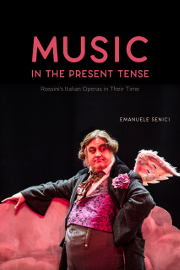 “In the early 1800s, Rossini’s operas permeated Italy, from the opera house to myriad arrangements heard in public and private. But after Rossini stopped composing, a sharp decline in popularity drove most of his works out of the repertory. In the past half century, they have made a spectacular return to operatic stages worldwide, but this recent fame has not been accompanied by a comparable critical reevaluation.
“In the early 1800s, Rossini’s operas permeated Italy, from the opera house to myriad arrangements heard in public and private. But after Rossini stopped composing, a sharp decline in popularity drove most of his works out of the repertory. In the past half century, they have made a spectacular return to operatic stages worldwide, but this recent fame has not been accompanied by a comparable critical reevaluation.
Emanuele Senici’s new book provides a fresh look at the motives behind the Rossinian furore and its aftermath by examining the composer’s works in the historical context in which they were conceived, performed, seen, heard, and discussed. Situating the operas firmly within the social practices, cultural formations, ideological currents, and political events of early nineteenth-century Italy, Senici reveals Rossini’s dramaturgy as a radically new and specifically Italian reaction to the epoch-making changes witnessed in Europe at the time. The first book-length study of Rossini’s Italian operas to appear in English, Music in the Present Tense exposes new ways to explore nineteenth-century music and addresses crucial issues in the history of modernity, such as trauma, repetition, and the healing power of theatricality.”
September 5, 2019
Louise Jeffreys to become Deputy Chair of ENO
English National Opera (ENO) is pleased to announce that Louise Jeffreys is to become Deputy Chair of English National Opera and the London Coliseum. She replaces Nicholas Allan.
Louise is currently Artistic Director of the Barbican where she leads the artistic marketing and media relation functions and is responsible for the formulation, implementation and delivery of the Barbican's artistic programme and strategic vision. She was previously Head of Theatre and Arts Projects at the Centre, programming and leading Barbican International Theatre Events (BITE) which became one of London's most innovative artistic programmes, presenting and co-commissioning leading international theatre, dance and opera.
Prior to the Barbican, her roles include Administrative Director at the Nottingham Playhouse, Head of Production at Bayerische Staatsoper, Munich, and Technical Director at the English National Opera.
Commenting on this appointment, ENO Chair, Dr Harry Brunjes says, “On behalf of all at ENO I was delighted when Louise Jeffreys accepted the role as Deputy Chair of English National Opera and the London Coliseum. Louise is respected and admired throughout the artistic community. The ENO will be enhanced by her knowledge, commitment and general common sense. "
"At the same time Louise will become Chair of the Artistic Committee. There is a certain resonance to this as Louise has spent a substantial part of her career at ENO. Louise is a wonderful colleague to work with and we are lucky to have her."
Louise Jeffreys adds, “It is a real privilege to take on this position. ENO is a company that has meant so much to me and I am excited to continue to play a role in this exciting and forward-thinking organisation, and supporting the wonderful executive team.”
image=http://www.operatoday.com/Louise%20Jeffreys.jpgSeptember 3, 2019
STRAUSS : Elektra
Music composed by Richard Strauss. Libretto by Hugo von Hofmannsthal .
First Performance: 25 January 1909, Opernhaus, Dresden
| Principal Characters: | |
| Klytemnestra, widow of Agamemnon | Mezzo Soprano |
| Elektra, daughter of Klytemnestra | Soprano |
| Chrysothemis, daughter of Klytemnestra | Soprano |
| Aegisth, Klytemnestra’s paramour | Tenor |
| Orest, son of Agamemnon and Klytemnestra | Baritone |
| Tutor to Orest | Baritone |
| Confidante of Klytemnestra | Soprano |
| Trainbearer of Klytemnestra | Soprano |
| Young Servant | Tenor |
| Old Servant | Bass |
| Overseer | Soprano |
| 1st Maid | Contralto |
| 2nd and 3rd Maids | 2 Mezzo Sopranos |
Setting: Ancient Mycenae
Synopsis:
Maids try to wash away the blood in the palace where Agamemnon was murdered by his wife Klytemnestra and her lover Aegisth. The princess Elektra, in dishevilled state, enters the courtyard for her daily ritual of lamenting her dead father. She swears vengeance and awaits the return of her brother Orest to enact the deed. Her sister Chrysothemis warns her of the royal couple’s plans to imprison Elektra and describes her yearning for motherhood. Elektra scorns her and, on hearing that Klytemnestra suffers nightmares of vengeance, is determined to confront their mother. Feigning a reconciliatory tone, Elektra gains Klytemnestra’s confidence, and they remember happier times when Agamemnon was alive. The Queen, plagued physically and mentally, begs her daughter to help but Elektra promises that only death can bring relief and describes how Agememnon’s murder will be avenged. Klytemnestra receives a message and leaves with joyous laughter. Chysothemis returns to tell Elektra that two strangers have arrived with news of the death of Orest. Elektra demands that the two sisters carry out the deed themselves but Chrysothemis refuses. Alone, Elektra digs up the axe that murdered her father. One of the strangers reveals himself as Orest, and brother and sister are reunited. Orest enters the palace and Klytemnestra’s death cries are heard. Aegisth returns and Elektra lights his way into the palace to meet his doom. As the court celebrates the return of Orest, Elektra dances in triumph and falls lifeless to the ground. Chrysothemis hammers on the closed doors of the palace calling her brother’s name.
[Synopsis Source: Boosey & Hawkes]
Click here for the complete libretto.
image=http://www.operatoday.com/1869_Frederic_Leighton_-_Electra_at_the_Tomb_of_Agamemnon.png image_description=Electra at the Tomb of Agamemnon by Frederic Leighton (1869) [Source: Wikipedia] audio=yes first_audio_name=Richard Strauss: Elektra first_audio_link=http://www.operatoday.com/Elektra1.m3u product=yes product_title=Richard Strauss: Elektra product_by=Ursula Schröder-Feinen (Elektra)Gwyneth Jones (Chrysothemis)
Christa Ludwig (Klytemnestra)
Theo Adam (Orest)
Hans Beirer (Aegisth)
Horst Stein (cond.)
Live performance: Wiener Staatsoper, 10 November 1977 product_id=Above: Electra at the Tomb of Agamemnon by Frederic Leighton (1869) [Source: Wikipedia]
La traviata at the Arena di Verona
The premiere was June 21. However Franco Zeffirelli had died on June 15 at 96 years of age. This, his final production, is a monument to the accomplishment of one of the great stage directors of the 20th century. He was a director who earned huge fame collaborating with diva Maria Callas at Covent Garden and Dallas, earning additional recognition in the U.S. for his spectacular productions of Aida and La boheme at the Met. Zeffirelli was a prominent participant in the Italian operatic establishment who, as well, was elected a senator in the Italian government, a member of Berlusconi’s Forza Italia.
The new Verona La traviata, of unimaginable magnitude, is nothing if not monumentally spectacular. Not an easy feat when you consider that La traviata happens in a couple of Parisian drawing rooms, the parlor of a country house and in a humble bedroom. It is a quite domestic melodrama.
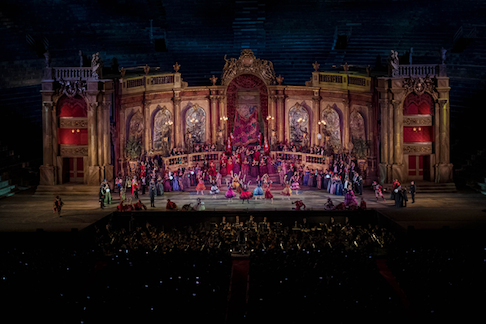 Act II, scene 2
Act II, scene 2
But even by Arena di Verona standards the Zeffirelli production holds its own scenically with the repertory’s greatest (most popular) public tragedies (Aida, Trovatore, Otello, etc). This is accomplished by the sheer size and amount of constructed scenery that you see when you enter the 2000 year-old arena. You are then astonished when a major transformation takes place a vista during the first intermission, and knocked over at the second intermission when it becomes yet another constructed space for the multitude(s) of guests and revellers at the gambling party, a multitude of dancers and musicians, and a bevy of acrobats (etcetera) who are having a great celebration until things get ugly (but only incidentally to the revelry).
It is fair, well obvious to say that opera at the Arena di Verona is opera as spectacle, not opera as theater. This explains the broad appeal of its productions, and the 13,500 spectators who fill it for each of the 42 performances of 4 operas this summer (there are eleven La traviata performances). The attraction for serious opera goers is the variety of artists. including the who’s who of the conductors and singers who perform on the world’s major stages. But the vast majority of the spectators are there for the spectacle, and to participate in this ancient Roman and now venerable Italian summer ritual.
Actually by Arena di Verona standards it is an intimate set as Mr. Zeffirelli’s set is always nothing more than a back wall that limits the action to the horizontal playing area in front of it, be it hundreds of feet wide. It is hard to say if this high wall significantly affected the acoustic. There was the surprising moment in the first act when Violetta and Alfredo climbed up to a cubicle built into the wall (an intimate room) when their voices took on far greater magnitude, perhaps a hint of the acoustic that extends sounds to the very far distant, always packed upper reaches of the arena.
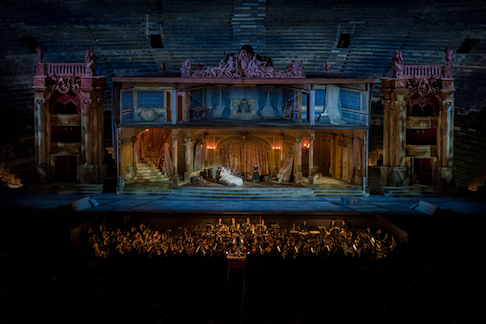 Act III, Violetta in white
Act III, Violetta in white
Italian conductor Daniel Oren conducted the performance I heard, keeping the orchestral and choral forces in check, and working with the singers to achieve maximum vocal projection while respecting their usually considerable artistry. This was particularly evident in the beautifully schooled Violetta of American (Louisiana) soprano Lisette Oropesa (one of four Violettas). The previous summer Mlle. Oropesa sang the title role in Rossini’s Adina in the 850 seat Teatro Rossini in Pesaro, thus it was quite a step up to sing Violetta in Verona. Her very beautifully phrased Violetta was not of sufficient magnitude to capture the hearts of 13,000 plus spectators though they dutifully applauded.
77 year-old Leo Nucci sang Germont (one of five Germonts for the run, including Placido Domingo). At this point one admires his old-school style rather than lament the ravages of time on a once beautiful voice. Maestro Oren is greatly appreciative of his singers (after an aria he always applauds them with the rest of us), and for Mr. Nucci he went wild. Italian (Arezzo) tenor Raffaele Abete (one of four that included Vittorio Grigolo) sang Alfredo. Mr. Abete, recent winner of a Arena di Verona sponsored voice competition, confused strutting with acting and substituted energy for phrasing thus erasing all effect his fine tenor voice may have made.
The opera festival at the Arena di Verona has been around for more than 100 years! That it is a marvel of production and a masterpiece of crowd control only magnifies the magic it has created at every performance I have attended over the years.
Michael Milenski
Cast and production information:
Violetta Valéry: Lisette Oropesa; Flora Bervoix: Clarissa Leonardi; Annina: Daniela Mazzucato; Alfredo Germont: Rafaele Abete; Giorgio Germont: Leo Nucci; Gastone: Marcello Nardis; Barone Douphol: Nicolò Ceriani; Marchese d’Obigny: Dario Giorgelè; Dottor Grenvil: Alessandro Spina; Giuseppe: Max René Cosotti. Arena di Verona Orchestra, Chorus and Corps de Ballet. Conductor: Daniel Oren; Metteur en scène: and Set design: Franco Zeffirelli; Costumes: Maurizio Millenotti; Choreographer: Giuseppe Picone; Lighting design: Paolo Mazzon. Arena di Verona, Italy, August 17, 2019.
image=http://www.operatoday.com/Traviata_Verona4.png
image_description=
product=yes
product_title=La traviata at the Arena di Verona
product_by=A review by Michael Milenski
product_id=Above: A few of the dancers and musicians at Flora's party
All photos b©Ph. Ennevi/Fondazione Arena di Verona.
Sir John Eliot Gardiner brings Benvenuto Cellini to the Proms
Chelsea Opera Group has performed it at least twice, Sir Colin Davis
persuaded the London Symphony Orchestra to produce it in concert not once,
but twice, and I am sure there are other performances I have missed.
Counting stagings in Amsterdam (by Tim Albery in the 1990s) and Strasbourg,
I have seen the opera eight times, not bad for such a rarity.
The way that Benvenuto Cellini continues in the repertoire, in
some form, is perhaps an indication of the affection with which the piece
is held; despite the difficulty of the music and the craziness of the
dramaturgy, the work's sheer invention, imagination and energy carry you
away. Sir John Eliot Gardiner continued the tradition by bringing his
concert staging of Berlioz' Benvenuto Cellini to the BBC Proms.
Benvenuto Cellini has a complex textual history, Berlioz wrote it in 1836 and it was performed at the Paris Opera in 1838 but was not well received and only received five performances. From there it languished until Franz Liszt put the work on in Weimar in 1852 with Berlioz extensively revising it and Liszt suggesting cuts. From 1838 we can trace at least three versions, two of which are reconstructed and recorded, the opera as Berlioz first wrote it, before it went to the censors, the opera as first performed by the Paris Opera and the work as recorded in the Paris Opera archives after Berlioz' further cuts during its run at the Opera, as he tried to salvage what he could from a disastrous run. Another problem when producing the Weimar version is that Berlioz' revisions are mixed up with Liszt's swinging cuts designed to bring the running time into something acceptable. All this means that each performance takes its own route through the textual maze; the original version is full of good things which Berlioz later cut but is also a sprawling mess in dramatic terms.
In fact, there is one more version of the opera! Berlioz original plan was for an opera comique, but it was turned down so when approaching the Paris Opera with the idea the spoken dialogue had to be dropped. But the French vocal score was published with cues marking the dialogue, and a revival with dialogue, was planned at the Théâtre-Lyrique in l856 (though this did not happen).
At the BBC Proms, John Eliot Gardiner made his own selection (based on Hugh Macdonald's critical edition), so what we heard was 1838 with some elements of 1852. The result was long and full of felicitous detail omitted in the 1852 version, and had moments which were truly delightful but which, frankly, held up the action. But then, if one wanted tight, focused drama one would not listen to Benvenuto Cellini; its charms are those of the sprawling, riotous carnival which it depicts at the end of Act One. Hugh Macdonald's 1966 article on the Hector Berlioz website aptly sums up the differences between the various versions.
The title role is impossible. The first Benvenuto Cellini, Gilbert Duprez (who created Edgardo in Donizetti's Lucia di Lammermoor and who was the first tenor to use chest voice for Arnold's top C in Rossini's Guillaume Tell) hated it. The role calls for flexibility, strength, stamina (the 1838 version is a long sing) and an ease in the high register, combined with a sense of comedy! No wonder opera companies shy away from it. The first Benvenuto Cellini in the revised, 1852 Weimar version was the first Lohengrin which perhaps indicates the direction some of the 1852 changes were going.
At ENO in 2014 Michael Spyres had already shown that he is in many ways the ideal protagonist: he has sung a lot of early 19th century French opera, can cope with the devilish complexity of Berlioz' writing and is an apt comedian. The whole of the first scene in Act One was delightful, as Spyres despatched Berlioz’ music with style, wooed Teresa with sly charm and was rather funny. His narration of his escape during the first scene of Act Two was equally fun, and you could appreciate Spyres’ attention to the words, always important in this work.
There were some profoundly beautiful moments too, notably Cellini's Act Two solo when he sings of the simple life, but in some later high passages we were also aware of Spyres managing his voice. This was his third performance in the role in five days: the production had been seen at the Festival Berlioz, La Côte-St-André on 29 August, and the Berliner Festspiele, Berlin on 31 August, and travels to the Opéra Royal, Palace of Versailles next Sunday. That is quite a punishing schedule for such a taxing opera.
The beauty of Spyres’ performance was that he wasn't just a comedian, but also brought out Cellini as the serious artist as well, and he really made the most of the quite full version of the piece that we heard, making all the felicitous details count. We were really rooting for him, so that the final casting scene was edge of the seat stuff, in all the best ways.
Sophia Burgos made a delightful Teresa. Perhaps her voice was slightly small for the Royal Albert Hall, but then this is hardly the best venue for Berlioz' serio-comic opera. Burgos combined dextrous facility in the vocal writing with immense charm and a strong sense of character, which made her anything but a passive victim. She and Spyres made a fine pairing, particularly in the Act One love duet, and her solo in Act Two (when, in Cellini's absence Teresa has to cope with the workmen going on strike) showed Burgos' real metal. This is not an easy role to sing, and the great virtue of Burgos' performance was that we forgot the difficulty of the music and simply enjoyed her warmth and charm.
Fieramosca, the Pope's official sculptor and Cellini's rival suitor for Teresa's hand, is technically a comic role - he is perpetually the butt of Cellini's manoeuvrings and always seems to come of worse. I have always loved the Act One trio, where Cellini instructs Teresa about the plans for tomorrow's carnival, and then when they repeat them, Berlioz adds a third line for Fieramosca who is now listening. It is very funny, and dazzling musically, and perhaps sums up Benvenuto Cellini. Lionel Lhote made Fieramosca a wonderfully funny character, a hapless schemer who always failed, but he brought rumpled charm to the role and had the right sort of presence to be threatening too, and he sang very finely indeed. This was no buffo bumbling, but Berlioz' high baritone line beautifully and dextrously sung.
The smaller roles are also highly important in this opera, and there is a strong ensemble element to the piece requiring a well-balanced cast. At the Royal Albert Hall we had a series of well-drawn characters, but also a sense of ensemble too.
Adèle Charvet was a charming Ascanio, complete with a fine youthful swagger. Ascanio is not a huge role, but Charvet gave the young man strong personality, and she made the most of her delightful (yet dramatically redundant) Act Two aria. Maurizio Muraro was a finely comic, very buffo Balducci (Muraro was a last-minute replacement for Matthew Rose). Tareq Nazmi was very funny indeed as the Pope, here a frankly comic character prone to falling asleep. Ashley Riches and Vincent Delhoume (repacing Krystian Adam) were Cellini's co-workers Bernardino and Francesco, always popping up and contributing much by their double act. Peter Davoren and Alex Ashworth (both from the Monteverdi Choir) provided finely comic cameos as the Innkeeper and Pompeo.
The staging by Noa Naamat was simple but effective, and she did not shy away from any of the librettos requirements, so we had a carnival scene, and we had the casting of Perseus (though embodying the statue on stage in the person of Duncan Meadows was perhaps unnecessary). Essential to this was the Monteverdi Choir which sang with focused dexterity and power, yet also entered with a will into the whole of the action, erupting on stage during the carnival.
The whole performance had a rhythmic tightness and brilliance which belied the music's complexity and Gardiner's speeds certainly took no prisoners so that the Carnival scene was completely dazzling in many ways as choir, soloists and orchestra articulated Berlioz' busy and complex rhythms whilst keeping the whole sparkling and fun. The finale, with the casting of Perseus, was equally devastating.
It was here and in other moments that we could really appreciate the period instruments. The narrow bore brass, including cornets as well as trumpets, and an ophecleide (!) made a strongly characterful impression without overbalancing in the way can happen with modern instruments and the period wind (with four bassoons) were similarly characterful and colourful. And it was this sense of a wider range of colour that we took away from the performance, something that Gardiner seemed to relish. The period strings were lighter in colour and far less dominant in the busy passages, making the whole full of lovely detail, which meant we could appreciate the sheer skill of all the performers.
This was a performance which positively sped by, the sprawling drama overflowed the whole Royal Albert Hall stage and erupted in a carnival of delightful moments, but Sir John Eliot Gardiner kept things flowing and moving, always aware of the need for pacing and the importance of making the details build into something greater. Whilst Michael Spyres charming rogue was at the centre, this was a finely balanced ensemble cast which made this most tricky yet engaging a complete delight.
The performance is on BBC iPlayer for 30 days .
Robert Hugill
Benvenuto Cellini - Michael Spyres, Teresa - Sophia Burgos, Balducci - Maurizio Muraro, Pope Clement VII - Tareq Nazmi, Francesco - Vincent Delhoume, Fieramosca - Lionel Lhote, Ascanio - Adèle Charvet, Bernardino - Ashley Riches, Perseus - Duncan Meadows, Pompeo - Alex Ashworth, Innkeeper - Peter Davoren; Director - Noa Naamat, Conductor - Sir John Eliot Gardiner, Lighting Designer - Rick Fisher, Costume Designer - Sarah Denise Cordery, Monteverdi Choir, Orchestre Révolutionnaire et Romantique.
BBC Proms at the Royal Albert Hall, London; Monday 2nd September 2019.
image=http://www.operatoday.com/Benvenuto%20Cellini%20title.JPG image_description= product=yes product_title=Prom 59: Berlioz’ Benvenuto Cellini - Monteverdi Choir and Orchestre Révolutionnaire et Romantique, conducted by Sir John Eliot Gardiner product_by=A review by Robert Hugill product_id=Photo credit: BBC/Chris ChristodoulouSeptember 2, 2019
Prom 58: varied narratives from the BBCSSO and Ilan Volkov
After two capacity-audience Proms earlier this season under their Chief Conductor Thomas Dausgaard, the BBC Scottish Symphony Orchestra returned to the Royal Albert Hall for an inventively programmed concert conducted by Ilan Volkov, their Principal Guest Conductor, in which ‘narratives’ of various kinds were to the fore.
Karol Szymanowski turned to Persian mysticism for his orchestral song-cycle, Love Songs of Hafiz Op.26 ( Pieꞩni miłosne Hafiza), his interest in the poet from Shiraz having been awakened when he came across a volume of Hans Bethge’s translations of Hafiz’ poetry during a visit to Vienna in spring 1911. And, though the presence of oriental elements in Szymanowski’s music is indicative of the general aesthetic interest in ‘The Orient’ evident in the work of Western artists working in diverse spheres at the turn of the 20 th century, the texts chosen for this cycle, and those of Rumi that found a more ‘religiously elevated’ expression in Szymanowski’s Third Symphony, suggest that the composer responded in a deeply personal way to the Sufi concept of a union with God through the ecstatic experience that they offered.
Szymanowski’s ‘orientalism’ is more instinctive than scientific and is integrated in these songs within a markedly eclectic range of influences. Following the death of his father in 1904, Szymanowski had spent seven years travelling through Europe and North Africa, but while some argue that the influence of the muezzins’ calls to prayer that he heard in Tunisia can be detected in Songs of the Infatuated Muezzin Op.42 (1918, Pieśni muezina szalonego) there is no evidence from the composer’s musical notebooks of any direct recording or transcription. Rather, one senses a more delicate infusion of oriental colour, gesture and harmony into a heady mix of Wagnerian melopoeia, the infinitely extended yearning for fulfilment of Straussian Romanticism, and an Impressionist interplay of colour and light tinged with Arabian modes and tropes - forming a heady perfume designed to capture the elusive erotic power of Hafiz’ poetry.
American soprano Georgia Jarman displayed the same freely soaring lyricism and sumptuous richness that I admired in 2015 when she performed the role of Roxana in the ROH’s Król Roger . Her powerful soprano luxuriated in the orchestral luminosity, sinking in, sailing above. Perhaps there was not the sort of detailed attention to the text that a lieder singer might offer, but the sensuality of the sound was more than recompense, and was complemented by rapturous orchestral textures, as at the opening of the first song, ‘Desires’, where divided strings, two harps, piano, celeste and woodwind created a shimmering, scintillating bed of sound above which Jarman floated a pure expression of longing: “I wish I were a lake’s clear depths/and you were the sunlight playing on the waves.” Volkov sustained a transparent, magical quality, as if the music were an elixir, designed to transfix.
The falling glissandi of ‘The Infatuated East Wind’ segued into a swaying, teasing dance, as Jarman conveyed the solipsistic self-indulgence of the poet-speaker’s reveries and delighted in the ecstatic Straussian swoops. The delicate playout of harps, celeste and horn transmuted into the timpani’s urgent tattoo in ‘Dance’: there was a barely repressed, almost menacing, erotic pulse here, which was not quelled until the stillness of ‘Pearls of My Soul’, in which piano, celeste, bells and solo violin conjured the pearl’s precious, shining halo with exquisite loveliness, its glimmer ever more intoxicating as low clarinet trills, muted horn pedals and solo string pizzicatos hypnotised us in this strange land, until Jarman’s soprano found release in an effortlessly floated top Bb which teasingly dipped a semitone in a closing curl: “I would cast their snowy riches at your flighty little feet!”
Volkov established an impassioned restlessness in ‘Eternal Youth’ as Jarman’s wide-spanning vocal shapes evoked the youthful passion burning in the old poet’s heart. A horn melody that might have come from the pen of Richard Strauss closed this song, while a meandering clarinet solo that might have floated over sandy Arabian plains peeked through the instrumental oscillations and trembles propelling ‘Your Voice’ to its rhapsodic heights. The brazen ‘Drinking Song’ - all rude nose-thumbs from piccolo flute and clarinet, defiant trombones, spiky pizzicatos and reckless piano tumbles - also brought Strauss to mind: the merry pranks of one Till Eulenspiegel this time. Volkov encouraged the horns’ shamelessness, while keeping the orchestral exploits under control, and Jarman had no trouble imposing her own irrepressible eulogy, “Wine’s spell is life! Fill my cup!”
With ‘Hafiz’ Grave’, decorum was re-imposed, giving the first flute, oboe and clarinet, and leader Laura Samuel a chance to sing their own sad, strange song, and bringing the cycle to rest in mystery and mysticism, with a transfiguring image of the flowers on Hafiz’ grave, “perfumed like a rose garden”.
Leoš Janáček was no stranger to storytelling, not only in his operas but also through instrumental means, without words, in his string quartets and symphonic poems. The Fiddler’s Child (1913), subtitled a ‘ballad for orchestra’, was introduced to the UK by Henry Wood in 1924, but this was its first hearing at the Proms. Though based on a poem by Svatopluk Čech (the librettist of The Excursions of Mr Brouček to the Moon), and while the composer’s notes identify specific instruments with characters in the text, Janáček didn’t hesitate to rearrange the musical narrative to suit his own purpose.
Čech’s tale tells of an interaction between the supernatural and the living: an old village fiddler dies, leaving a child to be cared for by the village. The old woman charged with the task, hangs the fiddle on the wall of her cottage. One night she is awakened by a vision of the fiddler who sings to his child, enticing him with promises of happiness in the heavens. The woman makes a sign of the cross and falls asleep again. In the morning the child is found dead, the fiddle gone. The tripartite structure is ignored by Janáček who focuses not on the individuals but on the social milieu and concerns. There is no depiction of the old woman or her climactic nocturnal awakening; instead the suffering of the villagers dominates the score, expressed by the divided violas - here placed to Volkov’s right and offering some Romantic fullness in an otherwise lean and dramatic reading. Volkov drew forth the melancholy and the bitterness of the score, the latter present in the depiction of the omnipresent and all-powerful magistrate by the lower strings, bass clarinet and trombone. Volkov’s reading was confident and well-shaped; and The Fiddler’s Child offered us a welcome opportunity to hear Laura Samuel impersonate the dead fiddler whose reflections - by turns solemn, angry and, briefly, bright and hopeful - permeate the entire score. Playing with brusque energy and spiritedness, Samuel was a persuasive guide through the tale.
It’s a brave composer who entitles one of their works Nuages, so directly does the word point one to the first of Debussy’s Nocturnes. Like Debussy, Linda Catlin Smith is, in her own words, interested in ‘harmony, melody and timbre. I want to create music that is intimate and reflective … slow music allows greater complexity in terms of harmony, at least to my ear. I think of slower music as a way of steeping oneself in thought’. Unlike Debussy, though, to judge by Nuages, she is less interested in rhythm and form. This fifteen-minute symphonic poem unfolded (drifted?) with a delicate dreaminess - all divisi gentleness, tender gestures, fragments of melody - alleviated by occasional intimations of energy and purpose: percussive rolls, a tuba theme, pizzicato vividness.
Again, Smith’s own words encapsulate as well as any others her intent and effect of the orchestral ‘clouds’: ‘the veiled haze of strings, tangled thicket of woodwinds, or soft fog of percussion. I was interested in a quiet lushness, as in the weaving of light and shade in an overgrown garden; occasionally the work completely thins out, like a clearing in the surroundings, a pause in thought.’ If the resultant meandering shifts lacked any clear form or direction, it was not the case that they did not intimate a narrative of sorts - albeit a rather ineffable one that unfolded with protean elusiveness but not without moments of captivating coloristic beauty.
The ‘narrative’, if we may call it that, in Tchaikovsky’s Second Symphony is of a national and personal nature: completed in 1872, the ‘Little Russian’ was Tchaikovsky’s attempt to find his own symphonic voice by producing a nationalist work in the manner of the Might Five - and commentators have identified his use of three Ukrainian folk tunes, ‘Down by Mother Volga’, ‘Spin O My Spinner’, and ‘The Crane’, though often the melodic idiom is more characterised by folky gestures than by direct quotation.
Volkov led the BBCSSO in a performance of conviction and colour: indeed, the positioning of the eight double basses on a raised tier behind the woodwind seemed a declaration of belief and the BBCSSO played with vigour and flair. Both textures and tempi were balanced, and Volkov kept the emphasis on forward movement rather than weightiness. The Scherzo had plenty of character, while the final Allegro vivace was athletic and exuberant - though perhaps Volkov might have let the percussionists off the leash a little more at the close so that gong, cymbals, bass drum and timpani could really romp flamboyantly home. The string tone was appealing and, if not radiantly Romantic, then rounded and clean, while there some lovely eloquent woodwind playing in the Andantino marziale.
Perhaps the disappointingly numerous empty seats at the RAH were a result of the various transport issues that weekend for those travelling to and from the capital; or perhaps this interesting programme seemed too ‘rarified’ and unfamiliar for some? But, this was an unwaveringly engaging performance from the BBCSSO and Volkov. It was a pity that too many in the Hall could not restrain their coughing and shuffling so that we could enjoy it in a fittingly respectful manner.
Claire Seymour
Prom 58: Linda Catlin Smith: Nuages (BBC commission: world premiere), Janáček - The Fiddlers Child (Henry Wood Novelties: UK premiere, 1924), Szymanowski - Love Songs of Hafiz Op.26, Tchaikovsky - Symphony No.2 in C minor Op.17 (‘Little Russian’)
Georgia Jarman (soprano), Ilan Volkov (conductor), BBC Scottish Symphony Orchestra
Royal Albert Hall, South Kensington, London; Sunday 1st September 2019.
image=http://www.operatoday.com/GeorgiaJarman_Claire%20McAdams.jpg image_description= product=yes product_title=Prom 58: The BBC Scottish Symphony Orchestra conducted by Ilan Volkov product_by=A review by Claire Seymour product_id=Above: Georgia JarmanPhoto credit: Claire McAdams
Prom 53: Elgar’s emotionally charged Music Makers
The thematic link between Vaughan Williams’sFantasia on a Theme by Thomas Tallis and Hugh Wood’s Scenes from Comus might be simply reduced to sonority - a fascinating juxtaposition of seamlessly interwoven string forces in one, and an electrifying alchemy of ever-shifting full orchestral timbres in the other, their differences adroitly delineated by Sir Andrew Davis in readings of warmth and precision.
The Fantasia began out of nowhere, wonderfully svelte with Davis sculpting the air and fashioning handsome playing from the BBC Symphony Orchestra that encompassed majesty and mystery. Its muted smaller ensemble at the rear of the stage was daringly quiet but flawlessly integrated into the bigger picture - everything detail glowing with affection as if the players were shaking hands with a much-loved friend. One could almost imagine we were in the sacred space of Gloucester Cathedral where the work was first performed and where its organist once described Vaughan Williams as “a queer, mad fellow from Chelsea”.
A similar sense of intensity and nobility emerged from Hugh Wood’s Scenes from Comus. It’s part-cantata and part-orchestral tone poem with vocal soloists, setting passages from John Milton’s 1634 Masque. Its first appearance at the Proms in 1965 brought the composer valuable exposure and wide public acclaim. This captivating account was launched by Martin Owen’s fluent horn solo - the work’s opening tone row indicative of much that was to follow in a score embracing serialism yet revealing an expressionistic lyrical strain embedded in a Romantic sensibility. While Schoenberg was a major stimulus, other influences come into play most notably in an extended orchestral episode evoking the monstrous Comus (son of the witch Circe) who invites his followers to join “a light fantastic round”. It’s a tour de force of orchestral writing to which the orchestra responded with magnificent playing, conjuring its orgiastic dance with fierce commitment and evident enjoyment. There was much to enjoy too from soprano Stacey Tappan and tenor Anthony Gregory whose clear voices and fluent traversal of the work’s demands made them ideal advocates, even if on occasion the sheer weight of orchestral sound pitted against them was not to their advantage.
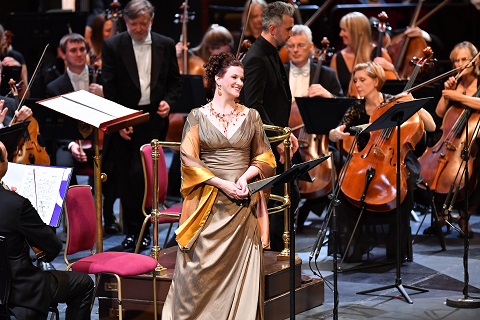 Stacey Tappan. Photo credit: BBC/Chris Christodoulou.
Stacey Tappan. Photo credit: BBC/Chris Christodoulou.
Where Scenes from Comus arises from the beginning of Wood’s musically creative outpouring, The Music Makers (1912) was to be one of Elgar’s last works for choir and orchestra and has been unjustly overlooked. Setting Arthur O’Shaughnessy’s Ode for a contralto soloist, it’s sometimes regarded as a problematic work in that the newly composed themes rarely achieve the same memorable status as the patchwork of quotations (most notably drawn from the ‘Enigma’ Variations) and, arguably, suggests a diminishing imagination. Critical assessment has not been helped by Elgar’s biographer Diana McVeigh’s patronising comment on The Music Makers as being a “pleasant work to sing but not quite so satisfying to listen to”.
While O’Shaughnessy’s fanciful text is not always rewarding (“With wonderful deathless ditties we build up the world’s great cities” being especially lame), this scrupulously prepared performance with the BBC Symphony Chorus and a radiant Dame Sarah Connolly made a compelling case for this cantata. The opening lines “We are the music-makers, and we are the dreamers of dreams” were sung with a rapt beauty and conveyed with deep involvement. True, the pianissimo marking was ignored (not so on the superb Chandos recording) but the words were clearly enunciated and shaped. Thereafter, Davis drove the score forward, rarely allowing its momentum to falter and seamlessly interrogating tempo variations, shaping its paragraphs with assurance and building from “for we fashion an empire’s glory” to a grandiose climax. Connolly imposed with warmly expressive tone, and if the upper register didn’t quite have same easy control and richness as her voice below the stave, she sang with a total immersion in the text that compels attention. Nowhere was her singing so poignant as the closing lines; “And a singer who sings no more” - its emotional charge shattering.
David Truslove
Dame Sarah Connolly (mezzo), Stacey Tappan (soprano), Anthony Gregory (tenor), Sir Andrew Davis (conductor), BBC Symphony Orchestra, BBC Symphony Chorus
Royal Albert Hall, London; Thursday 29th August 2019.
image= http://www.operatoday.com/Dame%20Sarah%20Connolly.jpg image_description= product=yes product_title=Prom 53: An evening of English music from Sir Andrew Davies and the BBC Symphony Orchestra and Chorus product_by=A review by David Truslove product_id=Above: Dame Sarah ConnollyPhoto credit: BBC/Chris Christodoulou
September 1, 2019
Scoring a Century: British Youth Opera at the Peacock Theatre
So wrote David Blake in an essay, ‘Recollections’, published in 1995 in Hanns Eisler: A Miscellany, of which Blake was editor. The same might be said of Scoring A Century, a ‘comic opera’ in twenty ‘panels’, in which Blake and his librettist Keith Warner set out to trace one hundred years of the changing cultural, musical, political and economic landscape by charting the 20th-century progress of Mr and Mrs Jedermann, a pair of song-and-dance Everymen, as they stumble their way through the significant events and epochs of the 20th century. The Jedermanns - ageless, guileless and, one might say, clueless - are intellectual and ideological tabula rasas: clean slates upon which others can etch their own beliefs, systems, hypocrisies and muddles … though the scratches don’t make deep in-roads - the Jedermanns grow more experienced but not necessarily any the wiser.
Scoring a Century was a millennial project. After some scenes were workshopped by the University of York Music Department in November 1999, the premiere of the complete work was planned for Portland, Oregon. Ironically, a work which set out to define the 20th century was derailed by an event which will surely be seen as one of the defining moments of the following century: the 9/11 terrorist attack. The planned premiere was withdrawn and, following a subsequent cancellation in Dublin, it was a decade before Scoring a Century received its first full performance, in the Crescent Theatre at the Birmingham Conservatoire in March 2010, directed by Warner and conducted by Lionel Friend, then conductor-in-residence at the Conservatoire.
With a cast of twenty-plus performing over fifty named roles and ensemble-groups of gangsters, jury members, political protesters, secret agents and dock workers, Scoring a Century is an ideal work for a large collective of young singers to exercise their talents and demonstrate their range, and thus an apt choice for one of British Youth Opera’s 2019 summer productions at the Peacock Theatre. Warner and Friend have teamed up again and they’ve clearly put the cast through their paces: the results of the obvious hard work are, as Blake said of Eisler, both ‘stimulating’ and somewhat ‘exhausting’!
If the cast work hard, then Scoring a Century also makes considerable intellectual, imaginative and aural demands on its audience. Warner has described the opera as “a low entertainment for high brows, or vice versa”, but this clear-cut opposition is in fact under-cut by the complexity and intricacy of the conception. The sequence of tableaux burst with hyperactive allusiveness and detail, but sometimes progress with a disjointed leisureliness. The transitions are not always smooth, and I struggled at times to both rapidly absorb a wealth of cultural references and maintain an attentive engagement as the chronological arc unfolded. The challenge for Warner and Blake is to allow time for us to take in what’s happening in the moment and to keep the flow of history moving, so that we can appreciated how humans instigate, are caught up in, and respond to historical events.
That said, the metatheatrical complexity of the piece was balanced at the Peacock Theatre by a winning simplicity of design. Eighteen history-travelling panels are framed by an introduction and farewell: an all-dancing, all-singing review number, ‘This is/was our Show’. As the Jedermanns perform their way through history, their purpose is only to entertain … so they say. As time ticks by, they pass through a series of door-panels which swivel to reveal emblems or titles which confirm time and place; they are edged with a stitch-like trim - white on black, black on white - which suggests both a railway track on which the wheels of the history-wagon roll, and the stitching together of the disparate parts into a seamless whole.
The economy of the staging and the witty use of a multitude of props and furniture pieces effectively establishes setting and situation, while the descent of a proscenium further frames four ‘operas-within-the opera’. The lighting is atmospheric and dramatic, and costumes are absolutely terrific, recreating an astounding number of sartorial styles - and demanding lightning-crack changes: one presumes that the back-stage team must have been working up a sweat too. In a memorable visual coup, the sudden arrival of the psychedelic ’60s - all yellow flares and clashing florals - was, after the previously prevailing black, white and grey, a shock to the eyes comparable to the moral outrage felt by conservatives at the time.
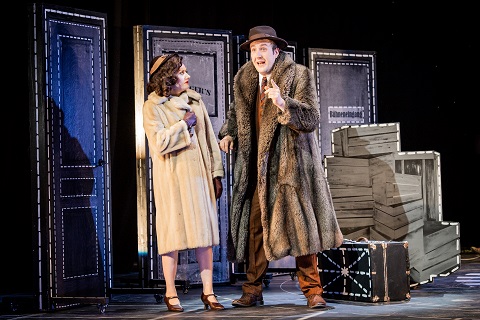 Holly Marie Bingham and Hugo Herman-Wilson. Photo credit: Robert Workman.
Holly Marie Bingham and Hugo Herman-Wilson. Photo credit: Robert Workman.
The Jedermanns (Hugo Herman-Wilson and Holly Marie Bingham) start out in 1901 as a support act at the Pier Theatre in Trouville, dreaming of the utopian future - world peace, a man on the moon. But, their fin de siècle optimism soon takes its first knock when we are introduced to the resident composer: the ambitious Berthold (Florian Panzieri) - his name wryly references to Berthold Goldschmidt, a German-born Jewish composer who had to wait until his eighties to achieve recognition and renown - whose first mini-opera, the hubristically titled ‘Playing God’, is set in the trenches of the Somme, where we see a Sergeant (Andrew Hamilton) play his part in defying death by deliberately disabling a young Private (Laurie Slavin) with a Blighty.
By the 1920s, relief that WW1 is over has given way to resentment about economic adversity: a concert party featuring the heroes of Versailles (Clemenceau, Woodrow Wilson and Lloyd George, played by Panzieri, Guy Elliot and Christopher Dollins respectively) is dampened by the threat of unemployment. The Jedermanns’ party seems over, but they adapt to the times and circumstances, heading to 1930s Spain where Mrs Jedermann tries her hand in the movies, playing a gangster’s moll. There’s no time to sentimentalise the death of their son (Laurie Slavin) in the Spanish Civil War, and in 1938 the Jedermanns set off for Berlin, where Ernest dallies with the chantreuse Tartine (Joanna Harries). By now, the action feels quite breathless as Warner piles up witty one-liners and cultural references in an almost overwhelming intellectual tapestry. There’s little alleviation of the prevailing feverishly thespian mode either, with gestures grand and melodramatic, and few excursions into a more ‘realistic’ style, even in the sections of spoken dialogue. At times I did wonder if less might have been more.
Berthold’s second mini-opera provides a brief pause and musical expansiveness though: the daily vigil of a couple who wait on a railway platform for their son, a POW, to return home offers a pathos which is enhanced by Blake’s expressive writing; the score is ably shaped by Friend and performed with style by the 27-strong Southbank Sinfonia. The couple receive a package: inside is a tape of their son’s last words, “They are not inhuman here”. A gunshot tells a different story.
Having travelled to Russia, in one of the strongest panels the Jedermanns find themselves both respondents in a Soviet show trial and standing before the House Un-American Activities Committee, simultaneously accused of Capitalism and Communism. The split-stage design generated terrific tension: found guilty and sentenced to ten years in Siberia/New York, “Onwards” Jedermann declared with characteristically innocent hopefulness.
Post-interval panels swept us through 1960s hippiedom and political protests, and revealed the medical advances which enable the aging Berthold to sustain his creative fecundity: in his next mini-opera, three masked female agents (Emily Christina Loftus, Amie Foon and Judith Le Breuilly) psychologically torment a male hostage accused of moral turpitude.
The panoply of cultural references - popular and erudite - continues to pile up: Warner even incorporates some wry self-irony, when Berthold bitterly recalls the directorial conceptualisations which have ‘ruined’ his operas. The monetarist dream of the 1980s becomes a ballad naively eulogising the “trickle-down” effect. I confess, that I found the final panels rather laboured - particularly when the Jedermanns found themselves in the Los Angeles casting agency of talent- spotter Benny Blumenkohl, and with their subsequent arrival in the studio where they are to film a 1999 New Year’s Eve TV special. But, the Jedermanns’ progress offers Blake the opportunity to demonstrate his dexterity in diverse idioms - cabaret, music hall, musical theatre, popular music, and opera - which merge into and with his own musical language (primarily in the mini-operas) and other classical pastiches.
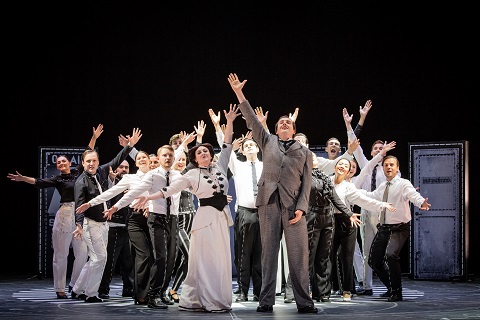 British Youth Opera, Ensemble. Photo credit: Robert Workman.
British Youth Opera, Ensemble. Photo credit: Robert Workman.
Scoring a Century is an ensemble piece and given the collective commitment and accomplishment - and the consistently clear diction, spoken and sung - it seems unfair to select individuals for praise. But, as the central pair, the every youthful Jedermanns, Hugo Herman-Wilson and Holly Marie Bingham were astonishingly convincing and meticulous. When I saw Herman-Wilson perform the part of Quince in the Royal College of Music’s 2018 A Midsummer Night’s Dream he was, by coincidence, similarly stranded in a play-within-a-play, striving valiantly to make sense of the seemingly senseless. Here, to dramatic naturalness the baritone added the ability to switch between idioms with ease, and to employ a soothing, soft lyricism to inject moments of touching expressive sentiment. As composer Berthold, Florian Panzieri displayed theatrical panache, successfully skirting the slippery slope of overkill.
Having reached the millennium, what lies ahead for the Jedermanns? A nostalgic duet looks back at the good old days: they are confused by a world run by technological media and threatened by global warming. ‘That was our Show’ chorus the ensemble, closing the theatrical frame: and, the door to the future - literally and figuratively - remains closed to Jedermann.
“Nothing is important,” the Jedermanns have declared. So, what to make of this chronological mosaic which was simultaneously playfully insouciant and pointedly insightful? To return to my beginning, some post-show reflection brought me back to Eisler, a Marxist, who had studied with Schoenberg, and with whom Blake himself studied at the Academy of Arts in Berlin. This isn’t the place for a detailed exploration of Eisler’s theories and practice, but in an article, ‘A Musical Journey Through America’, he condemns the ‘factory-like’ system of specialisation within the Hollywood studio, with individuals (condemned to the ‘prospect of becoming hopelessly dim-witted’) forced to churn out prescribed genres: one does Viennese waltzes’ another ‘military marches’, one dance music, another only jazz.
If Hollywood manufactured art for the sake of entertainment then elitists who believed only in art for art’s sake were no better, in Eisler’s view. ‘Hits’ were, according to Eisler (in ‘Hollywood Seen from the Left’), ‘musical numbers that you can sing before you have even heard them’, an idea that he and Theodor Adorno revisited in 1947, in their dissection of the relationship between film music and the Hollywood film industry, Composing for the Films, in which Eisler lamented the failure of the latter to exploit film’s potential to serve as a political tool to educate the proletariat.
Considered in this context, the Jedermanns’ musically and politically adaptable-cum-opportunistic progress through the performance idioms of the 20th century might be considered an Eisler-influenced cinematic-musical montage which, through meta-theatrical irony, exposes the falsity of the Jedermanns’ “nothing is important”. Perhaps Scoring a Century is both an example and critique of the uncontainable multiplicity and parity of cultural paradigms which the opera itself embodies: an exemplification of the collapse of grand narratives. Exciting or terrifying? - well, I guess that one has to decide for oneself.
Claire Seymour
British Youth Opera - Scoring A Century: David Blake (composer), Keith Warner (librettist/director), Lionel Friend (conductor), Basia Bińkowska (set designer), Jasmine Swan (costume designer), John Bishop (lighting designer), Mandy Demetriou (movement director).
Peacock Theatre, London; Saturday 31st August 2019.
image=http://www.operatoday.com/Scoring%20a%20Century.jpg image_description= product=yes product_title=Scoring the Century: British Youth Opera at the Peacock Theatre product_by=A review by Claire Seymour